Request Letters

Funding Request Letter (Format & Sample)
Acquiring a fund donor is a significant part of any project. Therefore, it is paramount that you know how to write an effective funding request letter or application. You need to compose a message that inspires the recipient and proves that you deserve their money. You also need to convince them that you plan to put the funds to good use.
Are you looking to reach potential donors? Here is how to draft a savvy request letter for funding.
Researching for Your Funding Request Letter
Before drafting your letter, you need to research potential donors. Come up with a list of people you could contact with your request. You can do this by visiting potential websites and reading their mission statements. If their ideas match yours, put down the name.
You can also search for grant programs available in your area for your specific cause. Note these down. Next, call the phone number provided on the website and request the name and address of the person who reviews funding requests. As a rule of thumb, always start your correspondence with the most promising donor.
Tips for Writing a Funding Request Letter
Now that you have a potential donor, you can draft your funding request letter. Here are some tips to help you craft a convincing message:
- Address the letter appropriately – From your research, you know who you are writing to. Make sure to mention them by their official title and name. Avoid using ‘to whom it may concern’ as this may come off as impersonal.
- Capture the donor’s attention – Start your letter with a line related to the donor’s mission statement. You want to convince the potential donor that they have something to gain from helping you. For example, you can ask, ‘Would you be interested in helping reduce suicide rates in Atlanta?’
- Relate your work to the donor’s cause – Help the donor understand what you do and how it relates to them. Following our example above, you can say, “I run a mental health support program for at-risk teens in Georgia.”
- Make your request – Now that you have the donor’s attention, mention what you need. How much money would you like the donor to provide you with?
- Give details – This includes: The name of the program The dates the funding will cover The scope of your project, i.e., how many people it will affect. A detailed budget on how you plan to utilize the funding
- Mention previous funding sources – If other organizations have agreed to fund your project in the past, briefly mention them. This should give the potential donor confidence that you are worthy of receiving funds.
- Summarize your letter by restating your reasons for writing
- Thank the potential donor for their time and consideration.
Funding Request Letter Format
{Recipient’s Name}
{Recipient’s Address}
{City, State, Zip Code}
Dear {Mr./Mrs. Ms. Last Name},
I am humbly requesting a grant of {amount} on behalf of the {organization name}. We are a {explain purpose of organization}. We serve {describe target market}. {Organization name} has been in operation since {date}. In our {amount of time} of operation, we have {mention some successes}.
Our new project is aimed towards {reason for requesting funding}. With your help, we will be able to {define goals}.
Thank you for your time and consideration.
Yours Sincerely,
{Your Name}
{Signature}
{Job Title}
Sample Funding Request Letter
31 July, 2040
Eng. Chelsea Powers
Senior Engineer
Bosch International
234 Main Avenue
Dear Eng. Powers,
The Mercy Designs Initiative respectfully requests a grant of $75,000 for our Main Maternity Hospital Pilot Project. We appreciate your help with our previous project. We were able to design and produce a total of 348 maternity beds for the Mother Jane Maternity Hospital.
We plan to move to the next hospital on our project list. Our board of directors is enthusiastic about this program and eager to launch it.
Through this project, we plan to supply the Main Maternity Hospital with 450 maternity beds. Please feel free to contact me at (555) 555-5555 or mercydesg.website.org if you have further questions.
Cynthia Anders
Executive Director
Funding Request Letter (Word Template)

Funding Request Letter Examples and Templates

How you compose your funding request letter or application could make or break your chances of getting a grant. Generally, you need to be professional, courteous, and convincing. Make sure your letter includes essential details such as your company’s identity and your reasons for requesting funds. Remember, be clear and to the point.
How did our templates helped you today?
Opps what went wrong, related posts.

How to Write a Request Letter (Format and Samples)

Request for Approval: Template & Samples

Request Letter to Bank for Opening a Bank Account

Leave Application Cancellation Letter

Request Letter: Format, Template and Examples | (Word | PDF)

Permission Request Letter to Principal for Tour

Permission Request Letter to Principal for Late Payment of Fees

Leave Permission Request Letter to Principal
Thank you for your feedback.
How to Write a Cover Letter for Your Grant Proposal
Customer Success Manager at Instrumentl
Reviewed by:
October 27, 2021
Last Updated:
November 20, 2023
Table of Contents
If you’re applying for a grant, the funder will often ask you to submit a cover letter with your grant proposal.
I know, this can be frustrating. You’re already dedicating time to writing a successful grant proposal . Why do you also have to write a cover letter?
Although it may seem like extra work, it’s actually a critical step to get right. If you don’t nail it, the funder may pass over your application entirely.
To avoid this, we’re going deep into how to write effective cover letters for grants. In this article, we’ll unpack:
- What cover letters for grant proposals are
- Why it is an important piece of your grant application
- And the six parts of a successful cover letter
- Templates to get you started
- Pitfalls to avoid
Let’s dive in!

What are Cover Letters for Grant Proposals?
A cover letter for a grant proposal is a document that goes along with your completed proposal. It is your opportunity to demonstrate that you understand the priorities and interests of the funder and how your work aligns with their goals.
An effective cover letter will communicate why your organization and your program deserve to be funded . It should pique the funder’s interest, getting them to read your full proposal.
Pro Tip : Cover letters are typically only requested by foundations and corporations . In the case of government grants , they don’t ask for cover letters because they have very specific proposal layouts and requirements.
Only submit a cover letter if the funder requests one. Many funders now utilize online application systems which do not require a cover letter, so make sure you understand the requirements of the specific funder.
Overall, the cover letter provides a taste of your organization and request. It should entice the funder and demonstrate why you are a good fit.

Why Are Cover Letters Important for Nonprofits?
If you see the cover letter as just a nother checkbox you need to complete before submittign your application, think again. Here are 4 reasons why you need to think hard about writing a grant proposal cover letter that captures the attention of funders.

First Impressions Matter: Setting the Tone for Your Proposal
The cover letter is the first point of contact that your nonprofit has with a potential funder, and you want to make a good impression !
A professional, concise, well-written cover letter sets the tone with the funder for the rest of your proposal. It’s also a chance for you to capture the reader’s attention and get them excited about your proposal.
Building a Connection With Potential Funders
Your cover letter is your opportunity to get the funder engaged .
The cover letter gives you a chance to share your “elevator pitch” with the funder. If a funder walks away from your cover letter feeling excited about your project, you’re leagues ahead of the competition that submitted a dry, cookie cutter cover letter.
Highlighting Key Points From Your Grant Proposal
A grant proposal’s cover letter isn’t all that different from a potential job’s cover letter.
Highlight the key points that will help you stand out above other applicants . Don’t be afraid to brag a little bit! Tell the funder why your proposal or project is unique and impactful.
But remember—a cover letter is not an executive summary .
Demonstrating Organizational Maturity and Professionalism
Your cover letter is an opportunity to demonstrate your organization’s maturity and professionalism . Make it known that you receive and manage a large grant portfolio of grants every year, and that you have experience in maintaining grant compliance .
In doing so, you are showing the funder that they can trust you with their award.
Find Your Next Grant
17K Live Grants on Instrumentl
150+ Grants Added Weekly

6 Parts of a Successful Grant Proposal Cover Letter
Below are general formatting tips for your grant’s cover letter:
- Your cover letter should be written on company letterhead.
- The date on the cover letter should match the date of your proposal or application.
- The letter should be contained to one page, consisting of 3-4 paragraphs.
- Find the appropriate contact person at the funding organization so you can address your letter to a specific person.
- The address of the funder should be placed at the top of the letter. Format the address as: contact name, title, funder name, address.
- Use a formal introduction in the salutation, such as “Dear Mr/Mrs.”
- The letter should be signed by an appropriate official from your organization, such as the Executive Director.
- Include the word “ENCLOSURE” or “ATTACHMENT” at the bottom to indicate that the letter is part of a larger packet.
In addition to these basic formatting tips, there are 6 basic parts that you should be sure to include in your grant proposal cover letters.
Introduction: Who You Are
Be sure to introduce your organization at the beginning of your cover letter.
This provides readers with a background understanding of your nonprofit and its purpose. You want to include things such as the name of your organization, your mission and values , and how long you have been in existence.
About Your Organization: What You Do
In this section, you want to concisely explain what your organization does—include relevant programs and projects.
This will show that your organization’s work aligns with their mission and giving priorities.
Need Statement: The Problem You're Addressing
Clearly state the problem that your program or project intends to address.
This demonstrates to the reader that you are filling a gap that exists in your community. You should include data to support your statements when possible so that the funder knows the need is real.
Project Overview: Your Plan
While space is limited in a cover letter, it is important to share outline a well-thought-out project plan. Showing funders how you plan to utilize their funds will help your proposal stand out.

Funding Request: What You Need
The whole purpose of submitting a grant proposal is to secure funds for a program or project.
Don’t dance around it. Call out exactly how much money you need for your initiative so that the funder knows up front whether or not your request is in alignment with their giving priorities.
Pro tip: Often, nonprofits don’t ask for enough funding. To not leave anything on the table, Instrumentl users can quickly uncover how much to ask for in a grant by using our insights on funders.
Closing: Why They Should Support You
You want to end your cover letter by telling the funder why they should support you. Whether it is because your missions are aligned, your project is super unique (ideally, both!), you want to clearly state these reasons in your cover letter.
Consider closing the letter with an invitation for a site visit or program observation, if appropriate. Be sure to include the contact information for whoever can answer application questions. And end with a confident statement such as “I look forward to speaking with you more about this program.”

Want to get better at grants?
Get access to weekly advice and grant writing templates.

10k+ grant writers have already subscribed
3 Sample Cover Letters for Grant Proposals
In this section, we have written original sample grant proposal cover letters. Following each example, we break down the good and bad parts of each letter.
1. Following Up After Meeting With The Funder
Grant proposal cover letter example one breakdown.
Here’s why we like this cover letter:
- Referencing those prior conversations will remind the funder that you’ve already done some leg work in terms of outreach and research into the foundation.
- This letter includes erveral of the key parts of a successful cover letter, such as the introduction, information about the organization, funding request, project information, and a confident closing.
The letter is also signed by the executive director and provides her contact information. However, there could be a bit more emotion incorporated into this letter to help the funder form a connection with the organization and the project .
2. Breaking The Ice With A New Funder
Grant proposal cover letter example two breakdown.
Our second grant proposal cover letter example also covers many of the key components: organizational info, funding request, project information, and a closing.
We really like how the closing in this letter includes an invitation for the funder to tour the facility and see the work in action—this is such a good idea!
This letter is lacking a statement of need , however. Although it clearly shows alignment between the nonprofit’s work and the funder’s mission, there’s no information about why there is a need in this community for support for people suffering from PTSD . Again, some data points would go a long way here in making this a more compelling case for support.
Also note that this letter does not reference any prior conversations with the funder. This is a good template to use if you are applying to a funder for the first time.
3. Renewing Funding From A Previous Funder
Grant proposal cover letter example three breakdown.
Our final example demonstrates how you would write to a funder that has previously funded your organization.
The nonprofit explains how a prior grant from this foundation helped their program; we LOVE that they included data about how many youth were served from the prior grant. This helps the funder really understand the impact of their donation, which will give them confidence in choosing to fund this organization again.
This letter also does a great job of showing the nonprofit’s alignment with the funder’s mission and work . Again, this instills confidence in the funder that they’re making a good investment with their money.
Mistakes to Avoid When Writing a Grant Proposal Cover Letter
So, we’ve reviewed what a grant proposal cover letter is, why it is important, and what the key parts are that should be included in the letter.
You’re probably feeling like you’re almost ready to start writing your own cover letters—but hold on. Before you dive in, let’s review some common pitfalls in cover letter writing and how you can avoid making these mistakes.

Overloading the Cover Letter with Jargon
One of the biggest mistakes you can make when you’re writing a grant proposal cover letter is filling it with industry-specific jargon .
Don’t try to impress the funder with all the fancy terminology of your industry. Not all funders will understand this lingo, and it could end up confusing them instead of helping to make the case for your project.
Ignoring Specific Funder Guidelines and Requests
This is a critical mistake that many grant applicants make. Don’t ignore the funder’s guidelines !
Every funder will have different requests—whether they want you to hand-deliver 10 copies of your single-sided application or request a signature from your Board Chair, it’s imperative that you follow these guidelines.
This relates to the cover letter as well! If a funder specifically says to not include a cover letter, listen to them!
Being Vague or Generic in Your Statements
Another common pitfall that nonprofits fall into is being overly generic and vague in their cover letters .
To demonstrate why your nonprofit is a good fit for the funding opportunity, share specifics about your organization, background, mission, and goals.
Another piece of advice—don’t use the generic “To whom it may concern” or “Dear Human Resources” salutation. Find a specific contact to direct your proposal to so that you can personalize the letter.
Instrumentl is a great resource for finding funder details, providing clear insights into who some of the key people within a foundation are.
Overlooking the Importance of Follow-Up Information
All of the examples that we showed you included details on who the funder should contact if they have any questions . This is so important!
You don’t want a potential funder to be stuck Google-searching information on your nonprofit if they need to contact you. That’s a sure fire way to get your application declined.
Wrapping Things Up: Cover Letters for Grant Proposals
To conclude, make sure you understand funder requirements, obtain information for a direct contact at the funder, and write the cover letter after you complete the grant proposal application.
If you follow these steps, you will be well on your way to writing a good grant application letter.
For more tips on enhancing your grant proposals, check out these 21 grant writing examples for nonprofits !

Amelie Heurteux
Amelie Heurteux, a Customer Success Manager at Instrumentl, works day in and day out training nonprofits and grant writers how to efficiently prospect new funders and streamline their grant tracking and management processes.
Become a Stronger Grant Writer in Just 5 Minutes
17,502 open grants waiting for you.
Find grant opportunities to grow your nonprofit
10 Ready-to-Use Cold Email Templates That Break The Ice With Funders
Transform funder connections with our 10 expert-crafted cold email templates. Engage, build bonds, showcase impact, and elevate conversations effortlessly.
Related posts
5 mistakes you’re making with your grant writing – and what to do instead.
Grant writing can be complex, and even seasoned professionals make mistakes. In this article, we'll highlight five common errors and provide actionable solutions to improve your grant writing game.
How To Write A Grant Acceptance Letter: What Nonprofits Often Miss
Handwritten thank-you notes can make one feel genuinely appreciated. In cultivating funder relationships, communication is paramount. Crafting a gracious grant acceptance letter lays the foundation for a long-term relationship, potentially leading to sustainable funding. In this article, we'll guide you through crafting memorable and effective grant acceptance letters, empowering you to nurture relationships with your funders and build a robust network of support.
5 Tips For Using AI To Write Grants: 4 Experts Putting It To The Test
These days, it feels like Artificial Intelligence (AI) is everywhere. We spoke to four industry experts to learn how they are—or are not—using AI to support their grant-seeking efforts.
Try Instrumentl
The best tool for finding & organizing grants
128 reviews | High Performer status on g2.com

Free Grant Proposal Templates
By Andy Marker | February 1, 2018
- Share on Facebook
- Share on LinkedIn
Link copied
With grant proposals, individuals and organizations can solicit funds from foundations, government entities, corporations, and other sources for projects such as scientific research, humanitarian programs, academic study, social services, and professional development. Since grant funding can be a critical component for financing an organization or allowing research to progress, crafting an effective grant proposal is key. Whether you’re creating a lengthy proposal for a government agency, using a letter format for a private foundation, or entering info into an online application, a grant proposal helps potential funders understand the importance of your project and what you plan to achieve.
To help guide you through this process, a number of grant writing templates are available below, including proposal, application, and budget forms. These free, printable templates can provide structure, offer a professional presentation, and save you time and money. You’ll find templates in Microsoft Excel, Word, and PDF formats, all of which you can customize to suit your organization and project.
Grant Proposal Templates
Generic grant proposal template.
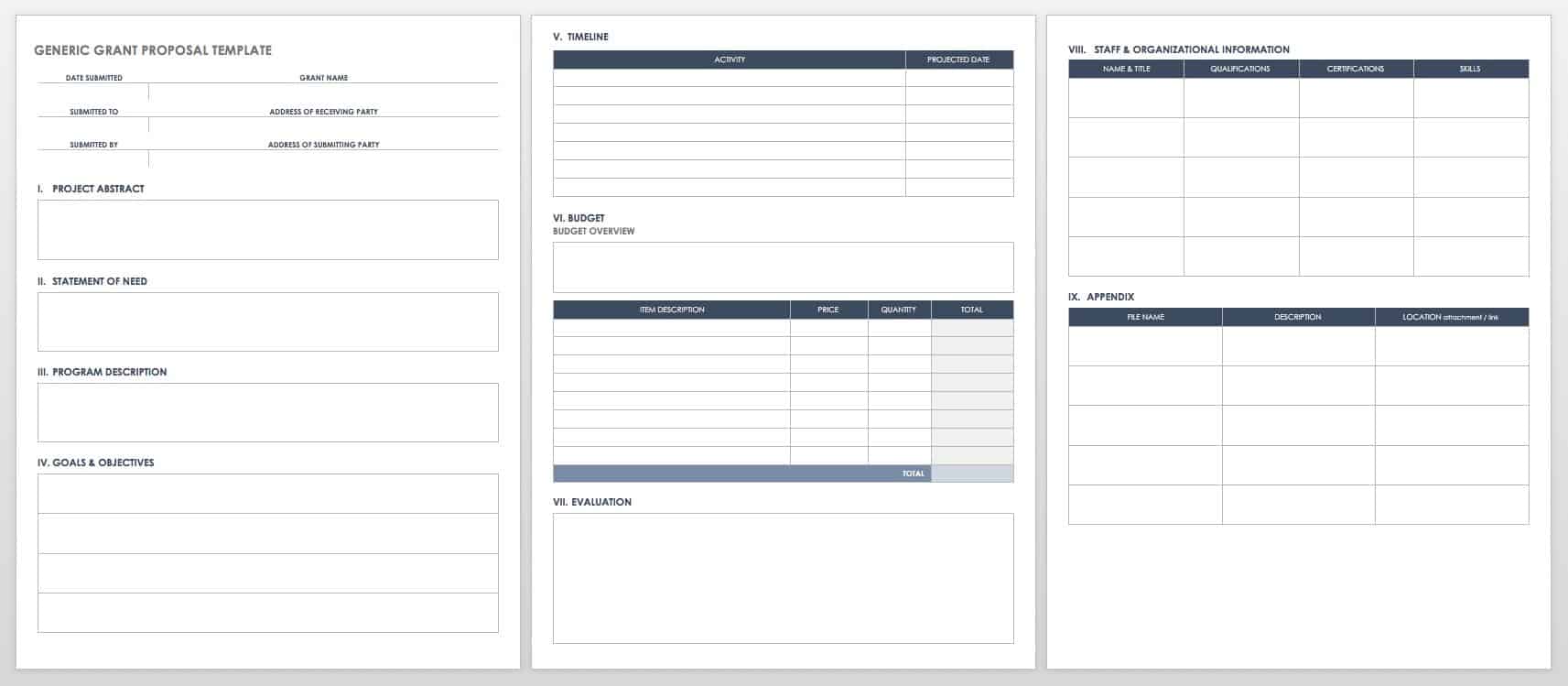
Use this template as a guide for preparing a grant proposal. It includes typical sections, such as a statement of need, project description, goals and objectives, and budget. There’s also room to add a detailed timeline. This template provides a basic outline that you can easily modify for a range of proposals.
Download Generic Grant Proposal Template
Word | PDF
Nonprofit Grant Proposal Template

Many nonprofit organizations rely on grants to pay for operating expenses and provide community services. This grant proposal template for nonprofits includes sections for adding organizational background information, details about the community or population that will be served, measurable goals, and more. Remove or add sections as needed to create a customized template.
Download Nonprofit Grant Proposal Template
Research Grant Proposal Template
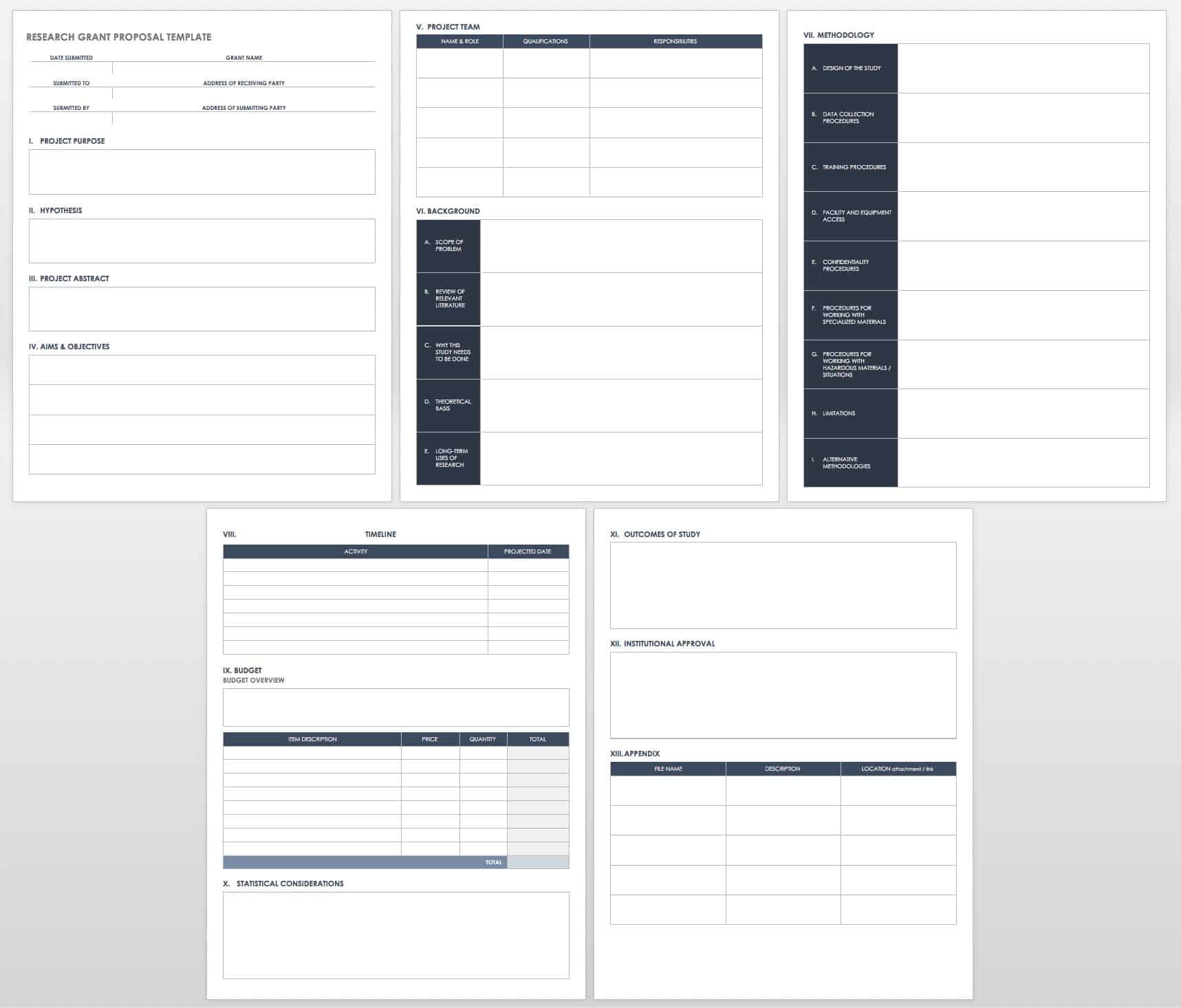
Present your hypothesis, literature review, research plans, and projected outcomes with this research grant proposal. This template could be adjusted to suit a scientific research proposal or academic grant application. Depending on the application requirements, you may be able to submit this document as a formal proposal, or you can use it to compile and organize all of the information that will go into your final proposal.
Download Research Grant Proposal Template
Technology Grant Proposal Template

This technology grant proposal template is geared toward teachers and schools seeking funding for technology to use in the classroom. You can use the template to describe educational goals, technology needs, program sustainability, and budget requirements. The proposal also includes a timeline section to add a detailed schedule.
Download Technology Grant Proposal Template
Grant Budget Templates
Grant proposal budget template.
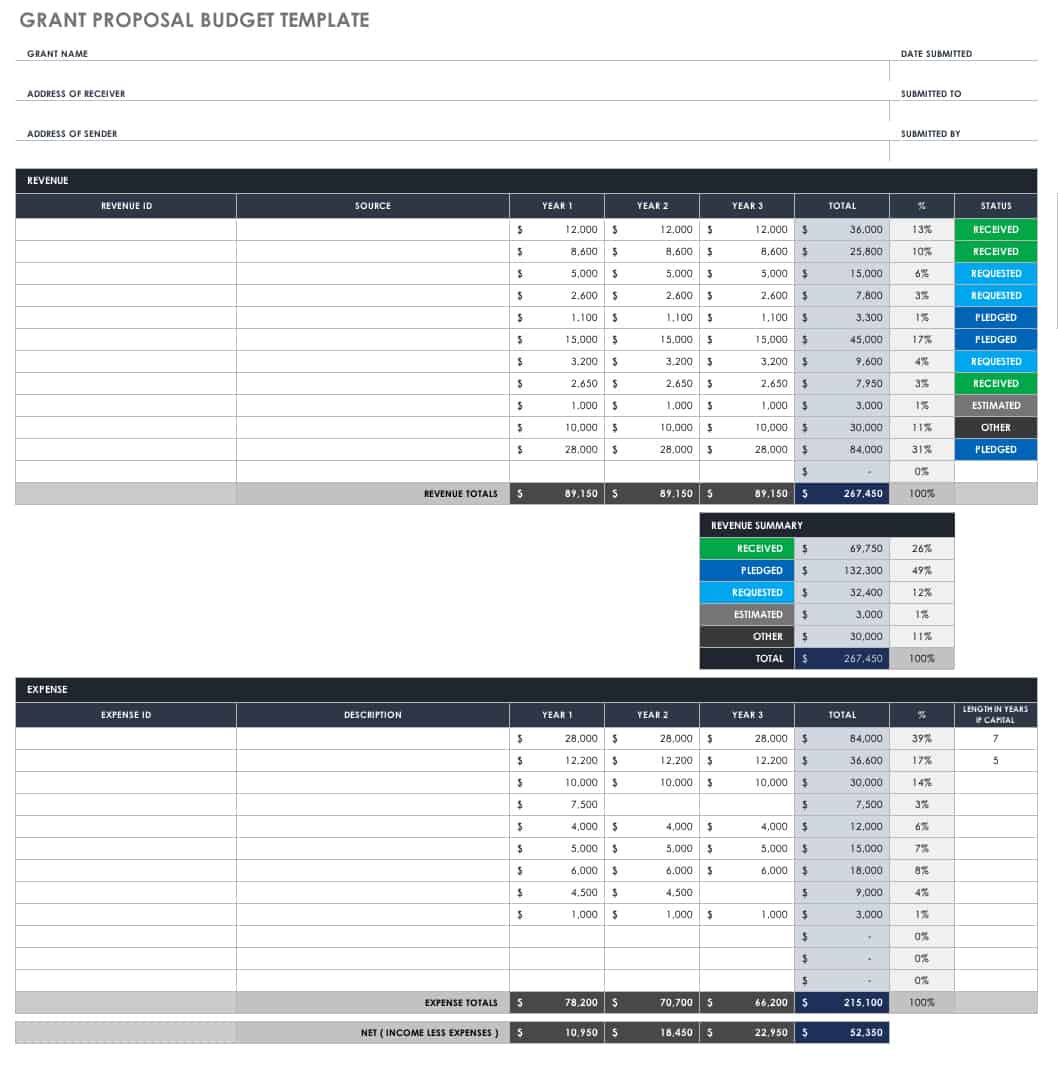
Create an itemized grant proposal budget that shows income and expenses over the course of a given time period. Enter funding sources and amounts along with specific costs, and the template will automatically calculate the totals. You can use this template for planning purposes, or submit it as part of a larger grant proposal.
Download Grant Proposal Budget Template
Grant Budget Revision Template
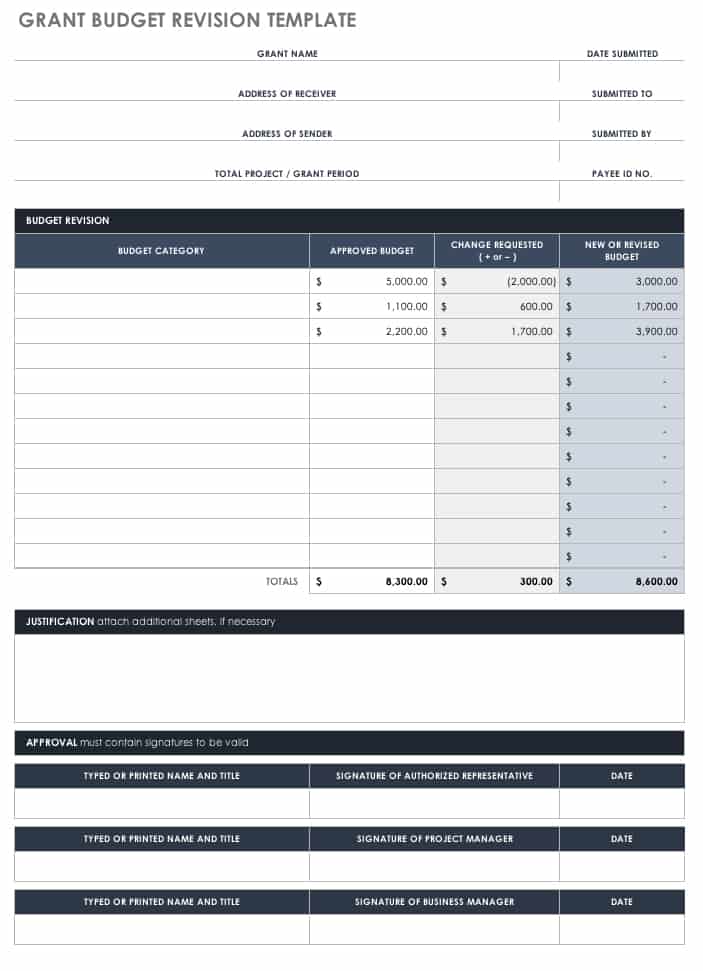
If you need to request a budget revision, this template is designed to show how funds will be adjusted by reducing the amounts allotted to one or more categories and increasing funds to others. Some grant makers require a revised budget so that they can approve how funds will be used. This template also includes room for adding organization and grant details.
Download Grant Budget Revision Template
Nonprofit Cash Flow Projection Template
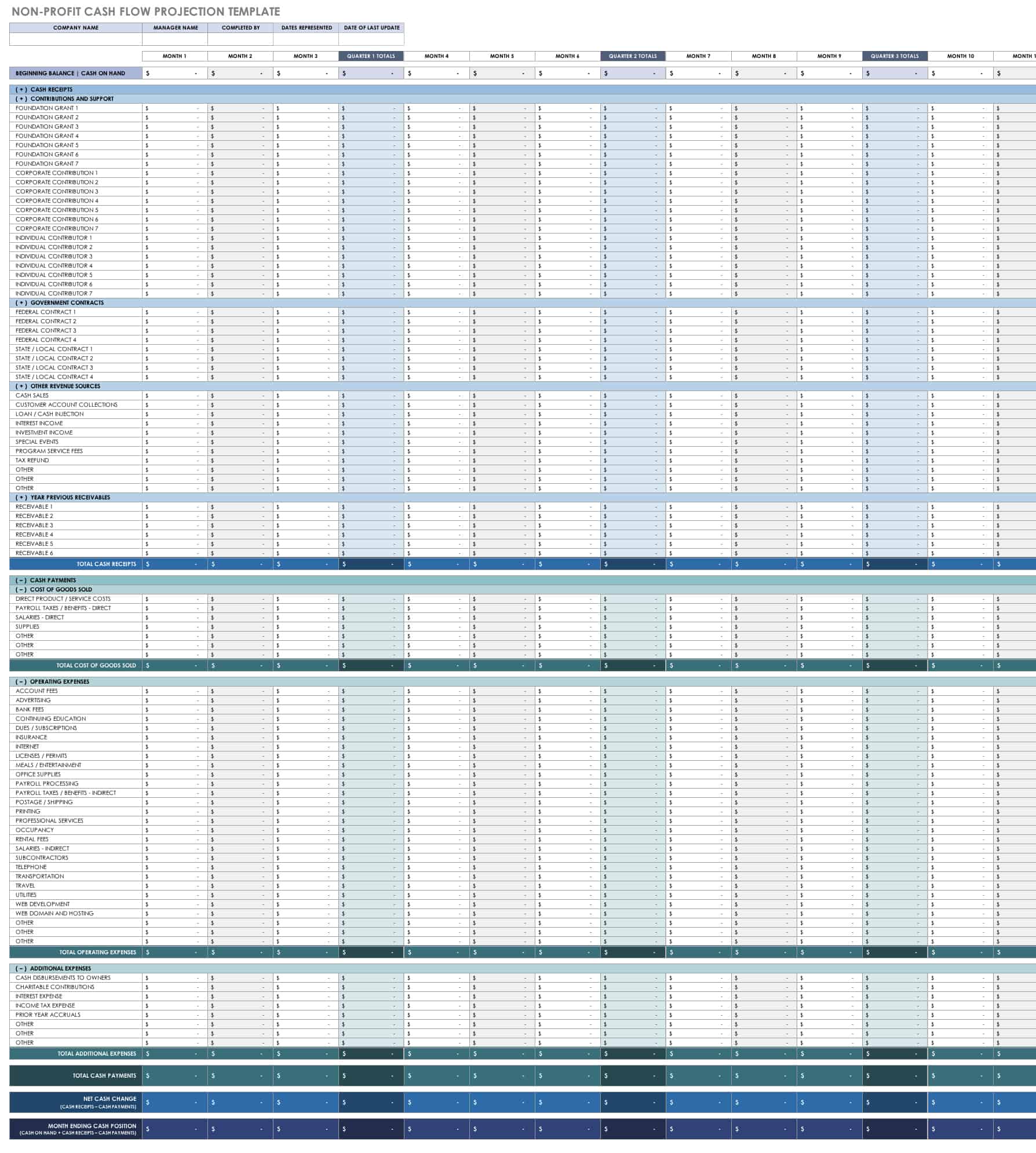
Nonprofits can use this cash flow template for financial planning over a 12-month period. The template shows revenue and expenses on a monthly, quarterly, and annual basis. The template also lists common funding sources along with operating costs, which can be edited to accommodate any type of organization.
Download Nonprofit Cash Flow Projection Template
Grant Application Templates
Grant application template.
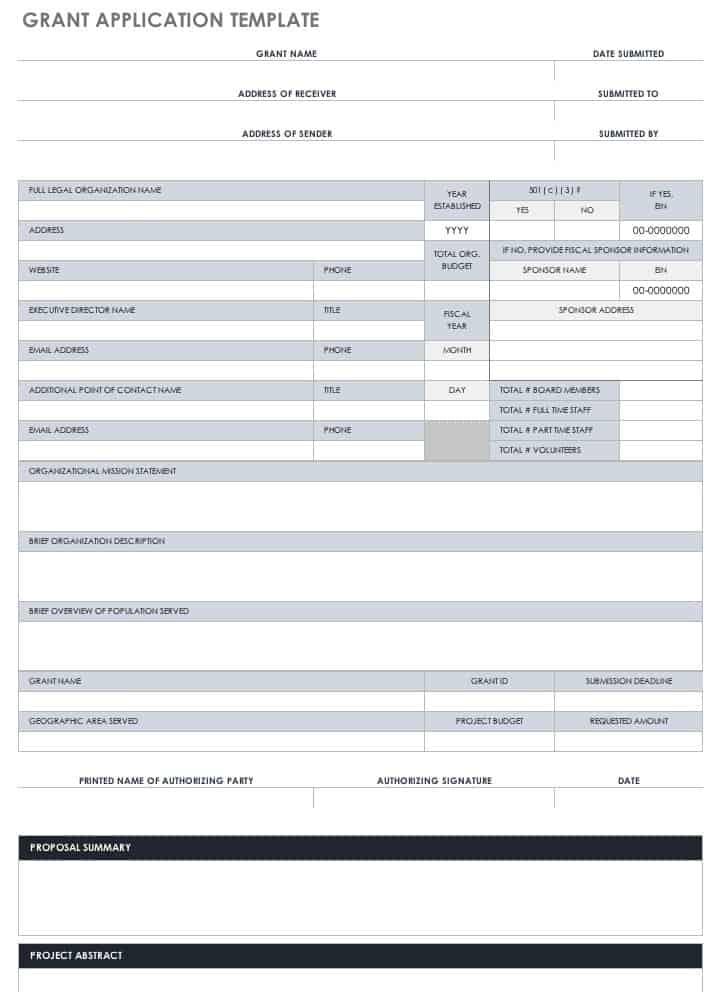
This template is intended for grant makers who want to create a grant application. It has sections for collecting applicant contact information, organizational details, and a thorough proposal, including a budget. Customize the application to cover whatever questions and information need to be reviewed to accurately assess a proposal.
Download Grant Application Template
Excel | PDF
Grant RFP Template
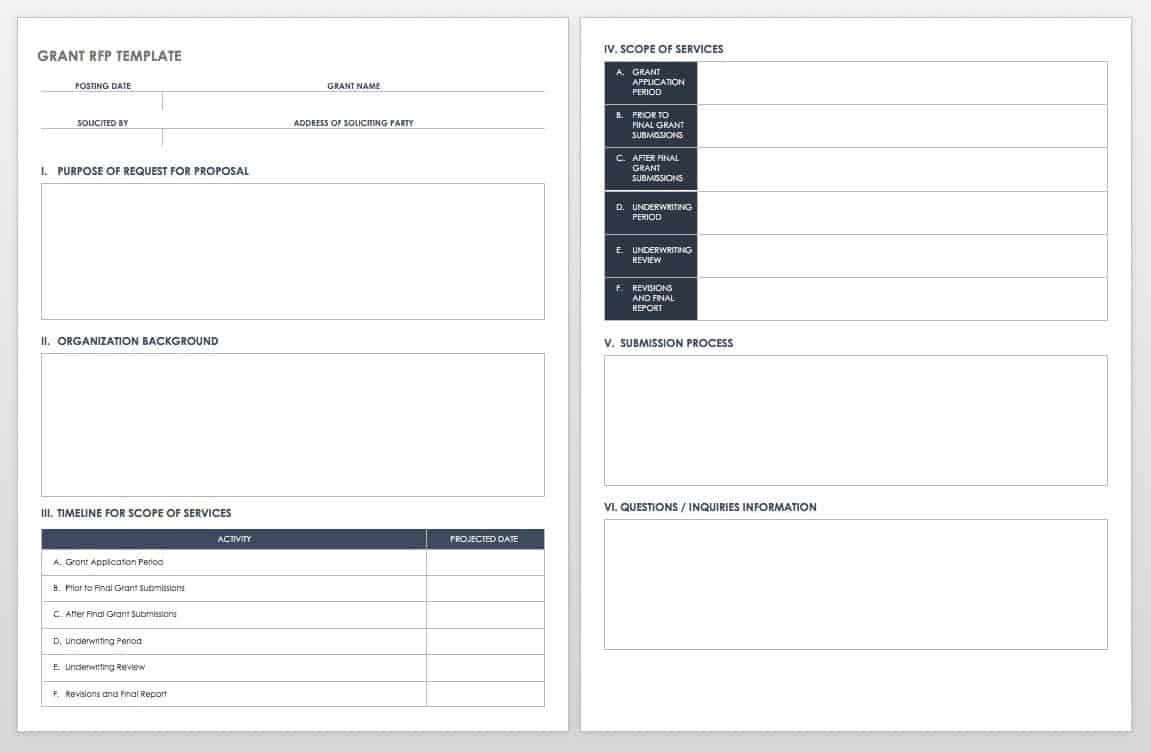
Grant makers can follow this outline to create a request for proposal template. Include submission instructions, agency background information, the timeline for reviewing proposals, and any requirements for proposal content and formatting. Applicants will also want to know what criteria will be used for evaluating proposals.
Download Grant RFP Template - Word
Grant Report and Evaluation Templates
Grant proposal checklist and evaluation form.
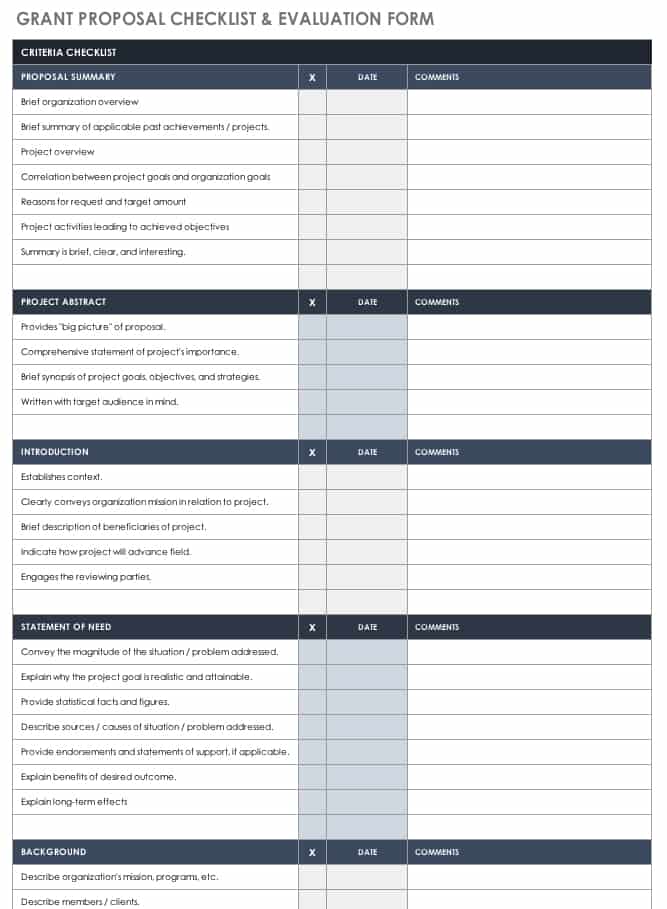
Once you have completed a proposal, use this checklist to ensure that all application requirements have been met and to evaluate the proposal’s quality and effectiveness. Consider soliciting feedback on your proposal from stakeholders or others who may be less familiar with the project and, therefore, more objective. Taking a moment to review a proposal may help reduce errors or omissions that could cost more time and money in the long run.
Download Grant Proposal Checklist and Evaluation Form
Excel | PDF
Grant Report Template
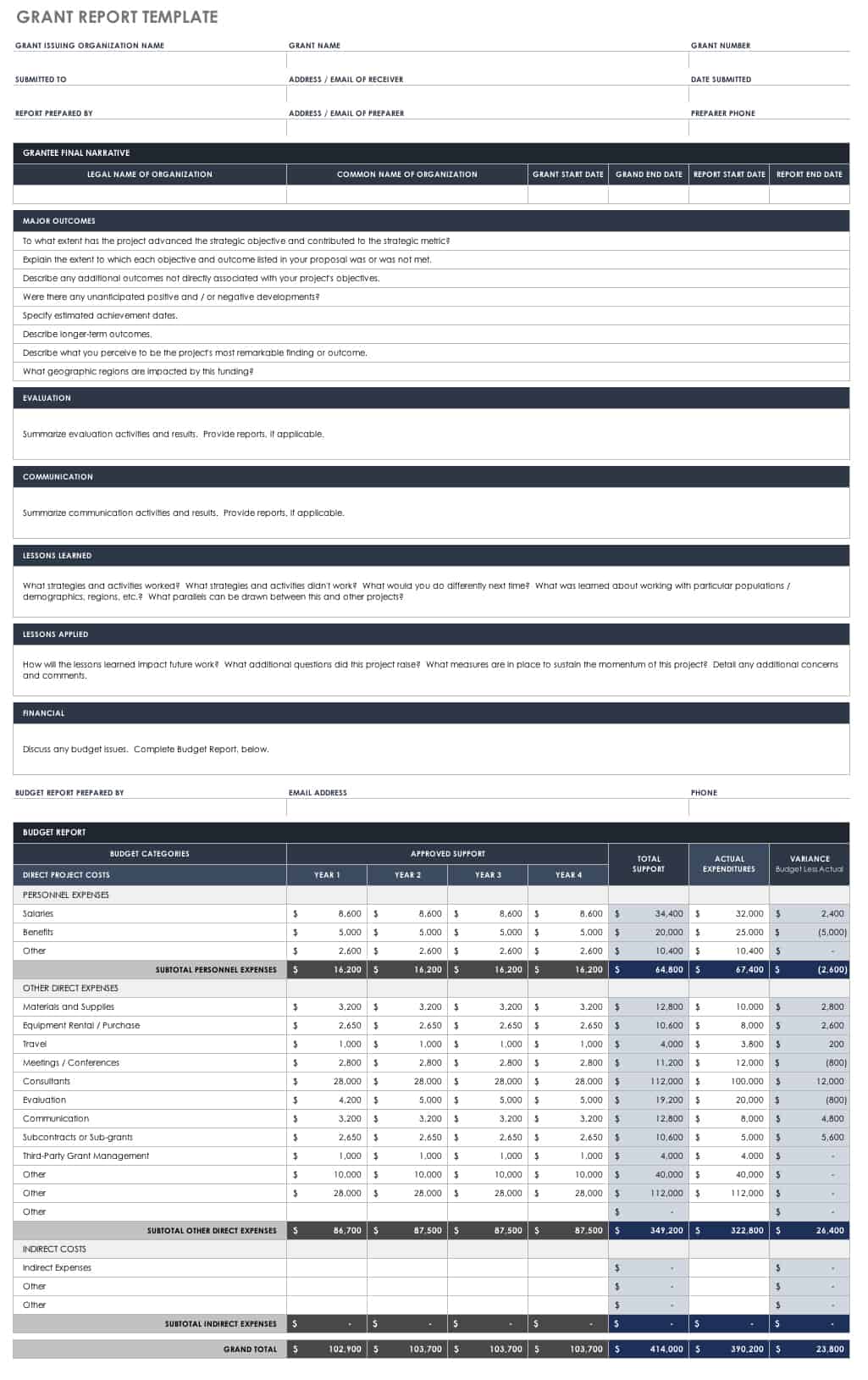
Grantees may be required to submit an interim or final report describing the progress and outcomes of a project. This simple template provides an outline for creating a comprehensive report, including a financial update that shows how funds have been spent. Grant makers can provide this form to grantees so they have a template to follow for creating a narrative report.
Download Grant Report Template
Grant Applications and Eligibility
Grant writing varies across disciplines, and proposals range from lengthy reports to brief letters that summarize project details. A science grant proposal might be 50 pages long and include a thorough literature review, background information for key personnel, research methodology, and more. The National Science Foundation, for instance, has extensive guidelines for grant applications, and its policies and procedures are outlined in a comprehensive guide for grant applicants.
An application for a global grant from the Rotary Club, on the other hand, is much shorter, and the information required depends on the type of project to be funded. The scope of a project, the amount of funding being awarded, the type of grant maker, and other factors influence what is required from grant seekers.
Businesses are generally not eligible for grants unless they qualify for funding through local government initiatives or are involved in research and development projects that are relevant to federal programs. Some states offer small-business grants to woman- or minority-owned businesses as well as for certain industries. If your company qualifies for federal or state funding, creating a business grant proposal would entail following the guidelines for a specific grant.
Some organizations will accept a common grant application form, which allows for a standardized proposal that saves time for both grant makers and grant seekers. When researching grant opportunities, it is important to understand and follow the application requirements so that your efforts aren’t undermined by technical errors, missing information, or mistakes in the submission process.
Mastering the Grant Writing Process
Writing grants may seem to adhere to a series of linear steps, but unless you are applying for a one-time grant and will not use grant funding in the future, grant writing is a circular process that follows a funding cycle. The process begins with a goal or need that gets translated into a proposal, which is reviewed by the agency or foundation supplying the grant, and then accepted or rejected.
Whether the proposal is accepted or not, the grant writing process continues into the next funding cycle as you revise and resubmit earlier grants or apply for new ones. Nonprofit organizations, ongoing research studies, and other groups that rely on grants as a primary funding source may need to keep a calendar and dedicate a writer to planning and securing grants.
To write an effective proposal, it is helpful to not only find grant opportunities that are relevant to your project, but also understand the funding source and gear your proposal to that audience. If a funder is available to meet in person prior to your organization submitting a proposal, that can go a long way toward providing a more personal context to your project and developing an ongoing relationship. Above all, the proposal should describe a project that can realistically be carried out by the applicant based on experience, qualifications, and financial resources.
As stated earlier, grant proposals vary widely and the content is largely dictated by the application requirements of a particular funder. However, there are commonalities among grant proposals. Here is a look at some of the information typically included:
- Cover Letter: Unless you have already had a face-to-face meeting or other contact with a funder, the cover letter is the first impression of your organization and project. Provide a brief summary that emphasizes your vision and objective.
- Proposal Summary: Although included at the beginning of a proposal, an abstract or executive summary section is often written last. It provides a brief overview of a project, including how the project fits with funding criteria.
- Literature Review: Academic and scientific research grants typically include a literature review that lists and evaluates sources of preliminary research that are related to the project.
- Statement of Need: The need statement is your opportunity to show a funder why your project is important. It explains the issue, and also provides background information and relevant research or evidence to support your proposal. You present the argument for why your project should be awarded funding over other proposals.
- Organization Description and Staff: Organizational history, background and qualifications for key personnel, and a program’s mission and track record for similar projects may all be important to illustrate a trustworthy reputation and your ability to successfully implement the proposed project. You may need a separate section to outline specific roles and responsibilities.
- Project Narrative: This is where you would include a lengthier project or program description, providing a detailed look at what the project entails, specific goals, and other information. You may include some of the sections listed here, such as personnel information, objectives, and measurements for success.
- Goals and Objectives: Breaking down goals into definitive and measurable results outlines the vision for a project as well as tangible outcomes. Grant proposals from nonprofits and other organizations involved in community projects may also include a description of the community being served, information on how it will benefit, and research on the potential for community involvement.
- Methods and Strategies: Grant makers will want to see how you plan to achieve goals and objectives. You may decide to include a logic model, which offers a condensed version of your proposal outline, to provide a visual representation of the key elements of your project and how they will lead to the intended outcomes. Clarify connections among methodology, objectives, and outcomes.
- Project Timeline: A timeline for your action plan can help funders visualize the stages of your project. This may be especially useful for research projects carried out over the course of several years. You may also want to include a budget timeline.
- Evaluation: Create an evaluation plan and describe what metrics will be used to assess a project’s effectiveness or impact.
- Sustainability Plan: If a project will continue into the future, create a plan for ongoing sustainability after grant funds have been used — doing so shows funders that a project is viable for the long term.
- Other Funding: Grant makers may want to see what other sources of funding you expect to receive for your project.
- Budget: The proposal budget shows estimated expenses along with sources of revenue. It provides an itemized look at how funds will be allotted and utilized.
- Appendix: References and additional materials can be included in the appendix.
Before submitting a completed proposal, grant writers can do their own review to ensure that the proposal meets the necessary criteria and application requirements. Grant makers will in turn conduct their review process and select which proposals to fund. Once funding is awarded, the grant maker and the grantee sign an agreement that describes the terms of the grant.
There are many sample grant proposal templates online that provide examples of successful applications. For instance, the National Institutes of Health (NIH) offers a variety of sample proposals for scientific research, as well as small-business funding for research and development.
Top 5 Grant Writing Tips
If you are new to grant writing, here are some tips to keep in mind as you develop your proposals:
- Give yourself plenty of time. Researching grant opportunities and gathering the information needed for an effective proposal can be a time-consuming process. Start earlier than you think you need to, and create a schedule to keep your grant writing process on track.
- Keep trying. If your proposal is rejected, revise it and apply again. Persistence can pay off, and you don’t need to wait for the results of one application before applying for a different grant. Sending proposals to a diverse selection of funders may also increase your chances of being selected.
- Details matter. Be specific about how funding will be used, goals will be achieved, and data will be collected, as well as your timeline of action steps. Grant makers want to know exactly how their money will be used, what impact the project or program will have, and why the project is important.
- Follow the rules. Follow grant application guidelines exactly, including answering required questions, providing requested information, and sticking to a submission timeline.
- Pay attention to formatting. The format of your proposal may be dictated by grant guidelines or a preset application, but make sure it is organized with clear headings. Information should be easily accessible and appropriate for the given audience.
One final tip: Create a reusable template that can be adjusted for a variety of grant applications.
Improve Grant Proposal Management with Smartsheet
Empower your people to go above and beyond with a flexible platform designed to match the needs of your team — and adapt as those needs change.
The Smartsheet platform makes it easy to plan, capture, manage, and report on work from anywhere, helping your team be more effective and get more done. Report on key metrics and get real-time visibility into work as it happens with roll-up reports, dashboards, and automated workflows built to keep your team connected and informed.
When teams have clarity into the work getting done, there’s no telling how much more they can accomplish in the same amount of time. Try Smartsheet for free, today.
Discover why over 90% of Fortune 100 companies trust Smartsheet to get work done.
Published in
Letter Templates , Request Letter
8 Free Effective Grant Request Letter Templates
Various corporations, private foundations, and Individuals dispense grants to non-profit organizations for running programs, services, staff remuneration, and expanding the office space. Usually, grants are distributed to non-profit organizations based on a given area of interest.
Therefore, you must research the requirements for a particular funder before addressing a grant request letter.
For most Funding corporations or foundations, typical funding requirements include reference letters from supporting organizations, being accredited as a 501(c )3 non-profit organization, and having a list of an active board of directors who help run your organization.
In the present world, most foundations prefer that you send a letter of inquiry or a proposal letter first instead of a full grant proposal package. This applies especially where you are approaching the organization for funding for the first time. The argument behind this is that it is faster for a non-profit organization to create an excellent first impression of possible funding ideas with a brief one-three-page letter rather than a complete proposal. In any case, the foundation has to approve that your project is good enough for its funding goals and priorities first before they ask you to send your full grant proposal package.
This article provides a comprehensive guide on how to write an effective grant request letter, what it should contain, tips for constructing the grant request letter, and numerous samples and templates for your reference.
Elements of a Great Grant Request Letter
Writing a grant request letter is an art as well as a science. Excellent Grant writing and application skills require you to uniquely bring out your organization’s strengths and problem statement in the most succinct, comprehensive, and accurate way possible. The way you write your grant request letter drastically determines whether you increase or break your chances of getting funding for your campaign or project’s success.
Different funders may require you to present your grant requests using particular formats. However, most grant applications adhere to certain standard elements. These include the following:
Executive summary
This provides a brief overview of information about the organization, its ability to complete the project, needs, action plan methods, and how those served will benefit.
Organizational background
It includes a brief description of the institution regarding demographic location, mission , vision, relationship to the service area, and past project accomplishments in the given area. Usually, this information establishes credibility.
Needs assessment
This is an outline of the problem statement or the need for funding. The needs assessment should be linked to the funder’s goals and priorities.
Program goals and objectives
This section establishes the projected outcomes and benefits in quantifiable terms.
Implementation plan
Includes a brief description of the methods that will be put in place to ensure the set objectives’ achievement. Usually, a timeline and a description of staffing needs are included.
Evaluation plan
Provides a criterion for determining the project’s success either at short-term points or at the end of the project.
The sustainability method/ future funding
This section outlines how the project effort will continue once the grant depletes or how expenses that are not supported by the grant will be covered.
Include a budget plan/costs covered by the funding source and how the costs were determined.
Attachments
Other funders may require you to attach items such as personnel resumes, letters of support, or proof of 501(c )3 status .
How to Write (Format)
Use the following steps to construct an excellent grant request letter that will help you create a good first impression for your funders and help you receive funding for your non-profit organization.
Write the date
Record the actual current date if you are sending your grant request letter via email or mail immediately. Else, postdate your letter to match the actual mailing date. It is also essential that you give the funding foundation enough time to vet and respond to your request. Thus, it is recommended that you send your grant request letter three to six months before you need the money or item, so the funder has enough time to consider your request.
Write the opening address and the full mailing address
While writing the grant request letter, use the correct and professional personal title of the recipient. You may contact the company or do online research to counter-check the gender, the job title of the contact person, and the corporation’s current mailing address.
Make use of a professional salutation before the recipient’s title. If you already know the recipient, you can use their first name after the salutation. However, if you don’t have a personal relationship with the contact person, use their surname after the salutation. Since the grant request letter is business correspondence, use a colon after the salutation and not a comma.
Begin the letter with three bulleted introductory sentences
There are two major approaches to writing these introductory sentences;
- Start your grand request letter using accurate, astounding facts about your target benefactors of the goods or services you are requesting.
- Another approach is by stirring the reader’s memory and connecting him/her to a memory that they loved and experienced personally. If you decide to use this approach, ensure that the memory starts out sad but ends happily.
Your introductory paragraph should be eye and mind-catching to ensure that the reader keeps reading.
Using a few sentences, introduce your non-profit organization to the reader
Briefly describe your organization structure, whether non-profit, private operating foundation, or membership association, and provide an overview of your target population or the beneficiaries of your project.
Problem statement
In one paragraph, using a few sentences, explain to the reader why you really need the requested funding, items, or services.
State the measurable objective the donation will help you achieve
Using one to three sentences, state the plans you will take to ensure that organization lives up to its end of the donation through a quantifiable objective.
Include a reason- why you chose the particular company and point to your organization’s knowledge
Current advances in technology have made it possible for us to find almost all the necessary information relating to a company that can play to our advantage. Therefore, use the internet to do your research on the funding organization and share two or three positives about the company in writing. This may include your knowledge of any awards or accolades that the company received or any project they are doing to help shape the community at large.
Show your gratitude and appreciation for the donation
In a few sentences, explain to your recipient how a donation from their organization helps create a partnership in promoting corporate social responsibility at large.
Closing paragraph
Use the closing paragraph to provide your organization’s contact information if the recipient needs clarifications or has further questions. Remember to include a timeline- when you need to have the goods, services, or funds in place. This helps in decision-making for the funding corporation. Sign off your grant request letter using a professional and respectful closing remark. Examples of the closing tag include; “Respectfully, Hopefully, or Sincerely.”
Free Templates and Examples
You are stuck on what subtler points to include in your grant request letter to increase your chances of getting a funding request? Download our premium, professional, free customizable, and printable grant request Letter Templates to help you create and generate a great grant request letter for your funding request.
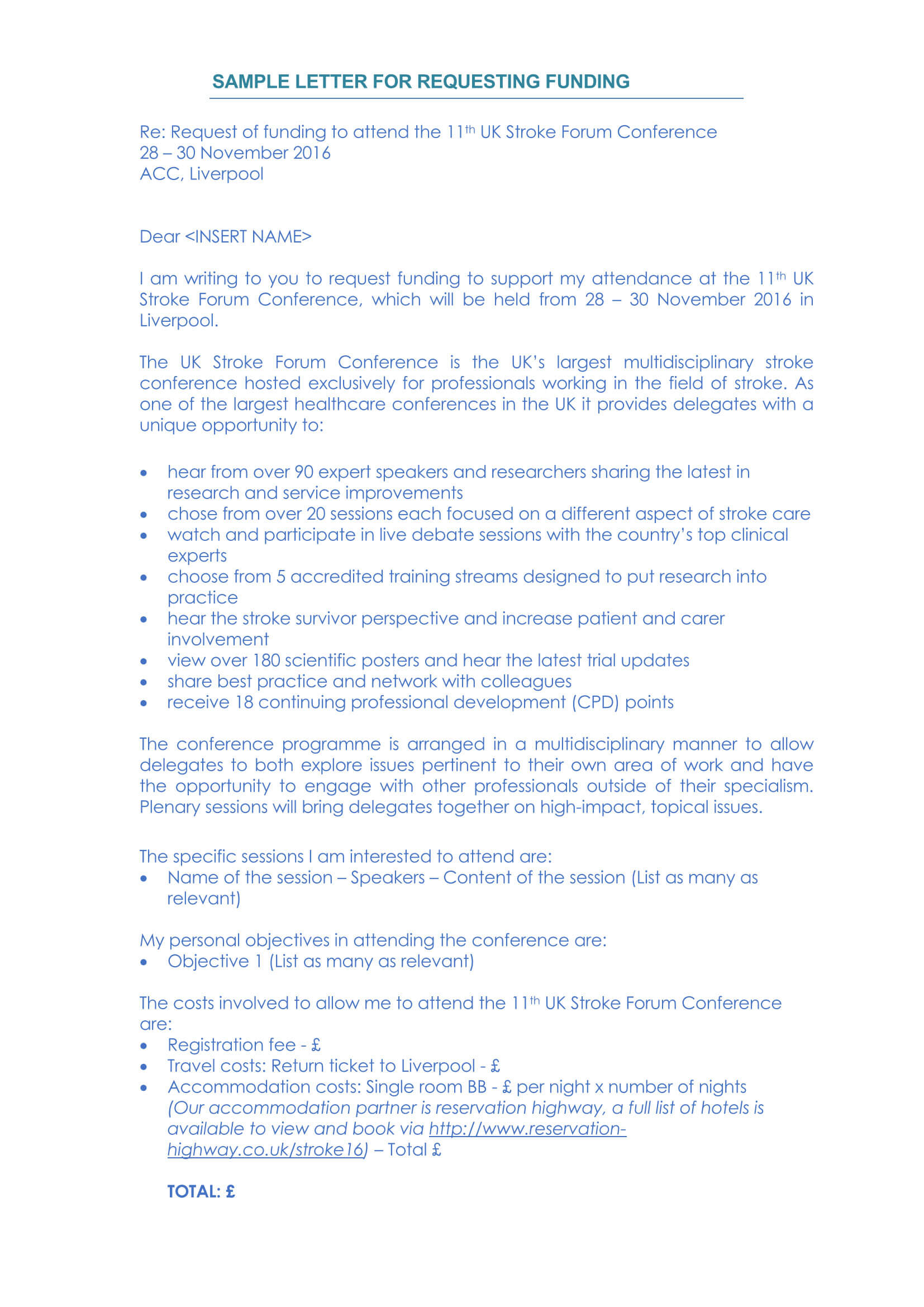
Frequently Asked Questions
How do i write a letter requesting a grant.
Writing a grant request letter is the most technical part of your proposal. It can increase or break your chances of a funding request. Here is how to effectively write a letter requesting a grant:
1) Briefly introduce your organization 2) Tell the funding corporation how much money you are requesting and state a good reason you need it. 3) Using a few lines, tell the reader what your organization does 4) Include a research-based bullet point that indicates the society needs what your organization does. 5) In writing, demonstrate how knowledgeable you are about the funder and how your grant fulfills the funder’s requirements.
How do I ask for a grant?
Follow these five steps to request a grant from a funding corporation or foundation:
1) Carefully look for grant prospects 2) Use the internet to find out more information about your targeted grantors from time to time 3) Contact the organization to find out if you are eligible to receive funding from them 4) Create a grant proposal or letter of intent to ask for funding 5) Follow the grantor’s application procedure to the latter while applying for the grant to avoid missing out on important details
How do I ask for a grant letter of support?
Firstly, create a list of beneficiaries from your proposed project Schedule meetings with them and discuss what the anticipated project will be. Politely ask them if they would be willing to write a letter of support to win the funding you need.
What should I include in a grant support letter?
A letter of support is generally similar to a recommendation letter. It includes the writer’s necessary information, their connection to the person they are recommending, why they are qualified, and the unique skills they have. If possible, when writing a support letter, you should include specific anecdotes and illustrations that indicate your support for the specific person or organization.
How long should a grant request letter be?
Simply make it a one-page letter with three to four paragraphs maximum. It should be easy and quick to scan through.
Keep reading
6 sales letter templates for new products.
Letter Templates
Past Due Letter (15 Days, 60 Days, 90 Days | Free Samples)
Letter of support for immigration | 10 best examples, 4 free retirement letter templates [how to write].
Employment , Letter Templates
12 Best Refund Request Letter Sample & Templates
5 best cheque book request letter samples.
- Information
- Writing a funding application
This page includes general guidelines for writing funding applications , how to write a letter of application and how to complete an application form .
There is also a glossary at the end to help you to untangle some of the jargon funders use.
You will be much more likely to write successful applications if you plan your activities well before you apply for funding, and if you choose the right funder to apply for. Use our information on Planning a funding application to help you with these before you start writing applications.
General guidelines for writing funding applications
- Always keep your project plan in mind . Don’t get carried away and commit yourself to a project you won’t be able to run even if it sounds better in the application.
- Write in plain English . Use short sentences and avoid acronyms and jargon. There is no need to use formal or flowery language. Remember that you are describing your work to someone who has never met you or seen what you do. See our information on How to write clearly for some more tips.
- Be specific about what you plan to do. For example, rather than saying “we will run sports activities for children”, say “we will run weekly football sessions and weekly hockey sessions for 8-11 year olds over a six month period. Each session will be 2 hours long and will be attended by 15 children.”
- Focus your application on the funder’s priorities. For example, imagine your group runs a dance project for local people: if you are applying to a funder that prioritises projects which help people keep fit and healthy, focus on the fact that dance is good exercise. If you are applying to a funder that prioritises projects which promote arts and music activities, focus on the art and music element of the dancing.
- Provide evidence that your work is needed. See our information section on Useful research for fundraising for some links to sources of evidence and people who can help with research.
- Include all the information the funder has asked for and any additional information or documents they require. Missing things out might mean your application gets rejected automatically.
- Take extra care to meet the deadline. Late applications will not be considered, even if they are fantastic!
- Make your budget as specific as possible. Get quotes for everything you will need to pay for, so that it is accurate.
- Do not include any non-specific items in your budget , such as “contingency costs” or “miscellaneous”.
- Do not apply to more than one funder for the same costs at the same time. If you are successful in both applications you will end up having to turn down one of the funders. This could damage your chances of getting funding from them in future. The only exception to this is applications to very small trusts. It sometimes makes sense to write to several trusts for funding for the same costs, as each one may only be able to make a small contribution towards these costs.
Writing a letter of application
If a funder has a standard application form , use it. If not, you will need to write a letter.
There is a sample letter below. If you are writing letters to local businesses to ask for donations, you will also find our information on Fundraising from Local Businesses useful.
Focus your letter on the aims and criteria of the organisation you are applying to, and how your project or activities fit into these. Do not send standard letters. Your letter should be:
- On headed paper.
- Addressed personally to the named contact for the funding body.
- Short and to the point. Keep your letter to two sides of A4. Focus on providing relevant information about your group, what you want to do, and why it fits into the priorities of the funder.
- Written in plain language. Do not use jargon or abbreviations.
- Signed by a member of your group who can be contacted for further information.
Some funders will tell you what to include in your letter. If they don’t, use the following list as a guide. Have a look at Planning a funding application for more help with preparing this information.
- Your project title if you have one.
- A summary of the project, and how much money you are applying for.
- An introduction to your group including your aims, key achievements to date, support from other bodies.
- A clear description of the project or activities you are planning.
- Why the project is important and how it will benefit its users.
- A summary of how you will monitor and evaluate the project. See our information sheets on Reporting to a Funder and Monitoring and Evaluation for more tips on how to do this.
Finish the letter with an offer for them to contact you for more information.
You should attach the following documents to your letter:
- Project budget, including all the costs of the project, which bits you are asking them for funding for, and where the rest of the money will come from.
- Bank details for your organisation.
- A governing document (e.g. constitution / trust deed / memorandum and article of association).
- Your most recent accounts.
We have information on Budgets for community groups , Constitutions and several information sheets on looking after your group’s money and getting your accounts independently examined .
Sample application letter
Below is an example of a letter of application to a funder. Remember, your letter must be specific to your project and specific to the requirements of the funder you are writing to. This is just to give you some ideas about how to structure it.
Your name and role Your organisation’s name Address Date
Recipient’s name Job title Organisation Address
Dear Jane Bloggs
KidsClub Application for AN Other Fund
We would like to make an application for £1000 from the AN Other Fund. We are a group of local people in Anytown, and we have recently set up a community group running free sports activities for children in the area.
We were mainly inspired to start the club because some of our children often get into trouble at school, and don’t find it very easy to make friends. We have 16 parents involved, plus 6 other local volunteers. Over the last four months we have run weekly activity sessions in the park, which have been attended by over 40 local children.
We formally adopted our constitution on 10th July 2012. This is enclosed. Our aims are:
- Provide a safe, fun environment where all local children aged 7-11 are welcome.
- Encourage children to take part in physical activity and develop healthy habits and lifestyles.
- Provide a fun focus for parents and children to play together and forge relationships with other local families.
- Provide particular support for families whose children struggle with school, or have difficulty making friends, by linking children up with individual one-to-one volunteers who support them to access the sessions and build friendships with other children.
We have begun our activities in the summer months. By borrowing equipment from a local primary school, and running our sessions in the park, we have kept our costs very low.
Our weekly sessions have become very important to those involved. One parent said “Taking part in KidsClub means that my son has had a chance to make friends. He is sometimes bullied at school, and finds it hard to socialise. KidsClub has made him much happier and this has helped his confidence and he is now even enjoying school more.”
We want to provide a continuous experience for the families involved, and get more people involved. For this reason we would like to run indoor activities from November 2012 – April 2013.
We are applying to AN Other fund for £1000 to cover the costs of hiring a sports hall for weekly activities, plus three swimming sessions and one Christmas ice skating session.
We will provide feedback forms after every activity.
We are also requesting money to pay for printing leaflets, to publicise the project to more families. Our bank details are: Anytown Bank Account Name: Anytown Kids Club Sort Code 010101 Account number 09010901
We have enclosed a copy of our constitution, and a bank statement. Please see below a budget for our project, showing how we intend to spend the money we have asked for.
We do not yet have annual accounts, as we have not been running for long enough. We will get our accounts externally examined at the end of the year. Since setting up our bank account in August, we have received £47 in donations from supporters. We have spent £36 on equipment hire, refreshments and publicity. We have been able to access a free meeting room at a primary school. Our current bank balance is £11.
Please don’t hesitate to get in touch if you would like any more information. Thank you for your consideration.
Yours sincerely,
Your full name (Chair)
| Hall hire (for 24 weeks, at £20 per week) | £480 |
| Swimming sessions x3 (for 40 children £1.50 per child per session) | £180 |
| Christmas ice skating (for 40 children, at £5 entry per child, and for 10 adult volunteers at £8 entry per adult) | £280 |
| Printing and publicity | £60 |
| TOTAL | £1,000 |
Completing an application form
When you complete an application form follow these basic guidelines:
- Take care to read each question carefully and make sure your answers include specific information that is relevant to the question. Use the jargon buster at the end of this sheet to help you understand the questions.
- Give yourself enough time to do a bit of extra research to ensure you can answer all the questions fully.
- Be clear, precise, and positive about your group and your proposed project.
- Keep in mind the funder’s guidelines and criteria when you are answering the questions.
- Do not include any attachments that aren’t specifically requested by the funder.
- If the form is online, write your answers in a Word document or similar, so that you can save them as you go along and share them with other people in your group.
- Ask somebody else to check your form thoroughly before you send it off.
- Keep a copy of your completed form.
What to do if you are successful
If you are offered a grant, the funder will often request further information or paperwork before they give you the money. Send this to them as soon as possible, and make sure you meet any deadlines they set for you. Failure to do so could mean you don’t get the grant after all.
Read through the terms and conditions of the grant carefully. What items have they agreed to fund? Do they specify any other conditions of how the money is to be spent or handled? What kind of monitoring information do they want? How do they want it presented?
Make sure you have a system for monitoring, and start this as soon as your project or activities begin. If the funder asks you for a report, make sure you send it to them in good time, including all the information they have requested. Even if you are not asked for information, it is worth writing to funders to let them know how your project is going, and highlighting any particular successes.
Jargon busting
Beneficiaries : people who will benefit from your project.
Capital costs : items or equipment you need to buy, build or repair. These might include items for your group to use, such as bicycles or computers, or repairing or renovating a building.
Evaluation : everything you do to consider how your project is going.
You can do it on an ongoing basis – for example, by having a discussion at a committee meeting about how things are going. You can also do it at the end of the project, by looking back and thinking about what went well and what you would improve next time.
It is important to remember what you were aiming to do at the beginning of the project when you are doing an evaluation, so that you can check to see whether you are doing what you set out to do. You can use information you gather as you are running your project, (monitoring), to help you to do your evaluation. This is why the two are often referred to together as monitoring and evaluation. Together they mean gathering information about how your project is going, and then looking at it and assessing what is going well and what could be improved.
Evidence : facts and proof that back up your claims. When applying for funding, evidence will be needed that the people your project is for are facing particular needs or problems which you project will help overcome. When reporting to a funder who has given you a grant, you may need to provide evidence that you have done what you said you would do. This could include survey responses, registers of attendance, photographs and receipts.
Indicators : the things you will measure to find out whether you are achieving your outcomes and outputs. For example, an indicator of whether you are achieving the output above might be “the number of children attending cookery sessions”. An indicator of whether you are achieving the outcome above might be “responses to children’s quiz about healthy eating”.
Match funding : funding from more than one source for the same project. Some funders will require this.
For example, they might say “We will give you half the cost of your project, but only if you can raise the other half from another funder”.
Monitoring : the methods you use to find out how your project is going. They might include taking a register of participants or doing a survey of your members.
Outcomes : the benefits that happen as a result of your work. They are the reasons for doing your project.
For example, if you are running a children’s cooking project, an outcome could be: “local children have a better understanding of healthy eating and nutrition”.
Outputs : what you actually do to achieve your outcomes.
So, in the example above, an output could be “running ten cookery classes for twenty local children”. When funders ask what your outputs will be, they are asking what you are actually, specifically, going to do.
Qualitative data : information about what people think/feel/experience etc., about your project.
Quantitative data : information that you gather through your monitoring about things you can count, such as the number of people attending.
Revenue costs : things you need to pay for that are not physical objects or buildings. They include salary costs, refreshments, volunteer expenses, venue hire and publicity.
Updated November 2015
Would you like to make a donation?
We hope you find this page useful. Would you like to make a donation?
All Resource Centre information is available for free because we know small community groups have small budgets. However, we are a small charity, so if you are in a position to make a donation, it will help us to keep running this service into the future.
- Getting a group started
- Managing funds for short-lived crisis-response groups
- Organising a public meeting
- Legal structures for community groups and not-for-profit organisations
- Charity Registration
- Constitutions
- Bank accounts for community groups
- Entity Tax Residency Self-certification form
- Your group's money
- Is your AGM coming up?
- Support for Chairs
- Support for Secretaries
- Support for Tenants' and Residents' Associations
- Support for treasurers
- Support with publicity and printing
- Support for Resource Centre Member Groups
- Awards for All (National Lottery)
- Builder Depot Charitable Donations Programme
- Chalk Cliff Trust
- East Brighton Trust Fund
- Enjoolata Community Grants
- Gatwick Airport Community Trust
- Hall and Woodhouse Community Chest
- Healthy Neighbourhood Fund
- Lions Clubs
- National Lottery Grants for Heritage
- National Lottery Reaching Communities England
- Patcham Community Fund
- Pebble Trust
- Postcode Society Trust
- Rampion Community Benefit Fund
- Rotary Club of Brighton
- Allen Lane Foundation
- B&H Buses Community Support Fund
- BBC Children In Need Core Grants
- BBC Children in Need Project Grants
- Brighton & Hove City Council Communities Fund: Resilience Fund
- Brighton & Hove Communities Fund: BME Engagement Fund
- Brighton & Hove City Council Communities Fund: Engagement Fund
- Civic Power Community Grants
- Clarity Environmental
- Lush Charity Pot
- Sanctuary Housing Community Investment Fund
- Sussex Community Foundation
- The Homity Trust
- The Southern Cooperative: Goods donations
- Trust House Charitable Foundation Small Grants
- Yapp Charitable Trust
- Brighton & Hove Legacy Fund
- Brighton Soup
- Hilden Charitable Fund
- Hilden Grants for Children's Summer Activities
- Sport England Movement Fund
- Sussex Gardens Trust
- Sussex Police and Crime Commissioner Safer In Sussex Community Fund
- Useful research for fundraising
- Budgets for community groups
- Fundraising from local businesses
- Fundraising ideas
- Monitoring and Evaluation
- Planning a funding application
- Fundraising from trusts
- Event planning checklist
- Hiring equipment from the Resource Centre
- Licensing and regulations for events and fundraising activities
- Organising online activities and events
- Public liability and employer's liability
- Running a crèche
- Writing a news release
- Reporting to a funder
- Designing and using surveys
- Examination of accounts
- Free accounts systems to download
- Independent examinations of accounts at the Resource Centre
- Support with raising money
- Charity reporting and accounts
- Financial rules
- How much money do we have?
- Managing money at an event
- Quick tasks for treasurers during the Covid-19 pandemic
- Treasurer's role
- AGM Checklist
- Chairing a meeting
- Health and safety for community groups
- How to improve your chairing skills
- Hybrid meetings (in person and online)
- Involving people in your group
- Making your activities and events accessible
- Taking Minutes
- The Secretary's role
- Video and telephone meeting tools
- Responsibilities of registered charities
- Responsibilities of the Management Committee
- Roles of Officers
- Equality and diversity policies for small groups
- Risk assessment
- Safeguarding
- Using the Disclosure and Barring Service (DBS)
- Data protection for community groups
- Facebook for community groups
- Video-making tips for community groups
- Covid-19 Risk Assessments
- Resource Centre policies and procedures
- Taking photos at community events
- Sample risk assessments
- Support with producing newsletters
- Days out in Sussex for community groups
- Local media contacts
- Organising a letter-writing campaign
- Organising a petition
- Planning and running a campaign
- State your case: how to write a campaign briefing
- Beginner's Guide to Printing
- A community group's guide to radio and TV interviews
- Planning a neighbourhood newsletter
- What will you put in your neighbourhood newsletter?
- How to make your neighbourhood newsletter look good
- How to write clearly in your neighbourhood newsletter
Our website uses cookies
We use some essential cookies to make our website work properly. We also use Google Analytics cookies to get anonymous information about how the site is being used. This helps us to report to our funders. To find out more, see our Privacy notice for website users.
Click OK to accept all cookies and carry on using the site. Click Essential cookies only if you don’t want us to have anonymous data about your location and which pages you visit.
- Link to facebook
- Link to linkedin
- Link to twitter
- Link to youtube
- Writing Tips
Funding Request Letter Template
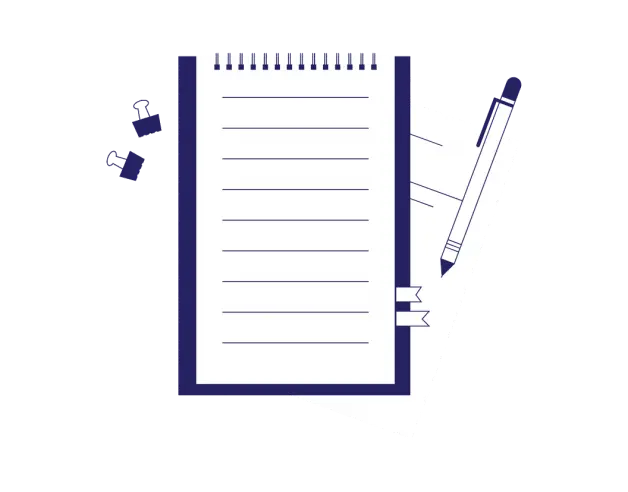
4-minute read
- 28th May 2023
Do you need financial backing for a volunteer project or nonprofit organization? If the answer is yes, then you’ll need to a write funding request letter – a formal letter asking for financial support or funding for a specific organization or project.
Since this may be your only form of communication with potential donors, it’s important to get the tone and content right. In this post, we’ll take you through the basics of writing an effective funding request letter – including a customizable sample template.
What Is a Funding Request Letter?
Most nonprofits rely on funding from others to operate, and they often request money from individual donors, companies, or local governments to fund events and projects. To do this, they use funding request letters that outline their objectives and the details of their organization or project.
When writing a letter like this, it’s important to be polite, use a formal, business-like tone of voice , and clearly communicate your goals for the funding.
All letters that request funding should contain the same basic information:
● Your contact information/the name of your organization.
● The date.
● The recipient’s contact information, full name, and title (if applicable).
● A salutation .
● An introduction and relevant background information.
● The funding request, including the exact amount you’re requesting and a breakdown of how the funds will be used.
● Supporting information, such as the timeline and budget of the project.
● A closing and signature.
● Supporting documents.
Let’s look at a sample template.
Find this useful?
Subscribe to our newsletter and get writing tips from our editors straight to your inbox.
[Your Name] [Your Organization’s Name] [Your Address] [City, State ZIP Code] [Date]
[Donor’s Name] [Donor’s Organization’s Name] [Donor’s Address] [City, State ZIP Code]
Dear [Donor’s Name],
I am writing to request funding for [briefly describe the project or initiative for which you are seeking funding]. Our organization has a long-standing history of [briefly describe your organization’s mission and track record of success in achieving its goals].
The project we are proposing is [briefly describe the project, including its goals, expected outcomes, and how it aligns with your organization’s mission]. We believe that this project has the potential to [describe the potential impact of the project and how it will benefit your target population or community].
To achieve these goals, we are seeking a total funding amount of [specify the amount of funding you’re requesting]. This funding will be used to cover [briefly describe the specific expenses that the funding will cover, such as staffing, materials, or other costs].
We have a solid plan for the successful implementation of this project, including [describe the specific steps you will take to ensure that the project is successful, such as project timelines, staffing plans, and quality control measures].
We would be happy to provide additional information about the project or our organization upon your request. We believe that this project has the potential to make a significant impact, and your support would be greatly appreciated.
Thank you for your time and consideration of this matter.
[Your Name] [Organization] [Phone Number]
What to Include in a Funding Request Letter
Always make sure to use the recipient’s full name and title in your salutation; if you’re unsure of the spelling, look it up online (using their LinkedIn profile or company website).
As shown in the sample above, the first two paragraphs should clearly address your reason for writing and provide some background on your organization. This is where you can describe your organization’s history, mission, and previous successful projects or programming.
You can then summarize how you plan to use the requested funds, including the budget for the project and a list of expenses . You should also briefly outline any collaborations or partnerships your organization has formed, a basic timeline for the project, and the expected outcomes or goals.
For your concluding paragraph, reiterate the importance of the project and its potential impact. Thank the donor for their consideration and support and provide contact information for your organization’s staff, including names, phone numbers, and email addresses. Sign off with a respectful salutation using your full name.
Expert Proofreading Services
Whether you’re writing a formal letter, an essay, or a novel, make sure your writing is the best it can be by getting it proofread and edited by our experts. Send in your free sample today!
Share this article:
Post A New Comment
Got content that needs a quick turnaround? Let us polish your work. Explore our editorial business services.
9-minute read
How to Use Infographics to Boost Your Presentation
Is your content getting noticed? Capturing and maintaining an audience’s attention is a challenge when...
8-minute read
Why Interactive PDFs Are Better for Engagement
Are you looking to enhance engagement and captivate your audience through your professional documents? Interactive...
7-minute read
Seven Key Strategies for Voice Search Optimization
Voice search optimization is rapidly shaping the digital landscape, requiring content professionals to adapt their...
Five Creative Ways to Showcase Your Digital Portfolio
Are you a creative freelancer looking to make a lasting impression on potential clients or...
How to Ace Slack Messaging for Contractors and Freelancers
Effective professional communication is an important skill for contractors and freelancers navigating remote work environments....
3-minute read
How to Insert a Text Box in a Google Doc
Google Docs is a powerful collaborative tool, and mastering its features can significantly enhance your...

Make sure your writing is the best it can be with our expert English proofreading and editing.
WTO / Letters and Emails / Cover Letters / Grant Proposal Cover Letter Sample: Expert Guide (Templates)
Grant Proposal Cover Letter Sample: Expert Guide (Templates)
A Grant Proposal Cover Letter is a formal document that provides information about a proposed project or mission.
It is submitted to government agencies, foundations, or organizations that provide grants.
The grant proposal cover letter is submitted with the grant proposal or application document. It provides vital information about the project, its background, purpose, and goals. The grant proposal cover letter is used to help persuade the reviewer to provide financial support for the project. The letter can be used by organizations that have written a grant proposal or application document to potential funders.
Free Downloads
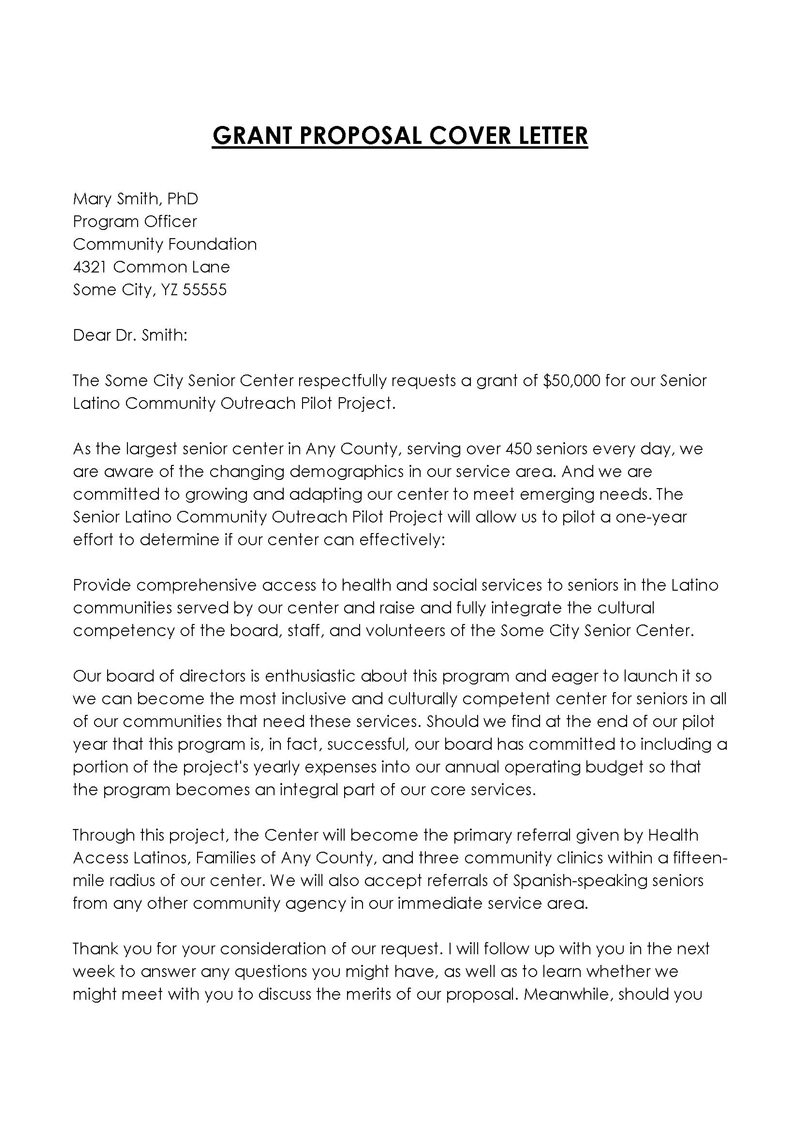
Writing a Grant Proposal Cover Letter
Organizations writing a grant proposal cover letter must ensure they follow a well-outlined process. The step-by-step process ensures that all elements of the grant proposal letter are included. It also helps ensure that the letter is written in an appropriate format.
The following is a step-by-step process of how to write a grant proposal cover letter:
The top of the grant proposal cover letter should include a letter header. The organization’s writer may opt to use a formal header to ensure the letter looks more professional. The information provided in the header will ensure that general information concerning the organization and funder is provided.
The following information should be contained in a grant proposal cover letter header:
The date indicated in the header of a grant proposal cover letter should be the same as the date stated in the complete grant application. Stating the same date on both documents means they are sent to the guarantor on the same day. It helps create consistency in all the documents.
Address the funder
The funder’s name, address, city, state, and zip code should be indicated. The funder’s details provide information on who the letter is for. The funder’s address should appear under the sender’s address. The organization’s writer should confirm the name and address of the funder with a phone call or email the funding body. It will help to ensure the funder’s details have not changed.
Your company details
At the top left of the header, the writer’s company name and address should be provided. The writer’s company details will provide the funder with information on which organization is writing the letter.
Secondly, the organization’s writer must greet the funder with ‘Dear’ and include a recipient’s title such as Mr., Ms., Dr, etc. The salutation should be followed by the funder’s name, which should be punctuated with a comma. The writer can ensure that the right person is being addressed by calling the company or organization meant to receive the letter and confirming the detail.
Introduction
Thirdly, the organization’s writer should be introduced in the grant proposal cover letter. The organization’s legal name, which is its corporate name, should be indicated. In addition, the writer should indicate what the organization does and the need for its work.
Next, the body of the grant proposal cover letter should discuss the project. The information provided in the body will enable the recipient to understand what the organization hopes to accomplish with the grant. The writer should explain what the project is, the purpose it serves, and how it aligns with the funder’s priorities.
The writer can also add any data obtained that shows why the project is necessary. The amount of money the organization requests and the reason or use for the sum should be provided.
The following information should also be outlined in the body of the grant proposal cover letter:
Explain methods, strategies, and solutions
The writer should provide information on how the organization plans to use the grant and the solutions the fund will offer to a problem. The writer can incorporate a visual representation or graphic model of this information. The methods used to represent the organization’s data should be combined with details to ensure that the grant proposal cover letter has a professional tone. The writer can mention a timeline of when the funder should expect to see results.
Explain your corporate structure
The body of the grant proposal cover letter should also contain information on the grant requesting organization’s corporate structure. The writer should indicate that the organization’s internal management structure supports the project. The information on the corporate structure should be brief.
Highlight your strengths
The writer should explain why the organization is the best place to execute the project or mission. Comparison with other organizations can provide clarity on which areas the writer’s organization excels in . The writer may sight the experience of the organization’s staff and volunteers, experience with the problem the project hopes to resolve, or community support for the organization. The names of the other organizations used in the comparison don’t have to be mentioned. The writer’s emphasis should be placed on highlighting the organization’s strengths.
Finally, the concluding paragraph should summarize the information already stated in the grant proposal cover letter. The writer should also include a thoughtful sentiment of what partnering with the funder would mean to the project’s beneficiaries. An expression of the writer’s appreciation for the funder’s consideration of the grant proposal should be indicated. The writer can also extend an invitation for the funder to visit the organization or its worksite.
The writer should end the grant proposal cover letter by signing off with an appropriate word or phrase such as ‘Sincerely,’ an ‘awaiting your response’ or ‘With great hope.’ The sign-off word or phrase used should suit the theme or topic of the letter. The executive board of directors, board president, or both should sign the grant proposal cover letter. The sign-off should indicate the signer’s first name, middle initials, last name, and jobs title. The writer should also provide the contact details of an individual who can answer the funder’s questions.
Note: The word ‘ENCLOSURE’ or ‘ATTACHMENTS’ should be written at the bottom of the grant proposal cover letter. These words help to indicate that the grant proposal is included in the packet. Writing these words in all caps emphasizes the importance of the grant proposal.
Grant Proposal Cover Letter Template
[Organization’s Name]
[Organization’s Address]
[City, State and Zip Code]
[Funding organization’s contact Name]
[Funding Organization’s name]
Dear {funding organization’s contact Name],
[Organization name], which has been around for{number] years, is requesting a grant of ${amount]. The funds will be for an upcoming project, [project title]
Our organization focuses on [organization’s mission]. The project centers on [purpose of the project]. We target [group set to benefit from the project]. The need for the project is supported by our primary research, which found that [ the problem the project aims to solve]
The grant fund provided by your organization will enable us to [how the grant will be applied]. The fund will ensure that [ potential positive impacts provided by the funds]. Our [corporate structure] have expressed their enthusiasm for the project. We believe that our connection with [target beneficiaries] places us in the best position to carry out this project.
We appreciate your consideration. Please feel free to contact [name of organization’s contact] for any questions at [phone number or email].
[Signature]
[Name of CEO/board chair]
Sample Letter
Oracle Literacy Center
245 Hill Street
Boston, MA 46479
May 18th 2020
Neilson White
Waves Discovery foundation
Boston, MA 43578
Dear Mr. White,
The Oracle Literacy center, which has been around for 10 years, is requesting a grant of $ 500,000. The funds will be for an upcoming project, Digital Literacy Academy.
Our organization focuses on bringing literacy to disadvantaged communities in developing countries. The project centers on developing digital skills in Malawi. We target poor, disadvantaged adolescence and children. The need to implement the project is supported by our primary research, which found that less than 4% of the population has digital skills. We understand that your organization aims to increase literacy in developing nations; hence, why we believe that parting with you can help both organizations meet their goals
The grant provided by your organization will enable us to build a learning facility in the outskirts of the capital. The fund will ensure that poor, underprivileged children pioneer a new digital era in the county to facilitate its development. Our board of directors has expressed their enthusiasm for the project. Our connection with the local people places us in the best position to carry out this project.
We appreciate your consideration. For any questions, please feel free to contact James Green at 555-555-7788 or [email protected].
Mary Winters
Executive Director and Manager
Do’s and Don’ts for Writing the Letter
When writing a grant proposal cover letter, it is important to consider the dos and don’ts. Understanding the do’s and don’ts of writing a grant proposal cover letter will ensure that the organization captures the funder’s attention. It will also ensure that the letter is effective in communicating information about the organization and the grant.
The following are the does and don’ts of a grant proposal cover letter:
Following are the dos for a grant proposal cover letter:
The grant proposal cover letter should be a quick read for the funder. Therefore, the writer of the letter should ensure that it is only limited to one page. The contents of the cover letter should be focused and to the point. Each paragraph should be limited to only a few sentences to ensure that the letter is short.
Ask for feedback
Upon completion of the grant proposal cover letter, the writer should ask a co-worker to read it. The co-worker will help identify any typos in the letter. The reception of positive feedback will be an indication that the writer should send the letter. In addition, asking for feedback will help ensure that the grant proposal cover letter effectively compels the funder to consider the organization’s grant proposal.
Format the letter carefully
The writer of the grant proposal cover letter should ensure it is appropriately formatted. A well-formatted grant proposal cover letter ensures that single spacing is applied throughout the letter. There should also be spacing between the organization’s address and the funder’s address. Appropriate spacing should also be applied between paragraphs. If possible, the writer should include a live ink signature. Three blank spaces should be left where writers can indicate a complimentary close and their name for the signature.
Send the cover letter in PDF
The grant proposal cover letter should be in PDF if the writer intends on sending the letter via email. PDF will ensure that the letter is safe from malware. It also helps the foundation sign the letter digitally if it wishes to do so. Sending the cover letter in PDF will also lead the funder to perceive that the organization is competent.
Write the cover letter last
The cover letter should be written last because it helps the organization reflect on achievements such as completing the fund request. It also ensures that the writers provide information from a knowledgeable perspective. The writer also ensures that the cover letter is more engaging than the other documents attached to it.
Don’ts
Following are the don’ts for writing a grant proposal cover letter:
Don’t repeat the information in the proposal
The grant proposal cover letter should not be a repetition of the information contained in the proposal. Its main purpose is for the funder to get to know more about the organization and its project. It is a tool that can persuade the funder to provide the organization with the grant.
Don’t use big words
The writer of a grant proposal cover letter should avoid using complex words that the funder may not understand. The use of complex words could be counterproductive and jeopardize the organization’s chances of receiving the grant. Instead, the writer should only focus on pleading the organization’s case before the funder.
Don’t make grammatical mistakes
The writers should proofread the grant proposal cover letter upon completion. No grammatical mistakes should be present in the document. The presence of grammatical errors may lead to the organization being perceived as unprofessional and lazy.
Key Takeaways
- A grant proposal cover letter effectively provides information about an organization’s grant proposal and shows its commitment to the project suggested to the funder.
- The letter can achieve its effectiveness by providing clear, concise information about the project.
- The organization must ensure that it mentions certain aspects of the project, like its potential beneficiaries.
- The tone of the letter should be professional.
About This Article
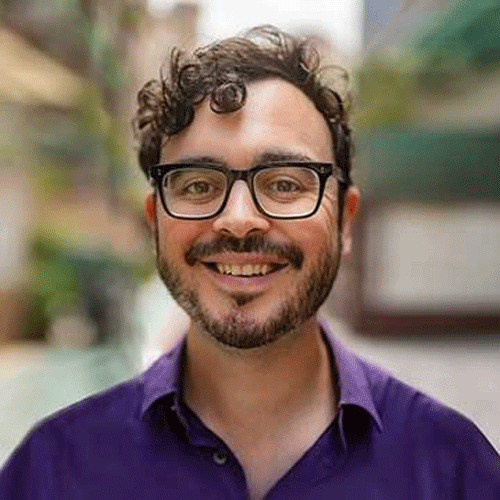
Was this helpful?
Great! Tell us more about your experience
Not up to par help us fix it, keep reading.

Cover Letters
7 great examples of cover letters for job application.

Product Manager Cover Letter (Free Templates)

Real Estate Cover Letter Examples (Expert Tips)

New Graduate Nurse Cover Letter (18 Best Examples)

Graphic Designer Cover Letter (Templates & Sample)

Pharmacy Technician Cover Letter Examples (Expert Tips)

Administrative Assistant Cover Letter Examples + Tips

Business Analyst Cover Letter Examples (Free Templates)

Free Eye Doctor Note Templates

Authorization
Authorization letters to travel with minor.

Sample Landlord Reference Letters for a Tenant

12 Free Vehicle Authorization Letter Templates
Thank you for your feedback.
Your Voice, Our Progress. Your feedback matters a lot to us.
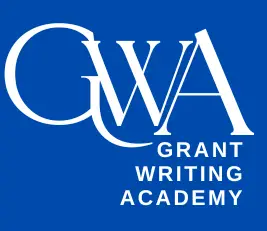
Grant Application Cover Letter
- September 22, 2023
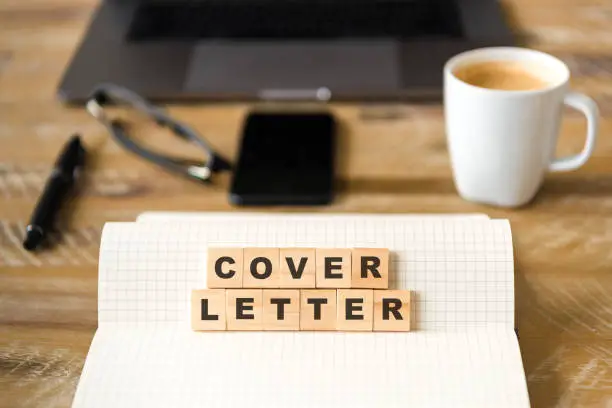
A Grant Application Cover Letter is a formal document that accompanies a grant application, typically addressed to a potential grantor or a funding organization. This letter serves as an introduction to the grant proposal, providing a concise overview of the project or program for which funding is sought.
It plays a critical role in making a first impression and convincing the grantor that the project is worth considering for funding.
The art of crafting a compelling grant application cover letter is integral in navigating the competitive terrain of grant procurement. This initial document serves as a pivotal interface between the applicant and the potential funding entity, reflecting the aspirations, the precision, and the authenticity of the proposed project.
A well-constructed cover letter can be instrumental in shaping favorable impressions, setting the stage for a thorough review of the accompanying application.
The essence of a grant application cover letter is to succinctly communicate the core objectives and anticipated impacts of the proposed endeavor. It acts as a gateway to the intricate details of the application, providing a glimpse into the innovation, relevance, and feasibility embedded within the project.
Given its paramount importance, it is crucial for applicants to meticulously align the content of the cover letter with the ethos and expectations of the funding organization.
In the dynamic landscape of grant procurement, the necessity for clarity, coherence, and congruence in articulating project outlines and objectives cannot be overstated.
The cover letter should resonate with the mission and values of the granting entity, elucidating the synergies between the proposed project and the overarching goals of the funder.
The intricate balance between conciseness and comprehensiveness in presenting the project’s scope and significance is vital in maintaining the interest and curiosity of the reviewers.
The strategic incorporation of pertinent information regarding the applicant’s background, expertise, and the contextual relevance of the project is crucial in establishing credibility and demonstrating commitment.
The inclusion of such elements not only substantiates the feasibility of the project but also reinforces the alignment between the applicant’s capabilities and the project’s demands. It serves to instill confidence in the reviewers about the applicant’s competence and the potential success of the proposed initiative.
Moreover, the articulation of the project’s goals, the anticipated outcomes, and the prospective benefits is essential in elucidating the transformative potential embedded within the proposal.
It provides an opportunity for applicants to showcase the uniqueness and the value proposition of their project, distinguishing it from the plethora of applications. The emphasis on the anticipated impacts and the broader implications of the project fosters a sense of relevance and urgency, compelling the reviewers to delve deeper into the application.
In this realm of incessant competition and evolving expectations, the role of meticulous research and nuanced understanding of the funding organization’s priorities is undeniable. The nuanced tailoring of the cover letter to resonate with the specific interests, values, and mission of the grantor is instrumental in establishing a connection and fostering alignment. The infusion of insights gleaned from thorough research enhances the authenticity and the contextual relevance of the cover letter, optimizing its potential to captivate and convince.
Furthermore, the meticulous attention to detail and adherence to the prescribed guidelines and format is essential in preserving the integrity and the professionalism of the application. The precision in language, the clarity in expression, and the coherence in structure are vital in conveying the seriousness and the sophistication inherent in the proposal. The avoidance of ambiguity, redundancy, and over-complexity is key in maintaining the fluidity and the accessibility of the content.
Understanding the Purpose
A grant application cover letter often serves as the first point of contact between the applicant and the granting institution. The purpose of this crucial document goes beyond merely introducing the project; it acts as a window, revealing the potential, viability, and relevance of the proposed endeavor, and its alignment with the funder’s objectives.
Understanding the purpose of a cover letter in the grant application process is pivotal. It’s the initial framework, setting the tone and providing a concise snapshot of the applicant’s proposal.
This document is vital for creating a strong first impression, reflecting the essence of the project and its potential impact. It lays the groundwork, inviting the grantor to explore the application further, beckoning them into the depths of the envisioned project, its aims, methodologies, and the anticipated outcomes.
Importance of a Cover Letter:
The value of a meticulously crafted cover letter cannot be understated in the world of grant applications. It’s the initial handshake, the first interaction that could make or break the journey of the proposed project. It’s not merely an informative piece but a persuasive document that strives to resonate with the reviewers, subtly conveying the symbiotic alignment between the project’s goals and the funding organization’s mission. It serves to entice, to pique interest, leading the way for the detailed exposition contained within the application.
Role in Creating a First Impression:
First impressions carry immense weight, dictating the subsequent interactions and shaping the perceptions of the reviewers. A well-articulated cover letter is instrumental in constructing a favorable and lasting impression.
It’s the preliminary canvas, painting a vivid picture of the project’s essence, its innovativeness, and its potential to effect meaningful change. The emphasis on clarity, conciseness, and relevance is paramount in ensuring the sustained interest and engagement of the reviewers, steering them towards a deeper exploration of the proposal.
Complementing the Grant Application:
The cover letter and the grant application share a symbiotic relationship, each enhancing the impact of the other. The cover letter serves as a gateway, a concise summary accentuating the pivotal aspects of the project, while the application delves into the intricate details, substantiating the claims and the projections made in the cover letter. This harmonious interplay is crucial in presenting a coherent, comprehensive, and compelling narrative, optimizing the chances of securing the coveted grant.
Setting the Tone:
The tone of the cover letter is a subtle yet powerful element, reflecting the applicant’s approach, attitude, and the level of professionalism. A balanced, respectful, and earnest tone is crucial in establishing rapport and credibility. The infusion of enthusiasm, conviction, and humility can significantly enhance the relatability and the authenticity of the document, fostering a sense of trust and resonance with the reviewers. The deliberate alignment of the tone with the ethos and the expectations of the funding organization is key in optimizing the impact and the persuasiveness of the cover letter.
Essential Components
The crafting of an effective grant application cover letter is akin to constructing a building; every component, every element has a role, ensuring the overall stability, coherence, and impact of the structure. The integral components of a cover letter work in unison to present a well-rounded picture of the project, its relevance, and the prospective benefits, compelling the reviewers to delve deeper into the details provided in the grant application.
A well-structured cover letter is a blend of pertinent information, clear articulation, and strategic emphasis. It consists of several critical elements, each contributing to the overall narrative and impact of the document.
These components, from address to signature, collectively serve to introduce, elucidate, and emphasize the project’s goals, methodologies, anticipated outcomes, and alignment with the funding organization’s mission and values. The meticulous attention to each element ensures the coherence, clarity, and persuasiveness of the cover letter, optimizing its potential to captivate and convince.
Address and Salutation:
The address and salutation set the tone for the interaction, reflecting the professionalism and the attention to detail inherent in the applicant. The accurate addressing of the funding organization and the appropriate salutation are foundational in establishing rapport and conveying respect. The meticulous verification of the organization’s name, the recipient’s title, and the preferred form of address is crucial in avoiding inaccuracies and ensuring a positive first impression.
Introduction:
The introduction serves as the entry point, the initial glimpse into the essence of the proposed project. It’s the succinct articulation of the project’s core objectives, its relevance, and its alignment with the funder’s goals. The strategic emphasis on clarity, conciseness, and relevance in the introduction is vital in capturing the interest of the reviewers and compelling them to explore further. The integration of a hook, a unique angle or insight, can significantly enhance the impact and the memorability of the introduction.
Project Description:
The project description is the heart of the cover letter, providing a concise yet comprehensive overview of the proposed endeavor. It delves into the specifics, elucidating the methodologies, the anticipated outcomes, and the broader implications of the project. The meticulous balancing of detail and brevity is crucial in maintaining the engagement of the reviewers, providing them with a clear understanding of the project’s scope, significance, and feasibility, while fostering a sense of curiosity and anticipation.
Project’s Objectives:
The articulation of the project’s objectives serves to clarify the envisioned outcomes and the intended impacts of the proposal. It’s the clear, coherent presentation of the goals, the transformative potential, and the alignment with the funding organization’s mission. The emphasis on specificity, measurability, attainability, relevance, and time-bound nature of the objectives is essential in conveying the viability and the value proposition of the project, instilling confidence in the reviewers about the prospects of success.
Budget Overview:
The budget overview provides a snapshot of the financial aspects of the project, offering insights into the allocation, utilization, and management of the funds. It’s the transparent, accountable presentation of the financial needs, the justifications, and the anticipated returns on investment. The strategic integration of a budget overview in the cover letter is instrumental in establishing credibility, demonstrating financial acumen, and reinforcing the feasibility and the sustainability of the project.
Closing Remarks and Signature:
The closing remarks and the signature are the final touches, the concluding interactions that re-emphasize the key points and express gratitude for the consideration. The infusion of sincerity, humility, and optimism in the closing remarks is vital in leaving a lasting, positive impression. The professional, respectful signature reflects the earnestness and the commitment of the applicant, serving as a subtle reminder of the authenticity and the integrity inherent in the proposal.
Tailoring the Content
Navigating the nuanced landscape of grant application cover letters necessitates more than just a clear understanding of the project and its components; it requires a meticulous approach to tailoring content. Customizing the narrative to align with the values, interests, and expectations of the granting organization is pivotal in creating resonance and establishing connection.
Tailoring the content of a grant application cover letter is akin to designing a key that perfectly fits a lock. It involves a comprehensive understanding of the funding organization’s mission, goals, and preferences, and aligning the cover letter’s narrative, tone, and emphasis accordingly. This customized approach enhances the relevance and the appeal of the document, optimizing its potential to engage, resonate, and convince. It transforms the cover letter into a dynamic, adaptive entity that speaks directly to the unique needs and aspirations of the grantor.
Understanding the Funder’s Mission:
To tailor content effectively, a profound understanding of the funder’s mission and values is indispensable. This knowledge serves as the foundation upon which the narrative is built, ensuring alignment and coherence with the grantor’s expectations and aspirations. A deep dive into the organization’s objectives, areas of interest, and previous funding initiatives provides insights into their preferences and priorities, enabling the crafting of a narrative that is attuned to their ethos.
Aligning Project Goals:
Once the funder’s mission is discerned, aligning the project’s goals with it is crucial. This involves highlighting the synergies between the proposed project and the grantor’s objectives, emphasizing the mutual benefits and the shared vision. Articulating the project’s objectives in a way that reflects the funder’s interests and values enhances the perceived relevance and value of the proposal, fostering a sense of partnership and shared purpose.
Demonstrating Impact:
The emphasis on the anticipated impacts and benefits of the project is integral in tailoring the content. Demonstrating the transformative potential of the proposal in terms that resonate with the funder’s goals creates a compelling narrative. The quantifiable presentation of the expected outcomes, their broader implications, and their alignment with the grantor’s mission reinforces the feasibility and the significance of the project, instilling confidence and interest in the reviewers.
Using Appropriate Language:
The language used in the cover letter is a subtle yet powerful element in tailoring the content. It reflects the understanding, the respect, and the alignment with the grantor’s culture and values. Adopting a tone and a vocabulary that resonate with the organization’s ethos enhances the relatability and the accessibility of the document. The infusion of terms, phrases, and references that are familiar and valued by the grantor contributes to the authenticity and the appeal of the narrative.
Addressing Specific Criteria:
Funding organizations often have specific criteria and expectations for grant applications. Addressing these explicitly and meticulously in the cover letter is essential in creating a tailored narrative. It demonstrates attentiveness, thoroughness, and alignment with the organization’s standards and requirements. Providing clear, concise responses to the outlined criteria enhances the clarity and the coherence of the document, optimizing its potential to meet the specific needs and expectations of the grantor.
Incorporating Feedback:
If available, incorporating feedback from previous interactions or applications with the funding organization is a strategic move in tailoring content. It reflects adaptability, responsiveness, and a commitment to continuous improvement. Addressing the areas of concern, emphasizing the enhancements made, and reiterating the alignment with the funder’s goals contribute to the credibility and the persuasiveness of the proposal, optimizing its chances of success.
Common Pitfalls and How to Avoid Them
Crafting a compelling grant application cover letter involves navigating around various potential pitfalls. These missteps can significantly hinder the impact and effectiveness of the document, thereby reducing the likelihood of securing the grant.
Identifying common pitfalls in writing grant application cover letters is crucial for avoiding them and enhancing the document’s effectiveness. These pitfalls often revolve around clarity, relevance, conciseness, and alignment with the grantor’s mission and expectations. By being cognizant of these pitfalls and implementing strategic measures, applicants can optimize the cover letter’s coherence, persuasiveness, and appeal, increasing the chances of a favorable reception.
Lack of Clarity:
One common pitfall is the lack of clarity and coherence in presenting the project’s goals, methodologies, and anticipated outcomes. How to Avoid: Prioritize clear, concise articulation of the project’s essence and its alignment with the funder’s mission. Use straightforward language and logical structuring to enhance understanding and engagement.
Neglecting the Funder’s Mission:
Another pitfall is neglecting to align the project’s objectives and impacts with the funder’s mission and values. How to Avoid: Conduct thorough research on the funding organization’s goals, preferences, and previous grants to tailor the content effectively, emphasizing mutual benefits and shared values.
Overloading with Details:
Overloading the cover letter with excessive details and technical jargon can overwhelm the reviewers and obscure the main points. How to Avoid: Maintain a balance between detail and brevity, focusing on the most pivotal aspects of the project. Use accessible language and provide succinct, relevant information to keep the reviewers engaged and informed.
Ignoring Specific Criteria:
Ignoring the specific criteria and guidelines provided by the funding organization can lead to non-compliance and reduced credibility. How to Avoid: Carefully review the application guidelines and address each criterion meticulously, demonstrating attentiveness and alignment with the organization’s standards and expectations.
Overlooking Proofreading:
Submitting a cover letter with errors and inconsistencies can convey a lack of professionalism and attention to detail. How to Avoid: Allocate ample time for proofreading and revisions. Seek feedback from peers or mentors and use editing tools to ensure accuracy, coherence, and polish.
Grant Application Cover Letter Example
Dear Madam Rosy,
I am reaching out on behalf of Girls Empower, a dedicated non-profit organization with a mission to foster learning and development opportunities for young girls from underserved communities.
We believe in the transformative power of education and empowerment to build a foundation for a more equitable, inclusive future. We are fervent advocates of nurturing potential, fostering resilience, and creating platforms for voices waiting to be heard.
We are writing to express our sincere interest in partnering with the Impact Makers Foundation, whose commitment to making a lasting difference aligns seamlessly with our core values and objectives. We humbly seek your support and consideration for a grant amount of $150,000 to launch our initiative titled “E mpowering Futures: Nurturing the Next Generation of Female Leaders.”
The “Empowering Futures” initiative aims to provide holistic education, mentorship, and skill development programs for 200 young girls aged 10-15 in Ohio, focusing on STEM education, leadership training, and personal development. We anticipate that the successful implementation of this project will result in enhanced academic performance, improved self-esteem, and the cultivation of leadership skills among the participants, ultimately contributing to the development of empowered, informed individuals capable of driving positive change in their communities.
We believe our initiative resonates with the mission of the Impact Makers Foundation to cultivate change and foster development in communities in need. The synergies between our goals create a mutual ground for collaboration, wherein we can collectively work towards the empowerment and upliftment of young girls, aiding them in transcending barriers and realizing their fullest potentials.
Our approach combines immersive learning experiences, mentorship programs, and interactive workshops. Each participant will be paired with a mentor to guide them through their journey, fostering a supportive, enriching environment. We anticipate the transformative impact of our program will not only be reflected in the improved academic and personal development of the participants but also in the positive ripple effects it will create within their communities.
The requested grant of $150,000 will be allocated judiciously to cover program development, educational materials, mentorship facilitation, and logistical expenses. We are committed to ensuring transparency, accountability, and optimal utilization of the funds to maximize the impact of the initiative.
We are excited about the prospect of collaborating with the Impact Makers Foundation to bring our shared vision to life. We believe that, together, we can ignite the spark of learning, leadership, and empowerment in the hearts of young girls, creating a wave of positive change that will echo through generations.
We extend our heartfelt gratitude for considering our application and are open to providing any additional information or clarifications required. We eagerly await the opportunity to discuss our proposal further and explore the possibilities of joining hands to make a lasting impact in the lives of the young girls who are the promise of our future.
Thank you for your time, consideration, and dedication to creating a world where every individual has the opportunity to thrive and make a difference.
Joy Martins
Executive Director
Girls Empower
Crafting an articulate and impactful grant application cover letter is truly an art form that combines clarity, coherence, precision, and a deep understanding of both the project at hand and the mission of the funding organization. From understanding the intrinsic purpose of the cover letter to meticulously tailoring the content and avoiding common pitfalls, each step in the process is crucial in constructing a compelling narrative that resonates with the grantors.
This comprehensive exploration has delved into the multifaceted approach required to master the art of writing grant application cover letters.
We’ve navigated through the essential components, the significance of tailoring the content, and the importance of avoiding typical missteps. The insights provided aim to empower individuals and organizations to create powerful, persuasive cover letters that align seamlessly with the values and objectives of funding bodies, thereby optimizing the chances of securing essential grant funding.
Remember, a well-crafted cover letter serves as the gateway to your project, reflecting its essence, its potential, and its alignment with the funder’s mission. It’s the strategic amalgamation of authenticity, alignment, clarity, and relevance that constructs a convincing, memorable narrative.
So, as you embark on your grant application journey, keep in mind the invaluable techniques and insights discussed, and approach the art of writing grant application cover letters with diligence, adaptability, and a profound sense of purpose.
Unlock Your Grant Success!
Join our email list now for exclusive grant-writing tips and unique grant opportunities delivered straight to your inbox. Click here to Subscribe . Don’t miss out!
Elevate Your Grant Writing Game: Dive Deeper with Expert Resources!
If you’ve ever felt the rush of excitement upon spotting a potential grant opportunity, only to be met with the daunting challenge of crafting the perfect proposal, you’re not alone.
Grant writing is both an art and a science, and I’ve distilled years of expertise into a collection of resources tailored to guide you, whether you’re a nonprofit visionary, a rising freelancer, or a small business owner.
Handpicked Titles Just For You:
1. Advanced Grant Writing for Nonprofits : Dive beyond the basics and navigate the intricate nuances to stand out.
2. Becoming the Grant Guru: Embrace your freelance journey with techniques and strategies that ensure success in the grant universe.
3. Mastering Grant Writing: Your nonprofit’s go-to guide for developing compelling proposals that captivate and convince.
4. The Small Business’s Guide to Winning Grants : Tailored insights to ensure your business’s endeavors are backed by the right funding.
Whether you’re taking your first steps in grant writing or seeking to refine your approach, there’s something in this collection for everyone.
Invest in your future now. These titles are available on Amazon, both in Kindle and paperback formats . Arm yourself with the knowledge to not just compete, but to excel.
Dive into a World of Grants Mastery – Grab Your Copies on Amazon
Fuel your passion, secure that funding, and bring your vision to life!
Work With Me: Elevate Your Nonprofit’s Grant Writing Game!
Hello passionate changemakers,
Does your nonprofit organization resonate with these challenges?
1. Feeling overwhelmed by the intricate maze of grant proposal writing?
2. Struggling to secure vital funding due to lackluster proposals?
3. Battling with limited in-house expertise to identify suitable grant opportunities?
4. Frustrated by not knowing how to articulate your mission effectively to potential funders?
If you nodded in agreement to any of these, you’re not alone. But here’s the good news: Together, we can change this narrative.
Why Partner With Me?
I bring to the table a unique blend of expertise and experience. As a seasoned Grant Writing Consultant, I’ve dedicated my career to mastering the art and science of grant writing. But beyond the knowledge, I carry a heartfelt passion for amplifying the impact of nonprofits like yours.
What I Offer:
1. Grant Writing Training: Let’s empower your team! Through comprehensive workshops, I’ll train your staff to craft compelling proposals that captivate, convince, and convert.
2. Personalized Grant Proposal Writing: Leverage my expertise to develop meticulously tailored proposals that reflect your organization’s vision, mission, and impact stories.
3. Strategic Grant Research: Don’t waste hours on unsuitable opportunities. With my deep industry insights, I’ll help identify grants that align with your objectives and values.
4. Report Development: Secure future funding by showcasing your successes. I’ll help you design robust, engaging reports that keep funders connected to your cause.
Our Journey Together:
Our collaboration begins with understanding – diving deep into your organization’s ethos, the communities you serve, and the impact you wish to create. It’s a partnership where your dreams become mine, and together, we’ll weave narratives that resonate, inspire, and secure the resources you need.
Your work in the nonprofit sector is invaluable. Every program initiated, every life touched, every community transformed – it all starts with a well-written proposal that opens doors to necessary funding. Let me be that catalyst for you.
A Future of Possibilities:
Picture this: A future where your nonprofit isn’t just surviving, but thriving. A world where your initiatives are backed by ample funding, and your stories of impact echo in the hearts of donors and communities alike.
So, if you’re ready to ascend the ladder of grant writing success and fuel your organization’s mission with robust funding, I’m here, eager and ready.
Let’s co-create this success story.
Reach out today, and let’s set the stage for a brighter, impactful tomorrow.
Email Address: [email protected]
Related Posts

Grants for Land Conservation
Grants for land conservation are a vital lifeline for preserving natural landscapes, ecosystems, and biodiversity. These financial resources support a wide range of activities, from purchasing land to protect it

Grants for Journalism
Grants for journalism are financial awards or funds provided to individuals, groups, or organizations to support the production of high-quality, public-interest journalism. These grants are essential for sustaining investigative reporting,

Grant Writing Academy is offering you full resources you need to win free money and boost your nonprofit impact.
No thanks, I’m not interested!

How To Write An Effective Grant Proposal | A Nonprofit’s Guide
Before writing a grant proposal, you must understand the basics of grant funding. In this article, we discuss the different types of grants, how to find grants that fit your organization’s needs, nine essential components of a good grant proposal, and provide you with templates, samples and tips to help you get started.
For many nonprofits, grants are very appealing. They can provide the opportunity for an organization or business to make a significant impact on its community that it would otherwise be unable to fund . But before diving into writing nonprofit grant proposals, take a moment to ask yourself:
“Does my nonprofit need to be applying for a grant in the first place?”
Writing effective grant proposals can seem like stepping into a confusing, long labyrinth, and one that comes with many strings attached.
It’s important to know if applying for grants is the right decision to fund your nonprofit, amongst many other funding sources at your disposal. And if so, how much energy should you invest in the process? Now, let’s understand the basics of grants, different types of grants, and how your nonprofit can write an effective grant proposal step by step.
What are Grants?
A grant is a bounty, contribution, gift, or subsidy (in cash or kind) bestowed by a government or other organization (called the grantor) for specified purposes to an eligible recipient (called the grantee). Grants are usually conditional upon certain qualifications as to the use, and maintenance of specified standards, or a proportional contribution by the grantee or other grantor(s). – Business Dictionary
Grants are typically awarded to nonprofit organizations for a distinct program or purpose. Grantmakers generally focus their “giving” on:
- A specific population (such as children or organizations in New York)
- Certain types of nonprofits (such as animal shelters or environmental groups)
- Particular types of support (such as program development or funding for equipment)
What is a Grant Proposal?
A grant proposal is a request that a funder join the nonprofit as a partner to achieve specific results. It is an appeal for money (a grant) that is sent to either a profit or non-profit grant-awarding organization. Every year, many corporations, organizations, and government agencies dispense billions of dollars in grants to companies for addressing issues these organizations are interested in. At its best, a grant proposal must be a persuasive and well-supported argument for change.
Different Types of Grants
Grants can provide different types of support for your organization .
For example:
- Operating support or unrestricted funding is a grant for day-to-day operating costs. It is used to support the general work of an organization and is not dedicated to a particular purpose or project.
- Capital support is most commonly given for specific capital campaigns . These involve building construction or acquisition, land acquisition, renovations, remodeling, or the rehabilitation of property.
- Example: Technology Grants for Nonprofits which can help nonprofits leverage technology for their mission.
Pro tip: Grant-based funding isn’t sustainable alone. It has to be part of a diversified fundraising plan. Many fundraising experts recommend that no more than 20% of your funding comes from grants. Any more than that and you risk sinking your organization if a key grant falls through.
How do I know if I should apply for a grant? And where can I find them?
Grants are not the answer to securing funds quickly or in a pinch. However, they are a great solution for nonprofits raising funds to carry out carefully planned programs.
Read more about where to find grants for your nonprofit here .
Check out winning grant proposals at Grantspace .
The most common myths about nonprofit grants
1. foundations and corporations are like santa claus..
While there’s indeed a lot of money available to nonprofits out there, over 50 billion dollars to be precise, this money isn’t just sitting there waiting for you to ask for it. You’ll need to put the work in, and the requirements can be demanding.
2. Only big nonprofits can apply.
There are grants out there for all types and sizes of nonprofits. In addition to that, while many grants are project-specific, there are plenty of grants that are unrestricted and can fund some of your operating costs or capital campaigns as well.
3. Grant writing is a mysterious, strange art.
While there’s a lot to learn about writing excellent, winning grant proposals, it’s also not magic. Once you know the basics, developing a winning nonprofit grant proposal is quite logical.
How to Write an Effective Grant Proposal [Step-by-Step]

1. Be Prepared
First, create a diversified fundraising plan – where grants are only one of the funding sources. Consider if applying for a grant is the best way to fund the desired project/campaign.
Commit yourself to applying for a grant only if you match all the foundation’s qualifications and are willing to research and write tailored applications for each foundation. Only for the kinds of funding you already identified you are pursuing in your fundraising plan. This will save everyone time and energy.
Additionally, ensure you have the resources and time to research foundations and grant-writing opportunities for your organization. Ask yourself if your organization can accomplish what is asked.
Furthermore, find a qualified writer with experience writing grants, or invest in grant writing training for an existing staff member.
Pro tip: Create a grant calendar that includes all the important dates and deadlines for grants you wish to apply for in the next year or two.
2. Don’t Be Generic
If you want to have any chance at all at getting your grant application approved, you can’t write one generic application and send off duplicates to different foundations. This makes it appear to a reviewer that your application is an afterthought, and that’s not a good thing.
The most essential guideline of them all: you need to tailor your application to whichever organization you’re submitting it to.
To do that, you’ll need to do some intense research. Carefully examine the call for proposals and the organization’s website. This can help you draw connections that may then aid you in preparing your application.
Grantmakers are usually looking for a specific cause or subject to fund, so always make sure to thoroughly read what the grantmaker is interested in understanding. Ensure that it’s relevant to your organization’s mission before applying.
Pro tip: Never compromise your mission or beliefs to get any kind of funding.
3. Data Yet Again
Data is what wins grants.
Even if you hire the most experienced grant writer , messy data throughout the organization will prevent grant writing from ever getting started. If you don’t collect relevant data, manage and update it, there’s not much that can be done.
A warm story might get someone to give you $20 out of their pocket. But a foundation with $50,000 grants can’t give based on heart-warming stories alone.
Successful grant applications focus on the impact. The best grant proposals distill in clear and plain language the need the grant will address and the unique approach that the organization’s proposed initiative takes to do so.
Pro tip: Search the Internet for previously funded grant applications posted online by organizations that received grant awards. Study a mixture of grant applications funded by the federal government, foundations, and corporations.
Before Submitting the Grant Proposal
1. review and get a fresh perspective.
When we’ve been reading, speaking, living, and breathing our nonprofit – we can become a bit blind to the language we’re using.
Assume that the funder isn’t familiar at all with the work that you do. Write as if the funder will be hearing about your nonprofit for the first time.
Avoid jargon and abbreviations. If you’re struggling to take a step back, it can be helpful to ask someone less familiar with the work that you do to take a look and give you their feedback (e.g. a friend or a willing acquaintance).
2. Get Clear And Concise
Funders will lose interest if your application is too difficult to understand or takes too much of their time.
No one should be trying to figure out what you’re trying to say or what you’re asking for the money for. Be clear and straightforward in your request.
3. Double-Check the Grant Application
- Double-check spelling, calculations, and due dates.
- Make sure to include all the required forms and necessary attachments by checking the submissions package.
- Check that page number and font size requirements are followed and that documents are presented in the order described.
- You may need to have your CEO and the Board President sign the cover sheet or letter.
- Pay attention to character limits.
- Have another staff member review the budget lines.
- Have a clear contact from your organization.
Grant Proposals: The Basics
Before sending over a full grant proposal, you’d typically first send a letter of inquiry. Many trusts and foundations require a letter of inquiry or request for an application before submitting your application.
The letter of inquiry serves as an introduction to your project and a way to gauge interest from the funding committee. If they want additional information, they will respond with a request for a more in-depth proposal.
The letter should be no longer than two pages.
In the letter of inquiry, be as specific as possible. Add examples in a concise, succinct manner. Keep language simple and avoid ambiguous or general generic statements.
Following the letter of inquiry, if you’re invited to send a more in-depth proposal, you’d typically send a 7-10-page document providing more information about your organization, the project, the needs, and the outcomes. This proposal typically includes a cover letter and appendices, as well.
Note that some grant foundations prefer a concise proposal of about 3-5 pages instead of this typical longer proposal. This one is sometimes referred to as a letter of proposal.
9 Essential Components of a Good Grant Proposal [Template Included]
Note that different foundations and grantmakers might require a different format. Always carefully read the call for proposals before embarking on the writing process.
The grant proposal writing process consists of the following stages:
1. Proposal Summary
Provide a short overview of the entire proposal. Include the funds you’re requesting through the grant, as well as the resources that others will contribute.
2. Introduction to the Applicant
Describe your nonprofit organization and make a case for your credibility. Explain why you can be trusted to steward the funds responsibly. Also share your organization’s history, your success record, and why you’re the right fit for the project.
3. The Need/The Problem Statement
Establish the need for your project. Demonstrate who will benefit and how they will benefit. State the consequences of not funding the project and the needs not being addressed. This should be a factual, well-documented description of the situation. Share about what concerns you and why it matters.
Pro tip: Incorporate a case study of a real beneficiary your organization has served. Show a real need for a real person (of course – change the name for confidentiality reasons). Explain your time frame, and why securing funding is critical now.
4. The Objectives and Outcomes
What are the desired outcomes? Define the goals and state how you will measure whether you’ve achieved them. Lay down the specific, measurable outcomes you expect your project activities to produce. Objectives should be consistent with your statement of need.
5. Program Plan
How are you going to execute the project? Describe how you will achieve the objectives. What will be your key activities? Provide thorough details about them. Who will do what? When and how will they do it?
6. The Capacity
You also need to explain how your organization is preparing for the project. For example, do you have adequate, trained staff and a supportive board and community? Connect this to the time frame – how will you execute your program plan in time?
7. Evaluation Plan
Describe how you’ll evaluate that the objectives have been reached. How will you track and measure whether activities are rolling out as planned? How will you know you’re succeeding and what will tell you that?
8. Program Budget
Provide a thorough and realistic budget. You must try to include details of expenses as well as other sources of anticipated revenue. For instance, such as by the applicant organization or the resources that other partners will contribute.
9. Sustained Impact
Talk about the long-term. Does your project need continuous funds or is it a one-time undertaking? How will you continue to produce impact beyond the period of grant funding?
Note: Some funders may require that you attach specific documents to your proposals, such as your organization’s 501(c)(3) letter from the Internal Revenue Service, a list of your board directors and their affiliations, your current operating budget, or letters from partner organizations.

Grant Proposal Cover Letter (Format, Samples, and Tips)
Your Grant Proposal Cover Letter Must Include:
- The project is mentioned in the very first line.
- A request for the grant amount
- Description of how this project is important, and how it will further the foundation’s mission.
- List the contents of the proposal
- References to previous contacts with the foundation if any
- Contact details in case the funder wants any additional information
- A cover letter signed by your organization’s executive director
Cover Letter Format
Find the cover letter format here.
A sample cover letter and sample grant proposal can be found here .
Key Tips & Strategies for Grant Proposal Cover Letter
- Keep your cover letter brief and to the point
- Make sure it does not repeat the information that is already in the proposal
- Show the reader how well you understand the funder and how your grant fulfills the funder’s requirements
- Your first paragraph should be short and succinct. Introduce your organization and tell the funder how much money you are requesting and why.
- Include a sentence or two about what your organization does, and one research-based point that shows the need that your organization addresses.
- Limit your cover letter to one page with three or four paragraphs.
- Use the same date that you’ll be sending the complete grant application to the funding source. You want to create documents that are consistent.
- Close your cover letter with a summarizing paragraph. Share a closing thought about what this funding partnership can mean for the future of your project’s target audience.
- At the bottom of your letter, include ENCLOSURES or ATTACHMENTS.
Examples of Grant Proposals for Nonprofit Organizations (Sample):
Take inspiration from some of the most successful grant proposals:
- Kennett Area Senior Center: This application was submitted to the community foundation in the county where the Kennett Area Senior Center operates to request funding to provide needed services and assistance to local senior citizens. Read and learn from it here .
- Arts Funding Grant Proposals: This proposal is another example of a comprehensive and well-written grant proposal. Read it here .
- Sample Youth Program Funding Proposals: Here are examples of William T Grant Scholars Proposals. Read them here .
Here’s a podcast for you on growing your grant potential, that you may find helpful:
Over To You
Winning a grant is almost like completing a long-distance run. Grant applications are often rejected the first time.
It’s important to have an existing relationship with the grant-giving organization to improve the likelihood of acceptance. Like all fundraising , no might mean “no for now” and much of it boils down to relationships.
For that reason, if your grant proposal is rejected, respond graciously. Contact the funder to ask if you might try to submit again with appropriate changes or if they might still be interested later in a different project. However, don’t become a pest or turn sour – don’t burn the bridge!
You may not be able to control everything that influences the decisions of grant-givers. However, you can increase your chances of approval by clearly communicating your organization’s mission and credibility, stating the need for the project how you’ll be meeting that need, and your passion for what you are trying to accomplish.
Choose Donorbox as your donation system and check out our Nonprofit blog for more nonprofit resources and tips.

Raviraj heads the sales and marketing team at Donorbox. His growth-hacking abilities have helped Donorbox boost fundraising efforts for thousands of nonprofit organizations.

Related Articles


Top Tips and Sources to Find Grants for Your Nonprofit
Communicating with Grant Makers | Tips and Insights
Join the fundraising movement.
Subscribe to our e-newsletter to receive the latest blogs, news, and more in your inbox.

We use essential cookies to make Venngage work. By clicking “Accept All Cookies”, you agree to the storing of cookies on your device to enhance site navigation, analyze site usage, and assist in our marketing efforts.
Manage Cookies
Cookies and similar technologies collect certain information about how you’re using our website. Some of them are essential, and without them you wouldn’t be able to use Venngage. But others are optional, and you get to choose whether we use them or not.
Strictly Necessary Cookies
These cookies are always on, as they’re essential for making Venngage work, and making it safe. Without these cookies, services you’ve asked for can’t be provided.
Show cookie providers
- Google Login
Functionality Cookies
These cookies help us provide enhanced functionality and personalisation, and remember your settings. They may be set by us or by third party providers.
Performance Cookies
These cookies help us analyze how many people are using Venngage, where they come from and how they're using it. If you opt out of these cookies, we can’t get feedback to make Venngage better for you and all our users.
- Google Analytics
Targeting Cookies
These cookies are set by our advertising partners to track your activity and show you relevant Venngage ads on other sites as you browse the internet.
- Google Tag Manager
- Infographics
- Daily Infographics
- Popular Templates
- Accessibility
- Graphic Design
- Graphs and Charts
- Data Visualization
- Human Resources
- Beginner Guides
Blog Business How to Write a Grant Proposal [Templates Included]
How to Write a Grant Proposal [Templates Included]
Written by: Tobi Ojenike Feb 28, 2024

If you work for a nonprofit organization or are a researcher, you’ll know that a grant proposal is a document submitted to a funding agency.
Grant proposals are also known as a request for application, notice of funding opportunity, or request for quotes and qualifications.
Grant proposals are your chance to convince grantmaking bodies (agencies that distribute funds) to hand over money. Generally, grant proposals include information such as an organization’s mission and budgetary needs.
In this post, I’ll show you how to write a successful grant proposal (tips and templates included!) and then teach you how to make a grant proposal using a Proposal Maker and grant proposal templates .
Click to jump ahead:
- Factors to consider before writing a grant proposal
How to write a grant proposal
Sample grant proposal templates.
- How to create a grant proposal with Venngage
Here are some things to consider before writing a grant proposal
- Audience: Consider your target audience and tailor your copy to their interests and needs.
- Funding: Choose your funder carefully. Always have an alternative list of potential funders and know the long-term sustainability of your project.
- Understand the grant requirements: Every grantmaking body sets its own rules regarding goals, application deadlines, and guidelines, so make sure you understand them and can differentiate between them.
- Have a plan : Create a specific, actionable plan for what you want to do and why. Make sure you know how your plan will achieve positive results.
- Write a draft : Research and write down each request in an outline. Plan how you’ll add visuals to give your grant proposal an extra edge.
- Be clear and concise: Avoid writing in the past tense and use action verbs. Again, visuals can sometimes be a better option over words.
- Include supporting materials : Provide a budget of how you’ll use the funds and include evidence to substantiate any claims you make.
Other helpful tips to consider
Here are some extra tips to help you write a grant proposal that stands out.
- Start early
- Apply early and often
- Get feedback and revise your proposal accordingly
- Be brief, concise and clear
- Be organized and logical
- Be explicit and specific
- Be realistic in designing the project
- Follow up after the proposal
Grant writing can be tricky, but it doesn’t have to be if you understand the basics.
In this section, I’ll give you tips on how to write grant proposals that’ll impress prospective funders (grant writers take note!).
Include a cover letter
The cover letter is not technically part of a grant proposal but they’re core to a successful grant application because it helps funders understand who you are.
Busy decisionmakers want to know who they’ll be funding and look for clues in your cover letter after reading through your proposal.
In your cover letter, don’t be afraid to bring out your personality, but also make sure you cover the basics like how your project fits with the funder’s objective.

Include an executive summary
The executive summary is probably the first (and maybe only) part of a grant proposal read by a funding organization.
It needs to be concise and summarize key points such as goal, strategy, people involved, expected results, and budgetary needs.
Here’s an example executive summary for some inspiration.

Provide organizational information
Providing organizational information in a grant proposal helps build credibility and establishes trust.
More importantly, this section allows funders to assess the alignment between their funding priorities and your organization’s goals and activities.
Therefore, make sure to answer questions like: What is your mission? Do you have an organizational history? What will be the impact of this project? What other programs or services do you render?
Here’s an example of background organizational information you can make your own.

State your objective(s)
Early in your grant proposal, you should state the objectives of your project, the target audience, and expected results.
This underscores the feasibility of your project within a grant timeframe and can influence funders’ decision on a project’s worthiness (i.e.; the difference between a yes and no).
Here’s a great example of a grant proposal that nails this section.

Describe the statement of needs
The statement of needs section is used to build strong case for your project.
In this section, use data, facts and figures to back statements. This will be more meaningful than just words alone.
But make sure your data is accurate. There’s nothing worse than misleading information which can lead to rejections and damage your reputation.
Here’s a grant proposal template that has a customizable statement of needs.

Explain your methods and strategies
You’ve identified a problem and solution, but how are you going to achieve what you plan to do?
That’s what the methods and strategies section is for. Here, potential funders want to see how you’ll use their funds to determine if the project is viable.
For example, maybe your objective is to enhance community health through a mobile clinic initiative.
Detail each step of this process from procurement of medical equipment and vehicles, recruitment and training process for healthcare professionals, and logistics for deploying mobile clinics.
Here’s an example of a grant proposal that first lists goals and objectives and immediately provides an overview of the path to success.

Include an evaluation plan
When funders hand out money, they have certain conditions, like making sure you are held accountable of project progress. Often, you’ll only get more money to continue as you complete milestones.
The evaluation plan section is where you show funders how you’ll spend money as described in your grant proposal to ease their fears and doubts.
This section also shows funders that you have a realistic timeline for the project and that you’re not using the funds for any other purposes.

Include a project budget
Perhaps the most part of your grant proposal is the project budget. This is where you reveal exactly how you’ll be using funds.
Be transparent and provide a full overview of expenses and detail where and how it’ll be spent.
A great way to do this is to use an itemized table or financial plan.
When presenting an overall sum, make sure you don’t overstate or understate your needs. You don’t want funders to doubt your true intent or doubt project viability.
Here’s a grant proposal with a budget section you can use.

Include a financial sustainability plan
Most grant writers overlook including a long-term financial sustainability plan.
Most funders view grants as a long-term investment and want to back projects that can be sustainable even after the money stops rolling in.
Demonstrating a clear understanding of these factors shows funders that you have thoroughly considered the project’s financial trajectory and are prepared to manage it responsibly.
What should you include here? Total cost of future ownership, maintenance costs, inflation, ongoing, and future growth potential are a few ideas.
Sign off with your team information
Treat grant proposals as official documentation.
At the end of your grant proposal, include your (or your company’s) contact details. This makes it easier for the funders to reach out to you and do their research on you and your team.
Here’s an example of a grant proposal with a great ‘about us’ section.

Now that you understand the basics of a grant proposal, it’s time to get to work and create your own.
But you don’t need to start from scratch. Instead, edit these grant proposal templates and convert them into your own winning proposal
(Hint: visit the links to see the entire template).

How to create grant proposals with Venngage
If you want to create grant proposals that grab attention, look no further than Venngage.
With Venngage, you can you communicate boring technical info with engaging visuals and customize our professionally-designed grant proposal templates.
You don’t need to be a designer to use Venngage. If you know how to work Microsoft Word or Google Slides or similar tools, you can use Venngage.
Step 1 – Sign up for a Venngage account (it’s free!)
Sign up for a Venngage account for free using your email, Gmail or Facebook.

Step 2 – Go to the “Templates” page and select “Proposals”
Venngage already has grant proposal templates you can edit to suit your idea and vision.
To find them, go to our templates page and choose the “Proposals” category. After selecting it, this screen should load.

Note : Some of our grant proposal templates are free to use and some require a small monthly fee. Sign-up is always free, as is access to Venngage’s online drag-and-drop editor.
Step 3 – Select the “grant proposal” subcategory
Look for the grant proposals subcategory in the proposals template page and select it.

Step 4 – Customize your grant proposal
Browse our selection of grant proposal templates. Once you find one you like, click on it to launch the editor tool.
Here, you’ll be able to add your own text, change the design, and customize the template as you like.
Some of your customization options include:
- Add engaging visuals and symbols
- Change color scheme
- Change the fonts and text to match your brand or style
- Move elements around with a drag and drop interface
For example, let’s pretend I chose this grant proposal template to customize.
Let’s edit this together.

For example, I want to replace the logo to reflect my company. Well, just select it and click the “ Replace ” feature on the top left.

Once you click “ Replace “, a tab will open where you can select visuals from our library of icons. You can also upload an image (your logo).
By the way, our in-editor library has thousands of free, professional icons, plus diverse icons.

Now, let’s say I want to change the background color of some of my template.
That’s easy as well! Just select the text or background and select the “Replace” feature again. This time, you’ll be prompted with another pop-up where you can select a different color.

If you sign up for a Business Plan, you’ll also get access to My Brand Kit . With this, you can apply your brand colors to any design with one click.
Step 5 – Save, share, or download your grant proposal
When your grant proposal is complete, you can save it as a PDF or PNG file if you’re on a Business Plan.
However, all users will always have access to shareable link that they can send potential funders.

Final thoughts: Create grant proposals with Venngage and secure funding today
A well-structured grant proposal with appealing visuals can make a lasting impression on funders and tip the balance in your favor.
Don’t waste your time with tools like Word, Google Docs where you’ll get limited design flexibility and visuals that don’t engage.
Instead, head over to Venngage’s grant proposal templates to give yourself a winning edge.
Frequently asked questions
How long is a grant proposal?
The length of a grant proposal depends on the funder but a typical grant proposal is usually between 5-20 pages. The funding body might request additional documents as well, so it’s important to know funding guidelines.
What is the writing style for a grant proposal?
The writing style for a grant proposal is formal. You want to be concise and objective, so focus on clarity, impact and your alignment with the priorities of the funder.
What is the lifecycle of a grant proposal?
The grant proposal lifecycle begins with research, planning and development, followed by drafting, revising and editing the narrative and budget. Applications are then submitted before funders review and make decisions. If successful, negotiations may occur to finalize details, after which the funded project is implemented according to the approved plan. Finally, progress and final reports are submitted to the funder. This cyclical process ensures accountability and project success.
What is the difference between a proposal and grant proposal?
Proposal is a broader term encompassing various applications for funding, resources, or partnerships whereas a grant proposal specifically refers to an application for grant funding from a foundation, government agency, or other organization.
What is the difference between a grant proposal and a grant letter?
A grant proposal is a detailed document that includes the project description, methodology, financial plan, and financing rationale. A grant letter, on the other hand, can be a more straightforward request or statement of interest.
Discover popular designs

Infographic maker

Brochure maker

White paper online

Newsletter creator

Flyer maker

Timeline maker

Letterhead maker

Mind map maker

Ebook maker
How to Write an Effective Grant Proposal Cover Letter
Make It Brief but Inviting
Image by Ran Zheng é The Balance 2020
- Nonprofit Organizations
- Retail Small Business
- Restauranting
- Real Estate
- Import/Export Business
- Freelancing & Consulting
- Food & Beverage
- Event Planning
- Construction
- Operations & Success
- Becoming an Owner
When Do You Include a Cover Letter?
Attributes of a good cover letter, formatting your cover letter, how long should the cover letter be, sample cover letter, mistakes to avoid in your cover letter, make your cover letter stand out.
Joanne Fritz is an expert on nonprofit organizations and philanthropy. She has over 30 years of experience in nonprofits.
Although the main parts of your grant proposal will take up most of your time and energy, don't shortchange your cover letter. Attention to the subtler points of putting the proposal package together can make or break a funding request. Don't turn off your funder with a sloppy cover letter.
Mim Carlson and Tori O'Neal-McElrath, authors of Winning Grants, Step by Step , point out that the cover letter should:
- Introduce your organization to the correct person.
- Assure the funder that this project has the support of your board of directors .
- State what you are asking for - how much and for what.
Use a cover letter for proposals to corporations and foundations, but not for federal or state grant applications. Those funders only want what they ask for, and they rarely ask for a cover letter.
Your cover letter should:
- Get to the point quickly
- Does not repeat the information that is in the proposal
- Tell the reader how well you understand the funder and how your grant fulfills the funder's requirements
Beverly A. Browning, the author of Grant Writing for Dummies , suggests that you write the cover letter after you've completed the entire proposal, and when you are in a reflective mood. Browning says:
"As you consider your great achievement (the finished funding request), let the creative, right side of your brain kick in and connect your feelings of accomplishment to the person who will help make your plans come true."
- Use your organization's letterhead. Put the same date on the cover letter that is on the completed grant application. That is the date you will send the grant proposal to the grantor. Using the same date makes all the documents in your proposal package consistent.
- For the inside address (goes at the top of the letter) use the foundation or corporate contact person's name and title, followed by the funding source's name, address, city, state, and zip code. Double-check this information with a telephone call or an email. Such information changes frequently, so make sure you have the current name and address.
- In your salutation, use "Dear" plus the personal title (Mr., Ms., Mrs., Dr., Messrs., etc.), followed by the last name. It is critical that you address the letter to a particular person. Call the foundation or corporate office to make sure you have the right person and the correct personal title. These details may seem unimportant, but they do matter.
- Your first paragraph should be short and focused. Introduce your organization (its legal name, which will be your corporate name ) and tell the funder how much money you are requesting and why. Include a sentence or two about what your organization does, and then include one research-based point that shows there is a need for what your organization does.
- Write one or two more brief paragraphs. State your project's purpose and how it fits with the funder's mission or funding priorities. Include the fact that your board of directors fully supports the project.
- End your letter with a summarizing paragraph. Add what this funding partnership can mean for your project's target audience. You might want to include an invitation for a site visit as well.
- Use a closing such as "Sincerely."
- The letter should be signed by the executive director or the board president, or both. Below the signature, type the signer's first name, middle initial, last name, and job title. Although the ED or board president should sign the letter, do include the contact information for the best person to answer questions at the end of the last paragraph.
- At the bottom of the letter, include the word, "ENCLOSURE" (in all caps).
Limit your cover letter to one page with three or four paragraphs. It should be a quick read.
The tone and specifics of your cover letter may vary depending on whether you've been invited to submit a full proposal after sending a Letter of Inquiry (LOI) , or if this project is your organization's first approach to this particular foundation.
Mary Smith, PhD
Program Officer
Community Foundation
4321 Common Lane
Some City, YZ 55555
Dear Dr. Smith:
The Some City Senior Center respectfully requests a grant of $50,000 for our Senior Latino Community Outreach Pilot Project.
As the largest senior center in Any County, serving over 450 seniors every day, we are aware of the changing demographics in our service area. And we are committed to growing and adapting our center to meet emerging needs. The Senior Latino Community Outreach Pilot Project will allow us to pilot a one-year effort to determine if our center can effectively:
Provide comprehensive access to health and social services to seniors in the Latino communities served by our center, and
Raise and fully integrate the cultural competency of the board, staff, and volunteers of the Some City Senior Center.
Our board of directors is enthusiastic about this program and eager to launch it so we can become the most inclusive and culturally competent center for seniors in all of our communities that need these services. Should we find at the end of our pilot year that this program is, in fact, successful, our board has committed to including a portion of the project's yearly expenses into our annual operating budget so that the program becomes an integral part of our core services.
Through this project, the Center will become the primary referral given by Health Access Latinos, Families of Any County, and three community clinics within a fifteen-mile radius of our center. We will also accept referrals of Spanish-speaking seniors from any other community agency in our immediate service area.
Thank you for your consideration of our request. I will follow up with you in the next week to answer any questions you might have, as well as to learn whether we might meet with you to discuss the merits of our proposal. Meanwhile, should you have any questions, please feel free to contact Connie Jones, our Director of Development, at (555) 555-5555, x555, or cjones@scsc.org.
Jane Lovely
Executive Director
*Letter reprinted (with modifications) with permission from Winning Grants, Step by Step, Second Edition, Tori O'Neal-McElrath, Jossey-Bass, 2008.
- Writing too much. A cover letter is not a dissertation, nor is it a full proposal. Keep it short and to the point Tip: Have someone else read it. Do they understand it?
- Using big words . If you've been to graduate school, you learned to write in a complicated way. Don't do that here. You're not trying to impress someone with your erudition. You only want to state your case as naturally as possible. If you don't know when you're overcomplicating your writing, use an app such as Hemingway . It will tell you when your sentences are hard to read and when you are too wordy.
- Making Grammatical Mistakes . If you're not sure of your grammar, don't take chances. Use the grammar check in WORD, and, also run your draft through an app such as Grammarly . There is a free version, but the paid version goes well beyond the necessary grammar check.
Sad to say, but your grant proposal may be among hundreds or thousands that a typical foundation will see during an average year. Your cover letter can make the difference in getting to the next step towards funding. But how can you make it stand out?
Don't try anything "cute," as foundation officials will not be impressed.
The cover letter would not be appropriate for a story about a client , although you should have a story for other parts of your proposal, such as the description of the problem. Include a paragraph about why your organization is the one that can best accomplish this mission. Survey your competitive organizations and assess just how and where you excel. That may be in the strength of your staff and volunteers, your experience with this particular problem, or the community support you enjoy.
You don't need to mention the names of competitors or criticize them. Just highlight your strengths. This would be a good time to consult with others around the office. Pull a few people together and brainstorm how your nonprofit excels.
Fundamentally, the cover letter should be forward moving, easy-to-read and compel the reader into the larger proposal. Don't put any obstacles in the way of the reader that might deter them from reading further.
Sample Letter Requesting Funds for Project: Free & Effective
In this article, I’ll share a step-by-step guide, complete with a customizable template, to help you write an effective letter requesting funds for your project.
Key Takeaways Understand Your Audience : Research the potential funders to tailor your letter. Clear Project Description : Provide a concise yet comprehensive overview of your project. Specify Funding Needs : Clearly state how much funding you need and how it will be used. Highlight Impact : Emphasize the potential impact and benefits of your project. Professional Tone : Maintain a formal and respectful tone throughout the letter. Proofread and Edit : Ensure your letter is error-free and well-organized. Follow-up : Be prepared to follow up after sending your letter.
Understanding Your Audience
Before you start writing, it’s crucial to understand who you’re writing to. Research the potential funders to learn about their funding priorities and guidelines. This knowledge will help you tailor your letter to align with their interests.
Step-by-Step Guide to Writing the Letter
- Start with a Strong Introduction : Begin with a brief introduction of yourself or your organization. Clearly state the purpose of the letter – to request funding for your project.
- Describe Your Project : Provide a clear and concise description of your project. Explain what it is, its objectives, and why it’s important.
- Explain the Need for Funding : Articulate why you need the funding and how it will contribute to the success of your project. Be specific about the amount required.
- Highlight the Impact : Discuss the potential impact and benefits of your project. Explain how it aligns with the funder’s objectives.
- Provide a Timeline and Budget : Include a brief timeline of your project and a simple budget overview. This shows you have a clear plan in place.
- Include Supporting Documents : Mention any additional documents you’re attaching, such as a project plan or budget details.
- Conclude with a Thank You : End your letter by thanking the reader for considering your request and providing your contact information for further discussion.
- Signature : Sign off professionally with your name and title.
Template for a Funding Request Letter
[Your Name] [Your Title] [Your Organization] [Your Address] [City, State, Zip Code] [Email Address] [Phone Number] [Date]
[Recipient’s Name] [Recipient’s Title] [Organization] [Address] [City, State, Zip Code]
Dear [Recipient’s Name],
Trending Now: Find Out Why!
I am writing to respectfully request funding for [Project Name], a project initiated by [Your Organization]. Our goal is to [briefly state the objective of the project].
[Describe your project in more detail, focusing on its objectives, why it is necessary, and its expected impact.]
We are seeking financial support of [specific amount] to [briefly state what the funding will be used for]. This funding is crucial for [explain why the funding is necessary and how it will benefit the project].
[Provide a brief overview of the project timeline and budget. Mention any other sources of funding, if applicable.]
Attached to this letter, you will find [list any supporting documents you’re including, such as a detailed project plan or budget].
Thank you very much for considering our request. I am looking forward to the opportunity to discuss this project with you in more detail. Please feel free to contact me at [your contact information].
[Your Signature (if sending a hard copy)] [Your Printed Name]
Key Points to Remember
- Personalize Your Letter : Tailor your letter to the specific funder.
- Be Concise but Comprehensive : Provide enough detail to make a compelling case without overloading the reader with information.
- Professionalism is Key : Maintain a formal tone and proofread your letter for any errors.
Comment Request
I’d love to hear your thoughts and experiences on writing funding request letters. Have you tried any of these tips? Do you have any additional advice to share? Please leave your comments below!
Frequently Asked Questions (FAQs)

Q: How Do I Start Writing a Funding Request Letter for My Project?
Answer: When I begin writing a funding request letter for my project, I start by clearly stating the purpose of the project and its significance. I make sure to grab the attention of the potential funder in the first paragraph by emphasizing the impact and unique aspects of the project.
Q: What Information Should I Include About My Project in the Letter?
Answer: In my experience, it’s crucial to include detailed information about the project. This includes the objectives, target audience, anticipated outcomes, and a clear implementation plan. I also make sure to explain why my project stands out and how it aligns with the funder’s interests.
Q: How Should I Address the Budget in the Funding Request Letter?
Answer: I always address the budget clearly and transparently. I provide a detailed budget breakdown, explaining how each amount will be utilized. This shows the potential funder that I have a well-thought-out plan and am responsible with financial resources.
Q: Is It Important to Include My Project’s Background and My Credentials?
Answer: Absolutely! I include a brief history of my project and its successes so far, if applicable. I also mention my credentials and experience to establish credibility and assure the funder that their investment is in capable hands.
Q: How Do I Conclude a Funding Request Letter Effectively?
Answer: To conclude effectively, I reiterate the importance of the project and its potential impact. I express gratitude for the funder’s consideration and include a call to action, inviting them to contact me for further discussion or to arrange a meeting.
Related Articles
Hardship letter for 401k withdrawal example: free & effective, birth certificate request letter sample: free & effective, name change request letter sample, sample letter for name correction: free & effective, sample confirmation request letter for receiving christmas party money, [sample] letter requesting an interview for job, leave a comment cancel reply.
Your email address will not be published. Required fields are marked *
Start typing and press enter to search
RELATED TOPICS
- What is Grant Writing?
- Grant Writing Process
- Grant Writing Templates
- Grant Writing Examples
- Grant Proposal Budget Template
- How to Write a Grant Proposal
- How to Write a Grant Proposal Cover Letter
- Grant Writing Books
- Grant Writer Role
- How to Become a Grant Writer
- Grant Writer Salary
- Grant Writer Resume
- Grant Writing Skills
- Grant Writer LinkedIn Profile
- Grant Writer Interview Questions
- Content Strategist
- How to Become a Content Strategist
- Content Strategist Skills
- Content Strategist Interview Questions
- Content Strategy Manager Overview
- Content Strategy in UX
- Content Strategist Portfolio Examples
- Content Design Overview
- Content Designer
- Content Designer Skills
- Content Design Books
- Technical Documentation
- Knowledge Base Documentation
- Product Documentation
- User Documentation
- Process Documentation
- Process Documentation Templates
- Good Documentation Practices
- HR Document Management Best Practices
- Software Documentation Examples
- How to Test Documentation Usability
- Document Control Overview
- Document Control Process
- Document Control Procedures
- Document Control Numbering
- Document Version Control
- Document Lifecycle Management
- Document Management Software Workflow
- Document Management Practices
- Github Document Management
- HR Document Management
- Confluence Document Management
- What is a Document Management System?
- Document Control Software
- Product Documentation Software
- HR Document Management Software
- Knowledge Base Software
- Internal Knowledge Base Software
- API Documentation Software Tools
- Knowledge Management Tools
- Document Management Software
- What is Software Documentation?
- How to Write Software Documentation
- How to Write API Documentation
- Document Manager
- Documentation Manager
- Documentation Specialist
- Document Control Manager Salary
- Business Writing Overview
- Business Writing Principles
- Best Business Writing Examples
- Best Business Writing Skills
- Best Business Writing Tips
- Types of Business Writing
- Best Business Writing Books
- Proposal Writing Overview
- How to Become a Proposal Writer
- Proposal Writer Role
- Proposal Writer Career Path
- RFP Proposal Writer
- Freelance Proposal Writer
- Remote Proposal Writer
- Government Proposal Writer
- Proposal Writer Salary
- Proposal Writer Job Description Example
- Proposal Writer Interview Questions
- How to Write a Proposal
- Proposal Writer LinkedIn Profile
- Business Proposal Examples
- UX Writing Overview
- Information Architecture
- Information Architecture vs Sitemap
- UX Writing Books
- UX Writing Examples
- UX Writer Overview
- Freelance UX Writer Overview
- UX Writer Career Path
- How to Become a UX Writer
- Google UX Writer
- UX Writer Interview Questions
- Google UX Writer Interview Questions
- UX Writer vs Copywriter
- UX Writer vs Technical Writer
- UX Writer Skills
- UX Writer Salary
- UX Writer Portfolio Examples
- UX Writer LinkedIn Profile
- UX Writer Cover Letter
- Technical Writing Overview
- Types of Technical Writing
- Technical Writing Examples
- Freelance Technical Writing
- Technical Writer Style Guide Examples
- Technical Writing Jobs
- Subject Matter Expert
- Document Development Lifecycle
- Darwin Information Typing Architecture
- Technical Writer Career Path
- How to Become a Technical Writer
- Technical Writer Education Requirements
- English Teacher to Technical Writer
- Software Engineer to Technical Writer
- Technical Writer Salary
- Technical Writer Interview Questions
- Google Technical Writer Interview Questions
- Technical Writer Resume
- Technical Writer Cover Letter
- Technical Writer LinkedIn Profile
- Technical Writer Portfolio
- Senior Technical Writer Salary
- Senior Technical Writer Job Description
- Knowledge Management Overview
- Knowledge Management System
- Knowledge Base Examples
- Knowledge Manager Overview
- Knowledge Manager Resume
- Knowledge Manager Skills
- Knowledge Manager Job Description
- Knowledge Manager Salary
- Knowledge Manager LinkedIn Profile
- Medical Writing Overview
- How to Become a Medical Writer
- Entry-Level Medical Writer
- Freelance Medical Writer
- Medical Writer Resume
- Medical Writer Interview Questions
- Medical Writer Salary
- Senior Medical Writer Salary
- Technical Writer Intern Do
- Entry-level Technical Writer
- Technical Writer
- Senior Technical Writer
- Technical Writer Editor
- Remote Technical Writer
- Freelance Technical Writer
- Software Technical Writer
- Pharmaceutical Technical Writer
- Google Technical Writer
- LinkedIn Technical Writer
- Apple Technical Writer
- Oracle Technical Writer
- Salesforce Technical Writer
- Amazon Technical Writer
- Technical Writing Certification Courses
- Certified Technical Writer
- UX Writer Certification
- Grant Writer Certification
- Proposal Writer Certification
- Business Writing Classes Online
- Business Writing Courses
- Grant Writing Classes Online
- Grant Writing Degree
Home › Writing › What is Grant Writing? › How to Write a Great Grant Proposal Cover Letter
How to Write a Great Grant Proposal Cover Letter
Become a Certified Grant Writer
TABLE OF CONTENTS
Although your grant proposal cover letter isn’t the most exciting part of the grant proposal, it’s still vital to get funding. T he cover letter is the first contact point a potential organization or funder will have with your nonprofit project.
It’s like going out on a date. Sure, looks aren’t everything. Nevertheless, if you utterly don’t care about how you dress, you’re making it harder for yourself.
And just like your looks, you want to make your grant application cover letter simple and focused on impressing a particular person. It’s the first contact with the executive or organization you wish to request funding. If you want them to read your grant proposal request, they’ll have to like the cover letter first.
More crucial steps will come later, presuming the funder reads your cover letter. Although you can search for sample cover letters, they are usually hard to find.
Research shows that about 35% of grant funders funded 50% or more of the received grant requests. So, your grant proposal cover letter needs to be a complete home run. Here’s how.
How to Write a Grant Proposal Cover Letter
First of all, an average grant proposal letter shouldn’t be more than one page long. Cover letters are the pitch of your detailed grant proposal. Think of it as a summary of your book.
Before writing the first paragraph, you should open the letter with the contact’s name, title, address, and other related information. Although this might sound obvious, double-check that the contact information is correct. There are countless examples of rushed letters. You don’t want your project to crumble due to a misspelled executive director name.
Do your research before starting the cover letter. You can quickly find the correct information via a single call, email, or simply by doing some Internet scavenging.
Similarly, address the person with “Dear” and add a personal title such as Mr. or Mrs. Again, it’s cover letter 101, so it will feel even worse if you misspell the first step.
If this doesn’t seem like a big deal, look at it like this. Executives have a keen eye for sloppiness. Since they will skim any cover letter first rather than reading it to the last paragraph, you don’t want mistakes popping out.
The initial information tells the funder you didn’t go in headfirst, and proper addressing tells them you’re a potential candidate. If the letter lacks, you’ll be mistaken for a novice instead of a candidate worthy of doing business.
If you’re interested in learning more about the grant writing process, then take a look at our grant writing certification course.
Get Straight to the Point in Your Grant Proposal Cover Letter
Everybody knows why you’re writing a grant proposal cover letter; it’s in the name. Meaning, there’s no reason to sugarcoat it.
After you nail the introduction, it’s time to introduce yourself and your organization. In the first paragraph, format the content into two sentences maximum. Here, you’ll write who you are and your job title. That’s it.
Next, get right to the point. Describe why your organization or foundation needs the grant, what’s your mission, and most importantly, the budget you’re requesting. Maybe you’re working on a community project, or it’s a charity. Either way, make it brief.
While on the topic, you should create a proposal for grants of all sizes. Even if a smaller grant doesn’t suffice, having it can attract larger grants. There are about 900 federal grant programs . Don’t limit yourself.
Another great touch is to validate your project via research. If you have cold data that justifies your organization’s existence, rarely will anyone find a way to object.
If you’re not 100% sure how to format the paragraph, create a sample cover and share it with friends or co-workers. Write the section, read the grant request introduction, then ask two questions .
- Can you tell me what the project is about? – Although the mission is clear to you as a writer, it might read astrophysical development documents to a fresh pair of eyes.
- How did you feel when you read the requested funding? – This is to see how another person will react. Keep in mind that how your friend and the funder reacts can differ.
Methods, Strategies & Solutions
In the next paragraph, you should explain how you plan to use the grant to the grantor. By doing this, you’re effectively telling the funder that you have a plan in motion. You can also include a graphical modal for visual representation, depending on the format.
Some writers like to use a numbered sample. The format can work both when you’re explaining your goals and strategies:
- The organization’s four main goals
- The project’s five phases
Usually, you want to back up each number with further details. Although an excellent overview, simply including a couple of numbers in your letter won’t suffice. Find the balance between simplicity and complexity. Numbering provides a clear summary, while further details should give the letter a more professional tone.
An additional touch is to offer a timeline where you explain significant milestone and their due dates. You can also do that by using a brief bullet-point format. The timestamps can be months or quarters, depending on the project’s length.
Again, remember you’ll go into full detail in the grant proposal. Although defining strategies and methods isn’t crucial for the cover letter, add it if you can fit it on that one page.
Cover Letters & Necessary Data
After the mission details and budget proposals, it’s time to quickly cover organization info and structure. It can be tedious, but every grant proposal needs it, especially if you grab their attention.
Again, keep it short. Explain your corporate structure and related information in just a couple of sentences, including the founding date. Grant proposals require the data, and although you’re not writing a contract but a cover letter, you still need to present the essential information.
You should also explain how your project matches the funder’s and why the funder should give you the support and funding priority.
As always, double-check the information in your proposal letter, especially if you’re running a nonprofit organization. It’s somewhat easier to get grants for a nonprofit project, but funders are more likely to check the details. Although many think that foundation funding is the primary source for nonprofits, about 80% of income comes from other sources.
If the grant funder likes your cover letter, you want to make it easy for them to contact you about the grant proposal.
Always end all your cover letters with a positive closing line such as “Looking forward to your response.” The goal is for the letter to sound optimistic, grateful, but not needy.
Sign the letter and if your organization has an executive director, have them sign as well.
Cover Letter Tips & Mistakes to Avoid
For the final polish of your proposal, you can do things to give the letter a more personal and professional touch.
Ask for Feedback
Before pressing “send,” have co-workers read the sample of the proposal one more time. Good feedback is hard to find, and once you make contact, the fabled typos become irreversible. Don’t be gun shy to even reach out to your wider community for support.
Send the proposal sample page to anyone you can and collect their feedback. Naturally, you don’t want to spend half of your waking life collecting feedback. Still, a cover letter is just words on a paper without the reader understanding what you want, especially when they’re giving you money.
If still not convinced, it takes between 80 to 200 hours to write a grant proposal, and it can cost several thousand dollars if you’re hiring a grant writer . You don’t want a single page to ruin all the hard work.
Use Plain English
We all want to impress others. But using complex words can easily backfire and ruin your chance.
The point of a proposal letter isn’t to show your vocabulary but to state your case as straightforward as possible. If you’re unsure if you’re overdoing it, some helpful apps and websites will tell you if a sentence is too long or too complex.
Final Formatting
Ensure the dates match since you’ll have a date both in the cover letter and the main grant proposal. You don’t want to send a proposal where the grant proposal has April 5th while the cover letter has November 27th. This goes for other files you’ll send as well.
The cover letter should use single-space and leave space between addresses in the heading. Double-space means less room to write the limited information you need. This doesn’t mean you should delete the area between paragraphs. Give the letter room to breathe.
Although unnecessary, it can be a nice touch if you place your signature in live ink. Leave about three empty spaces the complimentary close and your name for the signature.
Send the Cover Letter in PDF
If you’re emailing the grant proposal letter, email the document in PDF. There’s a chance the foundation will offer to sign documents digitally. Additionally, unlike other text files, PDF is safe from malware. Meaning, a PDF will not only look competent but will also leave a good impression in the eyes of the more “tech-savvy” grant funders.
If you are new to grant writing and are looking to break-in, we recommend taking our Grant Writing Certification Course , where you will learn the fundamentals of being a grant writer, how to write proposals that win grants, and how to stand out as a grant writing candidate.
We offer a wide variety of programs and courses built on adaptive curriculum and led by leading industry experts.
- Work on projects in a collaborative setting
- Take advantage of our flexible plans and community
- Get access to experts, templates, and exclusive events
Become a Certified Technical Writer. Professionals finish the training with a full understanding of how to guide technical writer projects using documentation foundations, how to lead writing teams, and more.
Become a Certified UX Writer. You'll learn how to excel on the job with writing microcopy, content design, and creating conversation chatbots.
Become a Certified Grant Writer. In this course, we teach the fundamentals of grant writing, how to create great grant proposals, and how to stand out in the recruiting process to land grant writing jobs.
Please check your email for a confirmation message shortly.
Join 5000+ Technical Writers
Get our #1 industry rated weekly technical writing reads newsletter.
Your syllabus has been sent to your email
Four common grant proposal documents (free samples included)
- Melissa Pulis (she/her)
- July 13, 2023
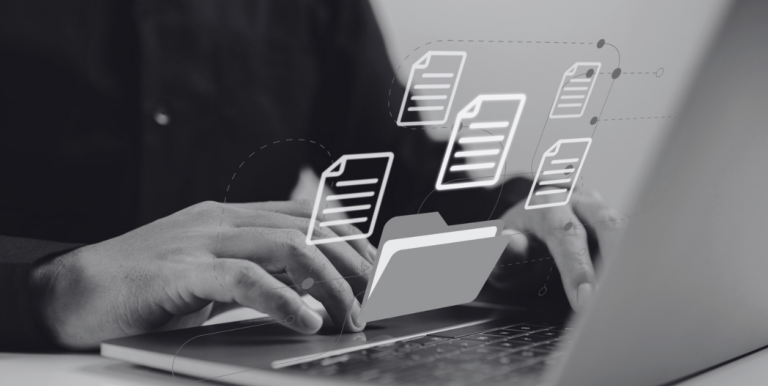
Nonprofit work means paperwork. While Candid is working to reduce that burden broadly, here is one specific way we are trying to help: by providing sample grant proposal documents .
There are four major documents that you may need to create if your nonprofit is looking for funding. Each has a different purpose and elements you’ll need to make your case to funders.
In this blog, we share the major types of grant proposal documents, their components, and free sample resources to show you what a successful version of each one looks like.
Letters of inquiry (LOI)
If you’re new to fundraising and grant writing, you may have not heard the term letter of inquiry , or LOI. Honestly, when you do, it’s good news.
A letter of inquiry or LOI is something a funder may ask for in lieu of a full grant proposal. Instead of a giant stack of papers, you just need to write a few pages to create a LOI that will get the funder excited to support your cause or project.
Sometimes, this can be the first step in a funder’s broader grant proposal process. In this case, you may be asked to complete a LOI to show whether you meet the grant criteria, so time is not wasted on a full proposal. Other times, it serves as the entire proposal.
Here’s what a letter of inquiry should include:
- An introduction that summarizes the letter.
- A brief description of your organization and why this particular project is important.
- A statement of need that convinces the reader your project meets the specific needs of those you serve.
- A methodology that explains how you’ll do it.
- Other funding sources that are being approached.
- Finally, a summary of what was just said and a brief thank you to the funder for considering your organization.
The biggest challenge is you only get a couple pages to make your case. In our LOI sample documents , you will see examples of how you can summarize projects in a compelling and concise way.
Cover letters
This is the most important part of your grant proposal: the cover letter . Think of a cover letter as a compelling introduction to the contents of your full proposal. It’s your first chance to connect your project with the funder’s philanthropic mission.
At minimum, your cover letter should include:
- An introduction to your project.
- The dollar amount of funding you need.
- How your project and organization will further the foundation’s mission.
- A list that outlines the proposal’s contents.
- Contact details in case the funder wants additional information.
- A signature from your organization’s executive director.
Additionally, if your organization has branded letterhead, consider using it for added polish.
In our sample documents, you’ll find three different examples of cover letters that include these aspects.
Proposal budgets
Proposal budgets may seem a bit dull, but many funders say it’s the first part of a grant proposal that they read. Your budget should show your credibility and impact with numbers.
A proposal budget should include:
- Grants and other funding contributions.
- Earned income from events, products, and fees.
- Direct costs, like staff time, consultants, supplies, equipment, and evaluation (such as conducting surveys or collecting feedback).
- Indirect costs—or the invisible costs, like rent, utilities, office supplies, marketing, and administrative staff.
Make sure your budget adds up (it’s a big red flag when it doesn’t). Not only should the math be correct, but it should also match the request for funding you’re making in the proposal.
To see this in practice, review our proposal budget sample documents.
Full grant proposals
Here’s the big one. Writing a full grant proposal can be a little intimidating.
Before you begin, make sure to read and re-read the instructions from the funder. You don’t want to miss some simple but important proposal requirements, like using a specific font.
Here are the key elements of a proposal:
- Executive summary. This is where you’ll give a snapshot of the problem, your solution for addressing it, why your organization can help, and the amount of funding you’ll need to do so.
- Needs statement. Next is a needs statement that shows why your project is needed and aligned with funders’ focus areas.
- Project description. In this section, you’ll share your project’s goals and objectives, detailed activities, and information about your organization.
- Proposal budget. Finally, a budget that shows in numbers how you’ll address the problem.
Reading examples of full grant proposal documents can be a helpful way to get started. You can also check out our free live and on-demand trainings .
Need more help? Our team of online librarians is here to provide resources and support. You can reach out to them by emailing [email protected] or via chat during business hours.
- Tips & Training
- International
- Candid’s tools
- Fundraising, giving, and donations
- Nonprofit and charity work
About the author

Melissa is an experienced information professional who leads Candid’s Online Librarian program and oversees content creation for Candid Learning’s Knowledge Base Articles. She is passionate about librarianship, providing equitable access to information, and teaching people how to navigate online resources.
In addition to her experience leading the Online Librarian program, Melissa has extensive nonprofit experience having worked in development for both small and large Cleveland-area nonprofits and as a grants manager for a private foundation. Melissa has a Master of Library and Information Science from Kent State University.
Leave a comment Cancel reply
Post comment
This site uses Akismet to reduce spam. Learn how your comment data is processed .
Adelene Hampton says:
Thank you. I want to improve education, mathematically in the state of Louisiana. Your cupport has been most helpful and appreciated.
Gary Van Dyke says:
need grant for medical expenses
Geoffrey says:
Insightful well arranged tips on proposal writing. Want to learn more and examples
Jesus Loera says:
Good evening friends, I am Jesus Loera. Lately I have become interested in grant writing but haven't a clue where to start. I am a life long resident of Brownsville Texas. We are stuffed up against the Mexican border. Not extremely prosperous, sad to say. I work for a Community College in need of funding, I am a member of a Unitarian Church with only 6 members and I recently joined the local Freemasons. All these organizations in desperate need of finical help. I am willing to help as much as possible, but in need of some coaching.
Kate, Digital Communications Manager, Candid says:
Candid does not suggest specific funders or approach them on your behalf. But we can point you to resources that should help you in your funding search. You can check out our Knowledge Base for information on getting grants and finding donors .
Christian Wilson says:
We need additional funding in the amount of $20,000 to feed 700 people during the weekend when there are no services provided. The local funders have been tapped out and tell us that they cannot assist us. Can you advise me of other alternative funding that might be available so that we can continue to feed these families?
Leslie England says:
Greetings! We are a 501c3 trying to get a grant to buy a building for a homeless shelter in our area. We have no idea how to find grants or apply for them. Where do you begin?
Jean niyungeko Fessi says:
the information is so helpful, thanks for being resourceful.
Bruce says:
I also maintain both a paper and electronic file of key documents usually required like IRS letter, BOD list, 1page overview of organization including Mission statement, most recent 990, annual budget including income and expenses. All this helps especially with online applications!
Lorent Damaseke Mvula says:
Thanks for the knowledge and skills I have learned on grant proposals, this really sharpens my knowledge.
RMM- ED says:
Thank you for posting this!
This is super helpful, thank you!
Cindy Dashnaw Jackson says:
This is an incredible resource and a generous action, Melissa. I hope many nonprofits see this article!
Related posts
7 red flags for funders in your grant proposal
Avoid these seven red flags for funders in your grant proposal to increase your chances of funding success.
By David M. Holmes (he/him) and Kate Meyers Emery, Ph.D. (she/her)
June 14, 2023

How to write a winning grant proposal
Writing a grant proposal doesn’t have to be a daunting task. Read this blog to get best practices on how to craft the key sections of your next project proposal.
By Stephen Robertson (he/him)
February 7, 2023

5 fundraising ideas to start the year off strong
Discover five fundraising ideas you can prioritize today to help you get a heads start on successfully achieving your annual funding goals.
By Krista Berry (she/her)
February 28, 2023

The basics of building a nonprofit budget
By Melissa Pulis (she/her)
June 9, 2022

4 practical tips for building relationships with nonprofit funders
Use these four tips to help you build relationships with nonprofit funders and increase the odds of gaining their support.
By Kyle Kivett (he/him)
April 4, 2023
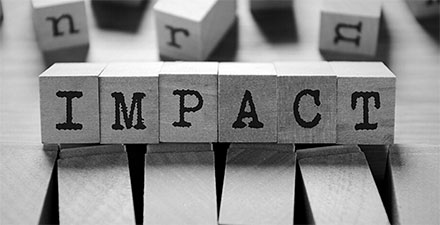
Impact measurement: How to measure your nonprofit’s impact
By Kaelee Nelson (she/her)
October 30, 2020
15 Sample Letters of Request for Grant Funds
Securing grant funding is a vital process for many organizations, particularly nonprofits, educational institutions, and research bodies. Crafting a compelling request for grant funds requires a clear, professional, and persuasive approach.
It is crucial to succinctly convey the purpose of the grant, the significance of the project, and how the funding will be utilized to achieve specific goals. This article provides fifteen diverse sample letters, each designed to request grant funding under different circumstances.
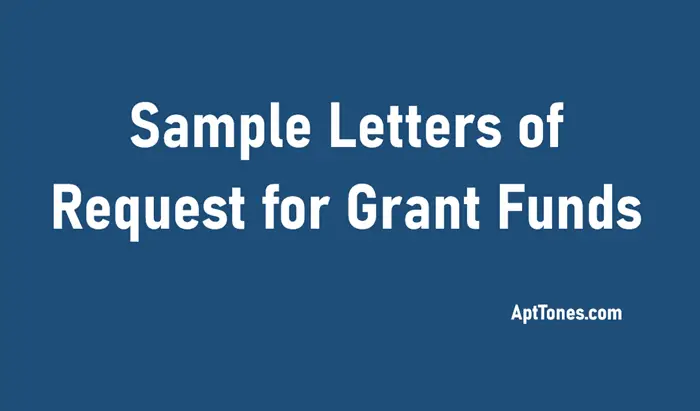
Sample Letters of Request for Grant Funds
These samples serve as templates to guide individuals and organizations in articulating their needs and the potential impact of their projects to grant providers.
Sample 1: For Community Development Project
Dear [Grant Provider’s Name/Organization],
I am writing to request funding for a community development project spearheaded by [Your Organization’s Name]. Our project, titled [Project Name], aims to [briefly describe the project’s goal, such as improving local infrastructure, providing community services, etc.].
Your grant of [Requested Amount] will enable us to [specifically outline how the funds will be used and the expected impact].
Thank you for considering our request.
Sincerely, [Your Name, Your Position]
Sample 2: For Educational Program
To [Grant Provider’s Name/Organization],
Our school is initiating an innovative educational program designed to [describe the program’s objectives, such as enhancing STEM education, supporting underprivileged students, etc.]. We are seeking grant funding to support this endeavor.
A grant of [Requested Amount] will assist us in [outline specific uses of the grant, such as purchasing equipment, hiring staff, etc.].
We appreciate your support in advancing educational opportunities.
Kind regards, [Your Name, Your Position]
Sample 3: For Environmental Conservation Project
We at [Your Organization’s Name] are dedicated to environmental conservation. Our upcoming project, [Project Name], focuses on [briefly describe the project, such as habitat restoration, pollution reduction, etc.]. To successfully implement this project, we are in need of grant funding.
Your contribution of [Requested Amount] will be pivotal in [describe how the funds will contribute to the project’s success].
Thank you for considering our request for this vital cause.
Sample 4: For Health and Wellness Initiative
Our organization is launching a health and wellness initiative aimed at [describe the initiative’s aim, such as improving community health, providing mental health support, etc.]. We are seeking grant funds to effectively roll out this program.
A grant of [Requested Amount] will enable us to [detail how the grant will be used, such as organizing health camps, creating awareness materials, etc.].
We appreciate your support in promoting health and wellness.
Sample 5: For Arts and Culture Project
We are planning an arts and culture project titled [Project Name], which aims to [describe the project’s goals, such as preserving local art, promoting cultural activities, etc.]. To bring this project to fruition, we are in need of funding.
A grant of [Requested Amount] will help us in [specifically mention the uses of the grant, such as hosting events, setting up exhibitions, etc.].
Your support in promoting arts and culture is greatly valued.
Sample 6: For Research Project
Our team is conducting research on [briefly describe the research topic, such as a scientific study, social research, etc.]. This research is critical for [explain the significance of the research]. We are seeking grant funds to support our study.
A grant of [Requested Amount] will be used for [detail specific needs such as equipment, fieldwork expenses, etc.].
We appreciate your consideration of our research endeavor.
Sample 7: For Technology Upgrade
We are seeking grant funding for a technology upgrade project at [Your Organization’s Name]. This project is aimed at [describe the purpose, such as improving efficiency, expanding digital access, etc.].
Your grant of [Requested Amount] will enable us to [outline specific plans, such as purchasing new software, hardware, etc.].
Thank you for supporting our technological advancement.
Sample 8: For Youth Empowerment Program
[Your Organization’s Name] is committed to empowering the youth in our community. We are requesting grant funding for our program, [Program Name], which focuses on [describe program objectives, such as skill development, mentoring, etc.].
A grant of [Requested Amount] will assist us in [detail how the grant will be utilized, such as organizing workshops, providing resources, etc.].
We are grateful for your consideration in empowering future generations.
Sample 9: For Community Health Initiative
We are launching a community health initiative aimed at [describe the initiative, such as tackling a specific health issue, improving health literacy, etc.]. To make this initiative successful, we need grant support.
A grant of [Requested Amount] will be crucial for [specifically mention the use of funds, such as medical supplies, training volunteers, etc.].
Thank you for considering our request to improve community health.
Sample 10: For Disaster Relief Efforts
In light of the recent [mention specific disaster], our organization is actively involved in relief efforts. We are in urgent need of grant funding to support these efforts effectively.
Your grant of [Requested Amount] will enable us to provide [specific assistance such as shelter, food, medical aid, etc.] to the affected individuals.
Your support in this critical time is immensely appreciated.
Sample 11: For Animal Welfare Project
Our animal welfare project, [Project Name], aims to [describe the project’s goals, such as rescue and rehabilitation, awareness campaigns, etc.]. We are seeking grant funds to carry out this project effectively.
A grant of [Requested Amount] will help us in [outline specific plans, such as setting up shelters, organizing adoption drives, etc.].
Thank you for considering our request to support animal welfare.
Sample 12: For Historical Preservation
We are dedicated to preserving our region’s historical landmarks. Our project [Project Name] requires funding to continue our preservation efforts.
Your grant of [Requested Amount] will assist in [detail the specific uses, such as restoration work, educational programs, etc.].
We appreciate your support in preserving our historical heritage.
Sample 13: For Agricultural Development
Our agricultural development project is designed to [describe objectives, such as improving sustainable farming, supporting local farmers, etc.]. We are in need of grant funding to bring these goals to fruition.
A grant of [Requested Amount] will be used for [specific needs like equipment purchase, training programs, etc.].
Thank you for considering our request to advance agricultural development.
Sample 14: For Substance Abuse Prevention Program
We are seeking grant funding for our substance abuse prevention program, which focuses on [briefly describe the program’s aim]. This program is crucial in [explain the program’s impact, such as reducing substance abuse, providing support, etc.].
A grant of [Requested Amount] will help us in [outline the use of funds, such as community outreach, treatment facilities, etc.].
Your support in this vital program is greatly appreciated.
Sample 15: For Women’s Empowerment Initiative
Our initiative for women’s empowerment aims to [describe the initiative’s objectives, such as supporting women in business, education for girls, etc.]. To achieve these goals, we are requesting grant funds.
A grant of [Requested Amount] will be instrumental in [detail the specific plans, such as workshops, mentoring programs, etc.].
We are grateful for your consideration in supporting women’s empowerment.
Related Posts

.png)
Who we serve

Sports & Fitness

For Business Types

After School

Small Business

Payment Options
Pricing overview, trial classes.

Business Management
Reporting and dashboards, integrations, class management, automated rosters, form fields.

Parent Experience
Marketplace, educator resources, 2023 trend report, ebooks & guides, industry reports, webinars & videos, product updates, help center, latest blog posts.

Starting a business
Cover letter for grant proposal: sample & tips for success.

Once you’ve decided to turn your passion into a children’s activity business and write a business plan , you should turn your attention to funding. How are you actually going to get this new venture off the ground? At Sawyer , we work with thousands of children’s activity and education businesses and we know that grants are a great way to subsidize the cost of starting a new business so you can get your first students in the door.
In order to successfully win a grant, you need a strong grant proposal. Talking about your business and what you will accomplish with the money awarded to you is part of writing a good grant proposal, but personalization is even more important. Even though it might take longer to write personalized proposals for each grant, it is definitely worth the time spent. And the cover letter for a grant proposal is the number one place to show this personalization.
Cover letter for grant proposal: Sample & tips
Use these tips and our template to help you write a great cover letter for a grant proposal.
How to research grant opportunities
Writing a grant proposal cover letter, cover letter for grant proposal sample.
When it comes to writing a grant proposal and winning the grant, personalization is key. Whether you are looking for government or private grants, there are a lot of incredible opportunities for you to find the right ones for your new children’s activity or education business. Here are our suggestions on how to research grant opportunities so you can personalize your cover letter and proposal.
Cover all of your bases
Grants are, for all intents and purposes, free money, so it is in your best interest to do as much research as possible so that you can apply to any and all grants to which you are eligible. This means looking at government, both federal and state-level, as well as private grants. Private grants are offered by corporations and foundations and can have additional requirements. For example, some private grants are exclusively for women or minority communities.
You can find private grants here:
- National Association for the Self Employed (NASE)
- Grants for indigenous people
- Grants for women
To find government grants, check out:
- Challenge.gov
- Small Business Development Centers (SBDCs)
- Economic Development Administration (EDA)
Read about the organization or agency
Before you start writing the cover letter of your grant proposal, do your research! Read about the mission, values, and goals of the organization or agency that is awarding the grant. Take notes so that you can tailor your cover letter and additional elements of your grant proposal to that specific agency or organization. This will help you stand out and let the reader know that you spent the time to personalize your proposal to fit this specific grant.
Research past winners
Most grants will include a page with past winners. Take a look at these people and their companies so you can see what the organization or agency is looking for in a grant recipient. We also recommend that you reach out to these past winners to see if you can set up an informational phone call or coffee chat to learn more about their success. If you do this, be polite and aware of their time. Come prepared with questions and be sure to say thank you afterwards.

Once you have done your research, you are ready to begin writing your grant proposal cover letter. Take a look at the website for the grant to which you are applying to make sure they do not have any styling or formatting requirements. In addition, some government grants do not require a cover letter at all. Therefore, you should always double check before writing one.
The goals of your grant proposal cover letter are:
- Introduce your business to the reviewer
- State what you need (the amount of funding)
- Explain why you need the funding
What makes a successful grant proposal cover letter?
- It is succinct and to the point: Do not go over 1 page.
- It is unique: Don’t repeat what they will read in your proposal.
- It is personalized: Show them how much research you have done and why your children’s activity or education business fits with their mission.
Important tips for your grant proposal cover letter
- Use your company letterhead so it looks professional. You can use free design sites like Canva to easily create letterheads.
- Make sure you use the same date throughout your application. Even though experts suggest that you write your cover letter last, use the same date, which is the date of submission, across the whole proposal.
- Double check the organization’s contact information with a call or email so you know it is correct when adding it to the cover letter.
- Address the cover letter with “Dear” and then the title and last name of the reader. Make sure that you have the right name when you confirm the contact information.
- End the cover letter by signing “Sincerely” and your name and the name of any other high level board members, if you have them for your company. Leave room to sign it by hand and type your name below that.
- Include the word “ENCLOSURE” in all caps at the bottom of the letter.

Cover letter for grant proposal outline
- In your first paragraph, introduce your proposal, company, and request. Make sure you use the legal name of your company. Explain what you will accomplish with your company and, if there is data to back it up, include one point of research. For example, if you are starting an art education business, include a piece of information on the benefits of art classes for children.
- The next 2 paragraphs should be short, but pack a punch. Talk about the purpose of your business and how it fits with the mission of the organization or agency. If you are applying for a specific grant based on eligibility, like one for women, make sure to speak to this in the letter.
- Your conclusion paragraph should summarize what was said above and can mention how the grant and support of the organization would be beneficial for your company. You can even invite the reader to visit your classes online or in-person once they are up and running.
October 21, 2021
Grant Administrator
Organization Name
1234 Main St.
Anytown, USA 12345
Dear Mr. Jay,
Please find enclosed the grant proposal for Little Hands Art Community, a new art program helping children find their passion for creation. We are respectfully requesting a grant of $50,000 to start this children’s education program with online and in-person activities for children of all ages. Art has incredible abilities to help children regulate their emotions and stabilize their feelings, according to research done by the National Endowment for the Arts .
By working with qualified art teachers as well as licensed developmental specialists, Little Hands Art Community has a goal of teaching children to find beauty in everything. We will have classes available for children of all ages and ability levels. In addition, part of the funding requested will go towards scholarships and free classes that will help children from low-income families attend classes.
We have been working with children in our neighborhood of Santa Fe on our own for 6 months now and seen a vast improvement not only in fine motor skills, but also in emotional intelligence. Parents and teachers have reported that the classes have helped students better understand themselves and each other. We know that setting the next generation up for success is one of the missions of Organization Name and we hope you can see how Little Hands Art Community fits into that goal.
Thank you for taking the time to read our included proposal and consider us for this grant. We look forward to speaking with you more about how Little Hands Art Community can partner with Organization Name to help more children lead happy and healthy lives. If you have any immediate questions or need further information, feel free to reach out to me at 555-555-5555.
Sincerely,
Elizabeth Jones (signature)
Elizabeth Jones
Founder, CEO of Little Hands Art Community
123 Smith St,
Santa Fe, New Mexico 12345
555-555-5555

With these tips & cover letter grant proposal sample, you should be well on your way towards writing a strong cover letter for grant proposals. For even more information on how to get a small business grant , check out our guide. If you are looking for more guidance on how to start a business teaching children , the resources and tools offered by Sawyer for Business can help.
Frequently Asked Questions
Manage everything in one place..

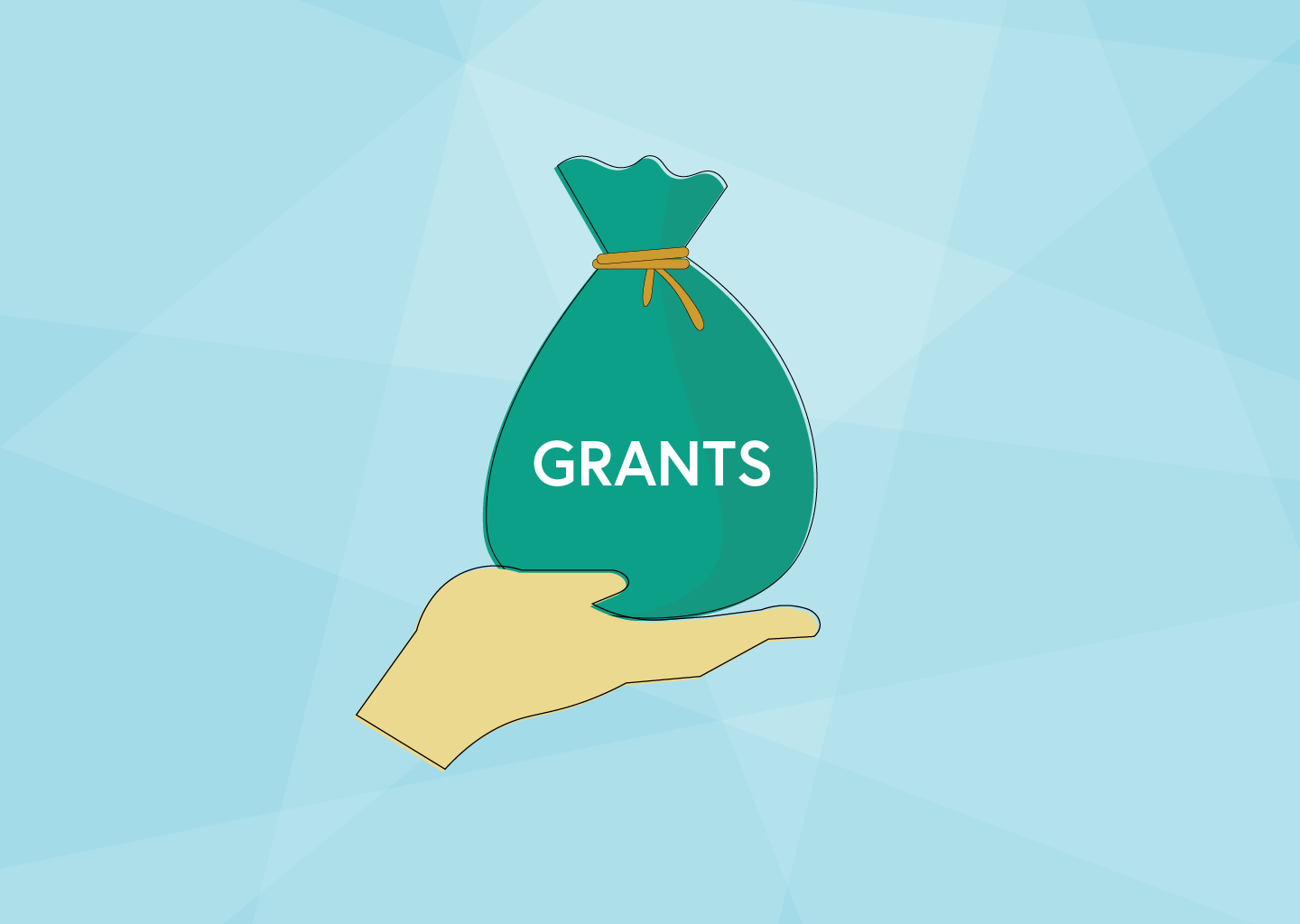
How to Start Grant Writing (+ Templates)
As a nonprofit, it’s a good idea to have a variety of revenue sources to fund your missions. One source can be grants. And if you’re looking for support for a specific project or position within your organization, you may have grant writing on the brain.
If you’re new to this process, you could have a lot of questions: How do I start grant writing? Is grant writing difficult? What does grant writing consist of?
Well, you’ve come to the right place! Below, we’ll cover everything you need to know about grant writing:
- Key essentials about grant writing
- Tips, tricks, and strategies
- A grant application template to get you started
In no time, you’ll be well on your way to writing your first grant!
Looking for templates you can use for your grant application? Download our FREE Grant Application Template bundle, which includes:
- A cover letter template
- A grant proposal template
Fill in the form below to get your copy!
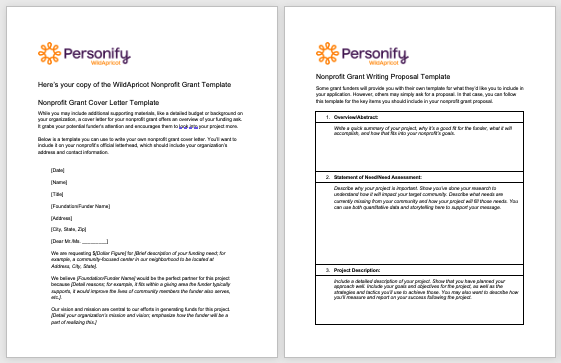
Download Your FREE Grant Application Template

What Is Grant Writing?
Grant writing is the process of writing a grant. But, you might wonder, what is a grant? A grant is a funding opportunity that foundations, businesses, and individuals make available to nonprofits to support their missions. It’s like a cash award for a great idea!
Grant writing is about building the case for a potential funder to support your work. Writing a grant involves putting together a proposal that tells the grantmaker the details of your project idea, how much money you need to fund it, and the impact it will make in the community.
You might also need to write a cover letter, but not all grant applications require one. We’ll dive into that more later in this article, so stay tuned!
Different Types of Nonprofit Grant Writing
You may find yourself writing for different types of grants. Some support specific project types, causes, or neighborhoods. Others may take a broader funding focus and accept proposals for any activity supporting the “public good.”
As you’re researching grants to apply for, you’ll want to be familiar with the three main types of nonprofit grants:
- Operating support or unrestricted funding : This kind of grant supports the day-to-day operations of your work. Unrestricted funding is the bread and butter of any nonprofit! If you snag this type of grant, it means the grantmaker trusts you to use the funding for whatever best supports your nonprofit rather than for specific line items or projects. These grant funds can be hard to find, since funders tend to like measuring impact through specific projects. But if you stumble across one, receiving it can make a huge difference to your nonprofit’s work!
- Capital support : Think of capital support as brick and mortar funding! These grants help your nonprofit purchase, renovate, or build needed facilities. They’re often for larger amounts. Because of that, they can require some extra details. Mainly, you’ll need to show the grantmaker that they can trust you to use it well!
- Program development grants or restricted funding : Have a specific project or staffing position to fund ? These grants are restricted to specific purposes, so are a great option for those needs. For example, you might write a grant to fund a new after-school art program. Based on the grantmaker’s restrictions, the grant might cover the costs of purchasing paint, paper, and other art supplies to use in the program, but not the rent for the space where you’re hosting it.
Why Is Applying for Grants Important? Is it Right for Me?
There are several reasons why grant writing is important. Grant writing can:
- Diversify your sources of revenue : Having a variety of revenue sources helps prevent financial emergencies . If one stream dries up, other sources are there to support you. Grants can give your nonprofit something to fall back on should, say, your individual donor contributions decrease during an economic downturn.
- Serve as a source of non-dues revenue : If you’re a membership organization, grant writing lets you secure funding outside of dues . You can use this funding to create better programming to recruit more members to your organization. Win, win!
- Help carry out what may seem like big dreams, programs, or initiatives : Sometimes a sizable grant set aside for a specific purpose is the resource you need to finally see a big project through. This is especially true if you’re already running a tight ship with your day-to-day expenses and don’t have the wiggle room to expand. Continuing with the art program example, a grant could help you buy a new kiln to start a ceramics program or fund an artist-in-residence program.
- Offer funding without a required payback period : Particularly for capital projects, grants can provide a solution to what you might otherwise have to finance through a loan. It definitely takes strain off your budget to avoid monthly loan payments!
- Increase the visibility of your organization : A lot of times, grantmakers will share press releases on which nonprofits they fund. They may also share your work on their social media and other marketing channels. This added bonus to the funding helps you reach a wider audience.
- Increase the credibility of your organization : Have you ever trusted a business or organization more because a peer recommended it? So many of us do—including grantmakers!. As you find success with your grant writing, you build your nonprofit’s credibility and it may become easier to secure additional funding in the future.
How do I know if applying for a grant is right for me?
While any nonprofit, big or small, can apply for a grant, it’s important to keep in mind that grants are best for long-term projects and goals. If you’re looking for immediate financial aid, a grant won’t be able to support you the way you need. This is because the application cycle can be long, and you don’t want to be waiting if you’re in a pinch!
Where can I look for nonprofit grants?
There are many places you can look for nonprofit grant writing opportunities. Here are a few to get you started:
- Google Alerts : Set up a Google Alert to receive a notification whenever new opportunities come up for your selected keywords. For example, if you’re funding an after school art program, you might set up alerts for “art program funding opportunity,” “after school art grants,” or “art grants for children.”
- Government-Based Grant Foundations : Your state, province, or country will usually have a database for grant writing opportunities. If you’re based in the United States, Grants.gov is a great place to start.
- Search Engines : You can find a lot of opportunities with some simple search engine research. Use keywords like the same ones you’ve used to set up Google Alerts.
- Your Existing Network : You may have current donors or members who serve on foundation boards or run their own philanthropic opportunities. Reach out to your supporters and ask them about grants they know of that could fit your nonprofit.
- Board Members : Board members are another great resource. See if the companies they work for offer grant writing opportunities. They may also have connections at other foundations or to friends in their network who offer grants to nonprofits like yours!
- Other Nonprofits : Need some ideas on who might fund you? Take a look at nonprofits similar to yours to see where they’re getting their funding.
- GrantWatch : GrantWatch is an online database that keeps current information on available grant writing opportunities within 60 different categories. It makes it easy to search for grants that could be good for your nonprofit.
- GuideStar : This online database provides information on nonprofits everywhere. It’s a great way to identify similar nonprofits to yours and see where they’re receiving their grants. You can also use it to identify foundations that provide grants and learn more about them and who they have funded in the past.
- Philanthropy News Digest : This free online service posts requests for proposals and grant notices for US-based nonprofit and grantmaking organizations. You can sign up for its newsletter and alerts and easily view the most recent opportunities by category and application deadline.
- Candid’s Regional Giving Dashboards : This online service offers overviews of regional funding opportunities across the United States. Not based in the US? Keep an eye on it, as it may expand to include global opportunities in the future as well.
Essential Elements of a Grant
Usually, the two core elements of a grant are the grant proposal and the grant cover letter . Below, we’ve covered the essential parts of each of these components.
Nonprofit Grant Writing Cover Letter
Depending on your grant application, the cover letter may not be necessary. However, if your grant writing involves a cover letter, it should typically be one page in length and written on your nonprofit’s official letterhead.
Your cover letter is an overview of your funding ask. It grabs your potential funder’s attention and makes them want to look into your project. Think of it like a friendly elevator pitch that lands you an interview to learn more!
Here’s what you’ll typically want to include in your cover letter:
- Brief project description
- Expected impact of the grant
- Requested grant support amount
- Outline of what is included in your attached proposal
- Mention of past grants you’ve received
- Your contact information
- Signature of your Executive Director or Development Director
Nonprofit Grant Writing Proposal
If your cover letter is what gets your foot in the door for an interview, we can think of the grant proposal as what gets you the job!
Your grant proposal builds the case for why the grantmaker should fund your project. It provides essential, persuasive details that give heft to anything already mentioned in your cover letter. Some grant funders will provide you with their own template for your application. Others may simply ask for a proposal. Be ready for both!
What is included may vary slightly by funder, but typically a proposal involves:
- Overview/Abstract
- Statement of Need/Need Assessment
- Project Description
- Budget & Budget Allocation
- Organizational Background
- Supporting Documents
Don’t forget to grab your FREE copy of The Nonprofit Grant Writing Cover Letter and Proposal Templates here.
Tips and Strategies for Grant Writing
Whether you decide to use a template or decide to free-style it, there are some key tips and strategies you want to keep in mind. Grant writing can feel intimidating, so it’s important you go in with the right information. This way, you’ll have the confidence that you’ll be writing a strong application.
In this section, we’ll cover key pointers for each stage of grant writing, including:
- How to prepare for grant writing
- Grant writing strategy and planning
- Writing your grant
How to Prepare for Grant Writing
Before you even start mapping out your grant application, there are a few steps to take to prepare. You’ll want to:
- Understand the audience, purpose, and expectations of your grant proposal : Read as much as you can to learn who will be reading your grant application and what they’re looking for. Know the purpose of the grant funding and the expectations the grantmaker will have if you receive the award. This can even help you find the right person to address your cover letter to, making it a lot more personal than using “Dear Foundation” as your salutation!
- Tailor your proposal for a specific objective : Even if you’re applying for unrestricted funds, aim to be detailed in your funding ask. Framing your grant writing around a specific objective builds the case for why you should get the funding and the type of impact it’ll have for your nonprofit.
- Understand the application’s guidelines and rules and follow them to a tee : Grantmakers typically have many high-quality applications to review. It can be hard for them to narrow it down to a winner! Avoid simple mistakes that could move you from the “yes” pile to the “no” pile, like getting the time zone wrong for the deadline or forgetting to include supplemental materials. You want your hard work to have the best chance possible! Have questions about the grant application’s rules? Reach out to the grant officer for clarification. Asking questions isn’t a weakness! It shows the grantmaker you pay attention and care enough to submit the best application possible.
- Be realistic : As you review a grant’s guidelines, rules, and purpose, ask yourself whether your project is truly the right fit for that grant. There’s no need to waste your time writing the grant or the grantmaker’s time reviewing the application if your project doesn’t align with the grant’s goals.
Grant Writing Strategy and Planning
Before writing your grant, know what you need to cover within it. Having these answers before you start writing will make sure you cover the core ideas needed in your grant application. And ultimately, this makes sure you give the funder all the information they need to be convinced to award you the funding!
As well, during this stage, you’ll want to strategize and plan accordingly to make sure you’ve given yourself enough time. Set out time to draft and refine your grant application before your submission is due.
As you get started, make sure you know your answers to the following:
- What is YOUR grant application timeline? This is one of the first and most important questions to ask yourself. Know when grant application periods open and close. Consider whether you have one or multiple grants to write during that period. Then, create a timeline for yourself so you have ample time to prepare your application with minimal stress and to not miss a deadline!
- Why are you asking for the grant? From the beginning to the end of your grant writing process, focus on this question and build it into your entire narrative. Basically, you want to clearly know your need and how to convey it.
- What will the impact and benefits be? On top of communicating what your needs are, you should be able to clearly state how this grant will address them. Help your funder envision the future they will help you create!
- What will be your plan of action once you get the grant? Be prepared to start your project as soon as you receive the grant. Having a timeline for when different events and activities will occur demonstrates that you have an actionable plan to use the grant in a timely and effective manner.
- What is your financial budget and plan for the funding received? You should be prepared with a detailed budget for your project. Rather than asking for a lump sum of money, be able to explain the different pieces that go into creating that total. Using the after-school art program example, you’ll want to share how much funding will go toward paint, brushes, paper, staff time, marketing , and rent.
Writing Your Grant
As you actually start writing your grant, there are some tips that can help strengthen your application. To write a successful grant application:
- Be specific : Show that you’ve put thought and care into your funding proposal by being specific. For example, rather than saying you want to fund art opportunities for children, share how you will create those opportunities. You will begin an after school art program for children ages 5 to 10 in New York City that will employ three local artists who specialize in painting, collaging, and ceramics.
- Be concise : While you want to be specific, you also want to be concise. Don’t make the funder search for the most relevant information in your grant application. Make every sentence count.
- Avoid redundancy and repetition : One way to tighten up your application is to review it for repetition. Have you already explained something clearly in an earlier part of your application? No need to say the same thing again! If you’re building on it in a way that’s crucial to your application, keep it short and simple by adding a phrase like “as stated earlier”.
- Make a clear ask : Don’t be shy about making your ask! Clearly state your need. For example: We are asking for a $5,000 donation to support an after-school art program. You can also use bullet points to draw attention to your ask and make it easy to understand.
- Lead with your core idea : Start with your clear objective for the grant proposal and then make sure everything else you write links back to that core idea. Think of it as you would the thesis for an essay.
- Demonstrate your past successes : When relevant, feel free to brag on your organization’s past successes with grants a bit! Mention others you’ve received and how you’ve put them to use. This shows the grantmaker that in the past, others have seen promise in your projects or mission. It also shows you’ve been able to use that money to make a positive difference. Funders may be more likely to give to an organization that already has experience managing grant funds.
Start Grant Writing With Smart Preparation and Strategy
We hope you found this guide to grant writing helpful! Yes, getting started with grant writing can feel like a lot, but with some simple preparation and strategy, you can take the process step by step for a successful submission and award!
Want to keep up to date with other nonprofit tips? Make sure to check out other articles on our blog !
And if you’re looking for additional ways to diversify your nonprofit funding and sources of income, check out our resource How to Write the Perfect Donation Letter (+ Examples & Template) .
Related Organizational Management Articles

30 Free Nonprofit Webinars for June 2024
Nonprofit Succession Planning: A Step-by-Step Guide

Strategic Planning for Nonprofits

The Membership Growth Report:
Benchmarks & insights for growing revenue and constituents.
- Sample Letters
Sample Grant Proposal Letter Templates
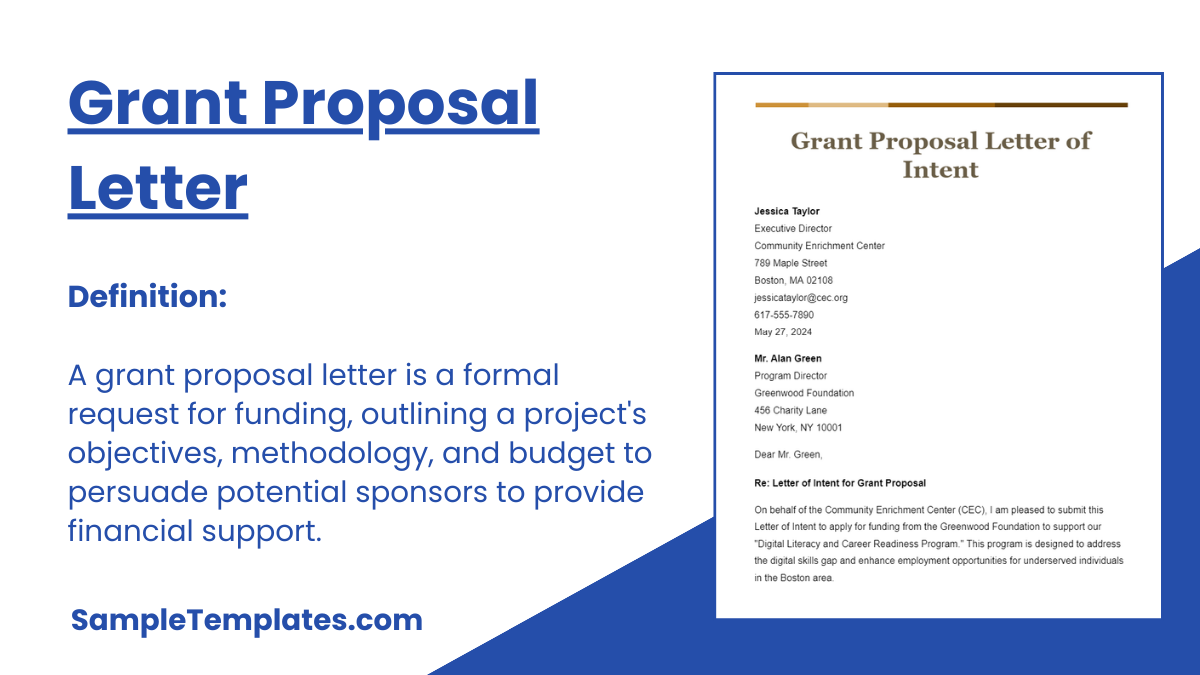
Most of the time, NPOs have to seek out funds from other organizations or businesses. Commonly, grant proposals are done so as to get support. The Sample Letters found below are what most NPOs send to those whom they want to get financial help and support from in order to turn their cause into action.
Grant Proposal Letter
Love letters for girlfriend, sample internship acceptance letter templates, sample inform letter templates.
Spearheading a nonprofit organization can be an immensely fulfilling and life-changing endeavor. You are able to make a difference in your community by taking action and by disseminating your cause, as well as information that may be helpful to other people. Although it is an exciting venture, being in a nonprofit organization also has its struggles.
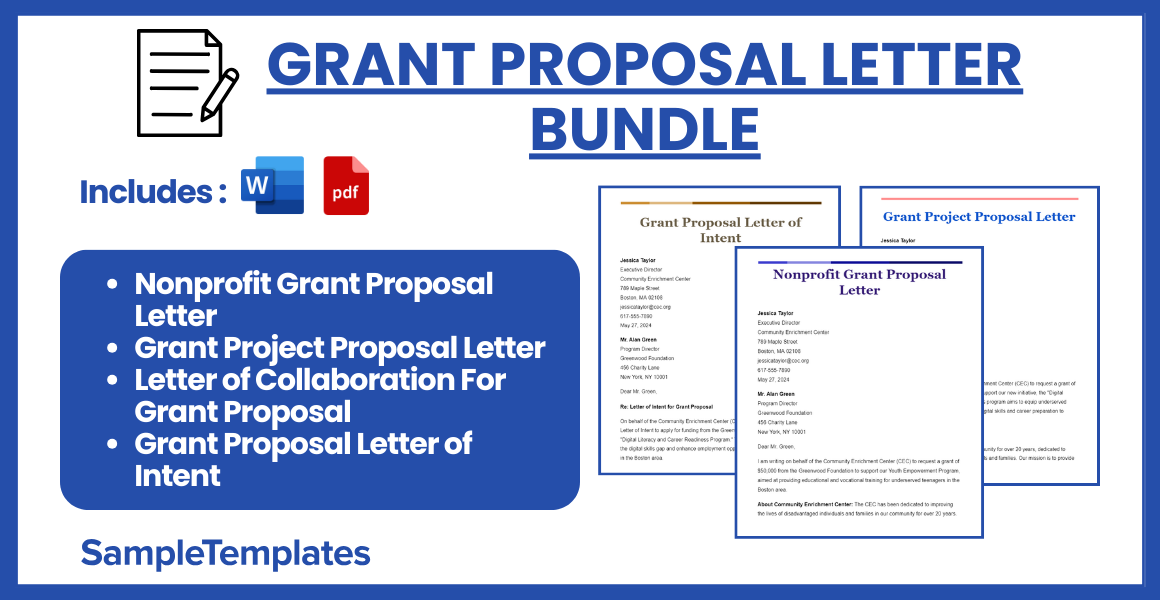
Download Grant Proposal Letter Bundle
Nonprofit Grant Proposal Letter
Jessica Taylor Executive Director Community Enrichment Center 789 Maple Street Boston, MA 02108 [email protected] 617-555-7890 May 27, 2024
Mr. Alan Green Program Director Greenwood Foundation 456 Charity Lane New York, NY 10001
Dear Mr. Green,
I am writing on behalf of the Community Enrichment Center (CEC) to request a grant of $50,000 from the Greenwood Foundation to support our Youth Empowerment Program, aimed at providing educational and vocational training for underserved teenagers in the Boston area.
About Community Enrichment Center: The CEC has been dedicated to improving the lives of disadvantaged individuals and families in our community for over 20 years. Our mission is to provide resources, education, and support to help community members achieve self-sufficiency and improve their quality of life.
Project Overview: The Youth Empowerment Program seeks to address the educational and employment challenges faced by at-risk youth. The program will offer:
- Tutoring Services: Providing academic support in core subjects to improve school performance and graduation rates.
- Vocational Training: Offering hands-on training in various trades and professions to equip teens with marketable skills.
- Mentorship: Pairing participants with mentors who can provide guidance, support, and career advice.
Goals and Impact:
- Increase Graduation Rates: Aim to improve the high school graduation rates of participants by 20%.
- Job Placement: Help at least 50% of program graduates secure employment or internships within six months of completion.
- Skill Development: Provide vocational skills training to 100 participants annually.
Budget: The total budget for the Youth Empowerment Program is $100,000. We have secured $50,000 from local businesses and individual donors. A grant of $50,000 from the Greenwood Foundation will enable us to fully implement the program and achieve our objectives.
Conclusion: We believe that the Youth Empowerment Program will make a significant difference in the lives of at-risk youth in Boston. By equipping them with the necessary skills and support, we can help them build a brighter future. We sincerely hope that the Greenwood Foundation will join us in this important endeavor.
Thank you for considering our request. We look forward to the possibility of partnering with the Greenwood Foundation to empower the youth of our community. Please do not hesitate to contact me at [email protected] or 617-555-7890 if you need any additional information.
Jessica Taylor Executive Director Community Enrichment Center
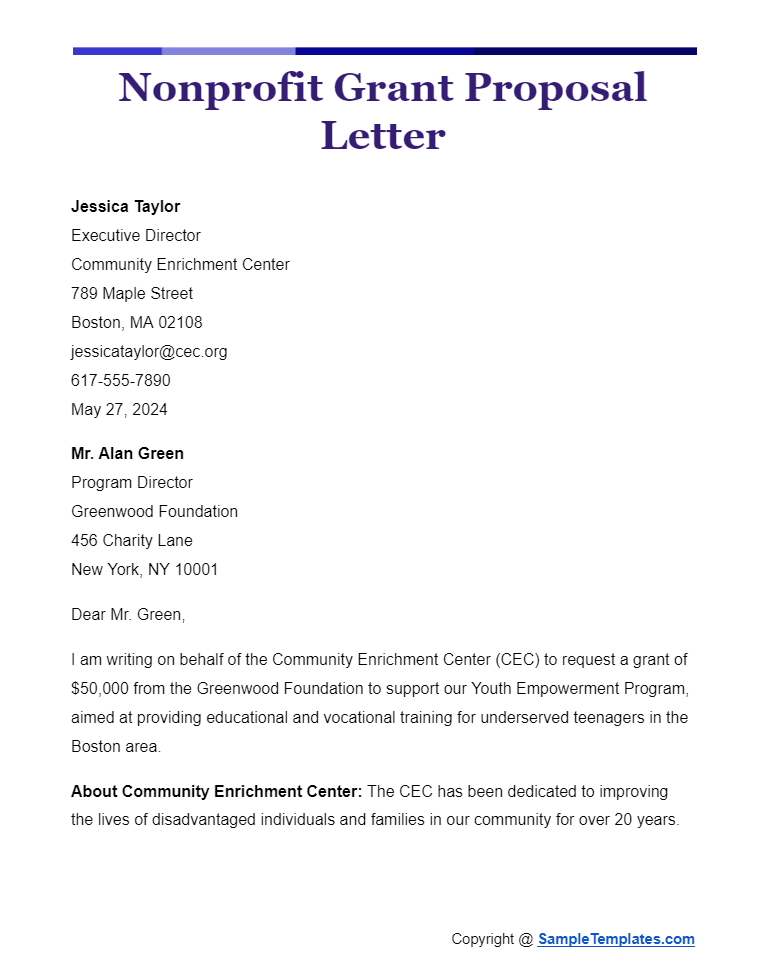
Download In
PDF Word Google Docs
Grant Project Proposal Letter
I am writing on behalf of the Community Enrichment Center (CEC) to request a grant of $50,000 from the Greenwood Foundation to support our new initiative, the “Digital Literacy and Career Readiness Program.” This program aims to equip underserved individuals in the Boston area with essential digital skills and career preparation to enhance their employment opportunities.
About Community Enrichment Center:
The CEC has been a cornerstone in the community for over 20 years, dedicated to improving the lives of disadvantaged individuals and families. Our mission is to provide resources, education, and support to help community members achieve self-sufficiency and improve their quality of life.
Project Overview:
The “Digital Literacy and Career Readiness Program” addresses the digital divide and employment barriers faced by low-income and unemployed residents. The program includes:
- Digital Skills Training: Courses covering basic computer skills, internet navigation, and software applications like Microsoft Office and Google Suite.
- Career Workshops: Workshops focusing on resume writing, job searching, interview techniques, and professional communication.
- Job Placement Support: Partnerships with local businesses to provide internships, job shadowing, and employment opportunities for participants.
- Digital Proficiency: Ensure 80% of participants achieve basic digital literacy certification.
- Employment Readiness: Prepare 100 participants annually with the skills and knowledge to enter the workforce confidently.
- Job Placement: Aim to place at least 60% of participants in jobs or internships within six months of program completion.
The total budget for the “Digital Literacy and Career Readiness Program” is $100,000. We have secured $50,000 through local business contributions and individual donors. The requested $50,000 from the Greenwood Foundation will cover the remaining costs, including:
- Instructor Salaries: $20,000
- Equipment and Software: $15,000
- Program Materials and Supplies: $10,000
- Administrative Costs: $5,000
Conclusion:
We believe that the “Digital Literacy and Career Readiness Program” will significantly impact the lives of our participants, providing them with the skills necessary to thrive in today’s digital economy. With the Greenwood Foundation’s support, we can bridge the digital divide and open doors to new career opportunities for our community members.
Thank you for considering our request. We look forward to the possibility of partnering with the Greenwood Foundation to empower individuals through digital literacy and career readiness. Please feel free to contact me at [email protected] or 617-555-7890 if you need any additional information.

Letter of Collaboration For Grant Proposal
I am writing to express the Community Enrichment Center’s enthusiastic support for the “Digital Literacy and Career Readiness Program” grant proposal submitted by the Boston Public Library. We are excited about the opportunity to collaborate on this important initiative, which aligns with our mission to provide resources, education, and support to underserved individuals in the Boston area.
About the Collaboration:
The Community Enrichment Center (CEC) and the Boston Public Library (BPL) share a commitment to enhancing the quality of life for community members through education and skills development. By partnering on the “Digital Literacy and Career Readiness Program,” we aim to combine our strengths and resources to deliver a comprehensive and impactful program.
Role and Contributions:
As a collaborative partner, the Community Enrichment Center will contribute to the program in the following ways:
- Outreach and Recruitment: CEC will leverage its extensive network to recruit participants from underserved communities who will benefit from the program.
- Facilities and Resources: CEC will provide classroom space, computers, and other necessary resources at our center for training sessions and workshops.
- Support Services: CEC will offer additional support services to participants, including career counseling, mentorship, and access to our job placement assistance program.
- Instructor Expertise: CEC’s experienced staff will collaborate with BPL instructors to deliver high-quality digital literacy and career readiness training.
Expected Outcomes:
Through this collaboration, we expect to achieve the following outcomes:
- Increased Digital Literacy: Equip 200 participants with essential digital skills annually.
- Enhanced Employment Opportunities: Improve job readiness for participants, aiming for a 70% job placement or internship rate within six months of program completion.
- Community Impact: Strengthen the overall economic stability of our community by empowering individuals with the skills needed to succeed in the digital economy.
The Community Enrichment Center is committed to the success of the “Digital Literacy and Career Readiness Program” and believes that our collaboration with the Boston Public Library will greatly enhance the program’s effectiveness and reach. We are confident that, with the support of the Greenwood Foundation, this initiative will make a significant difference in the lives of many individuals in our community.
Thank you for considering our joint proposal. We look forward to the opportunity to work together on this transformative project. If you have any questions or need further information, please do not hesitate to contact me at [email protected] or 617-555-7890.
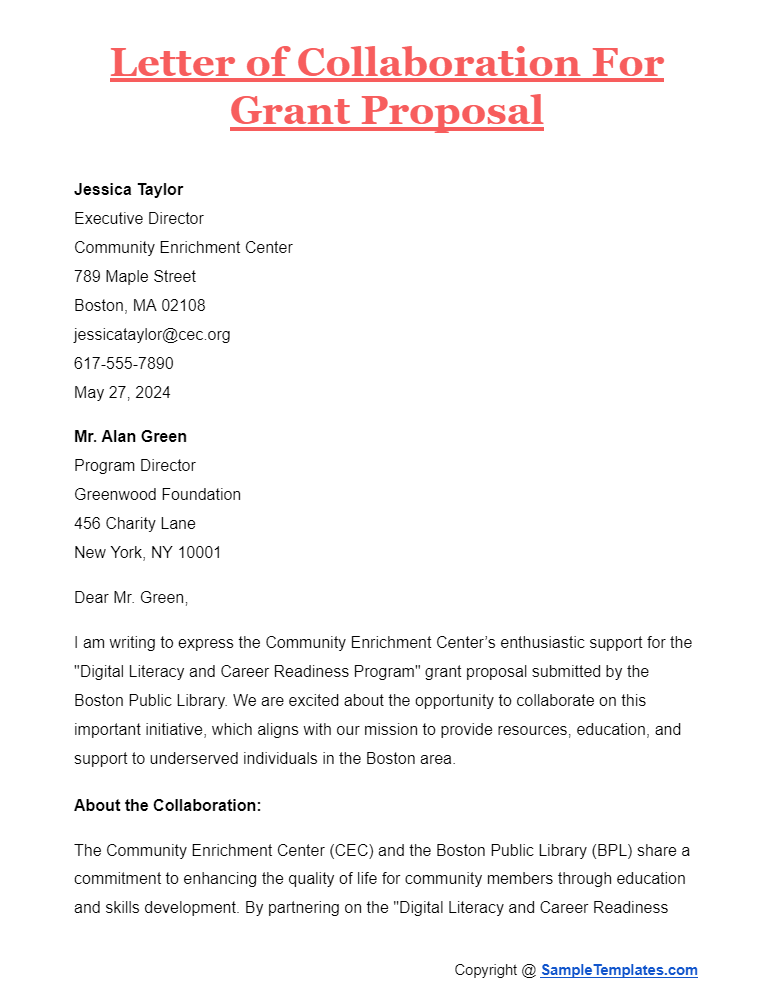
Grant Proposal Letter of Intent
Re: letter of intent for grant proposal.
On behalf of the Community Enrichment Center (CEC), I am pleased to submit this Letter of Intent to apply for funding from the Greenwood Foundation to support our “Digital Literacy and Career Readiness Program.” This program is designed to address the digital skills gap and enhance employment opportunities for underserved individuals in the Boston area.
The CEC has been dedicated to improving the lives of disadvantaged individuals and families in our community for over 20 years. Our mission is to provide resources, education, and support to help community members achieve self-sufficiency and improve their quality of life. We have a proven track record of delivering impactful educational and vocational programs.
The “Digital Literacy and Career Readiness Program” aims to equip participants with essential digital skills and prepare them for successful careers. The program will include:
- Digital Skills Training: Courses on basic computer usage, internet navigation, and essential software applications like Microsoft Office and Google Suite.
- Career Workshops: Sessions on resume writing, job searching, interview techniques, and professional communication.
- Job Placement Support: Partnerships with local businesses to provide internships, job shadowing, and employment opportunities.
Goals and Objectives:
Budget overview:.
The total budget for the “Digital Literacy and Career Readiness Program” is $100,000. We are seeking $50,000 from the Greenwood Foundation to cover the remaining costs after securing $50,000 from local businesses and individual donors. The grant will be allocated as follows:
We believe that the “Digital Literacy and Career Readiness Program” will significantly impact the lives of our participants, providing them with the skills necessary to thrive in today’s digital economy. We are excited about the opportunity to partner with the Greenwood Foundation to bridge the digital divide and open doors to new career opportunities for our community members.
Thank you for considering our Letter of Intent. We look forward to the possibility of submitting a full proposal and collaborating with the Greenwood Foundation on this transformative project. If you have any questions or need further information, please do not hesitate to contact me at [email protected] or 617-555-7890.
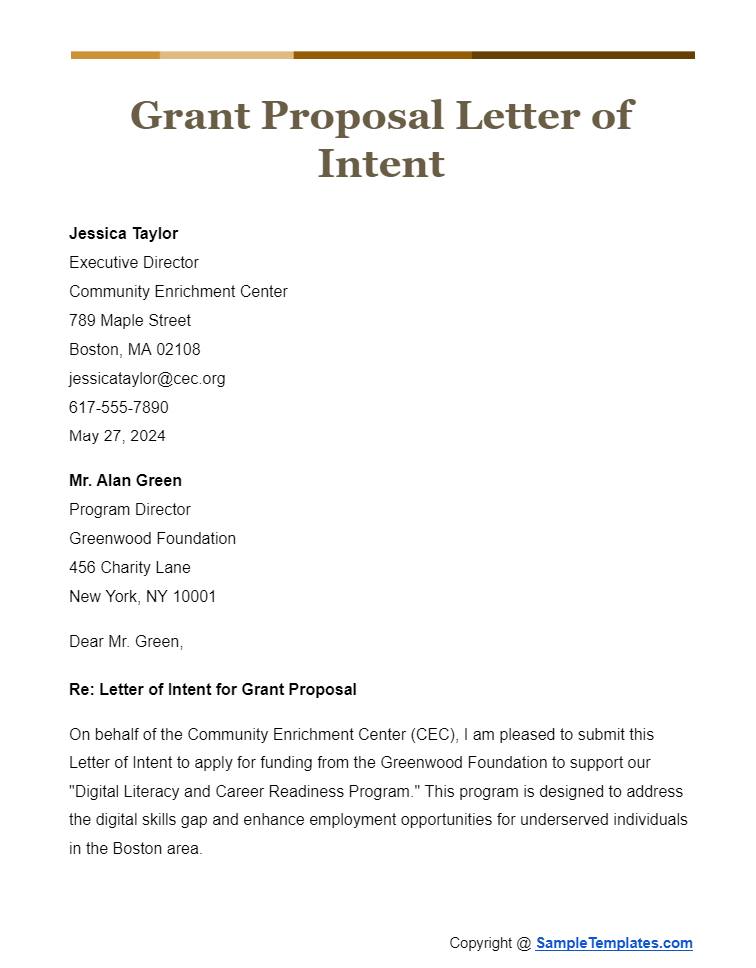
Browse More Templates On Grant Proposal Letter
Sample grant request letter.
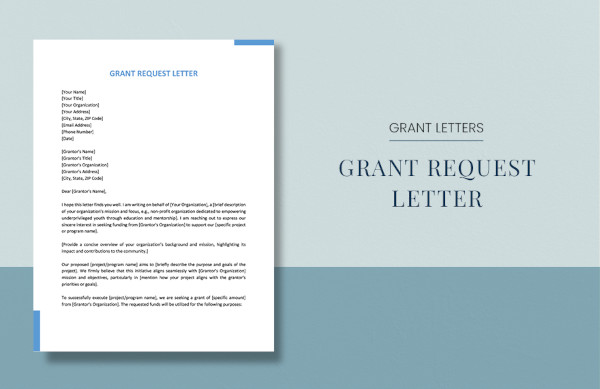
- Google Docs
- Apple Pages
Grant Letter Example
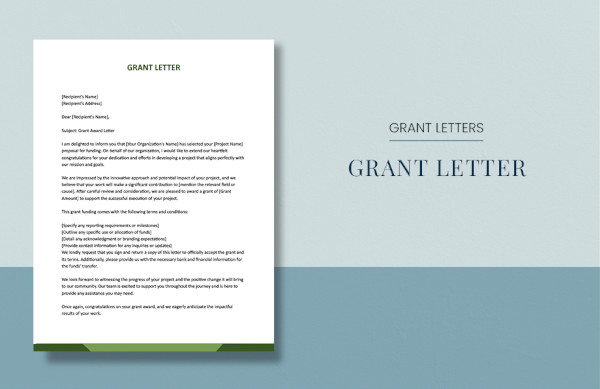
Application Letter for Funding Support
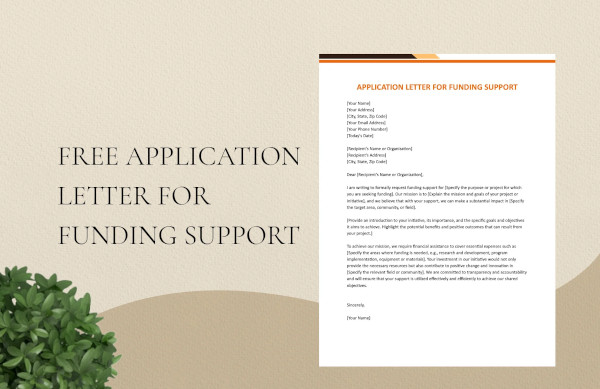
Tips For Writing a Grant Proposal Letter
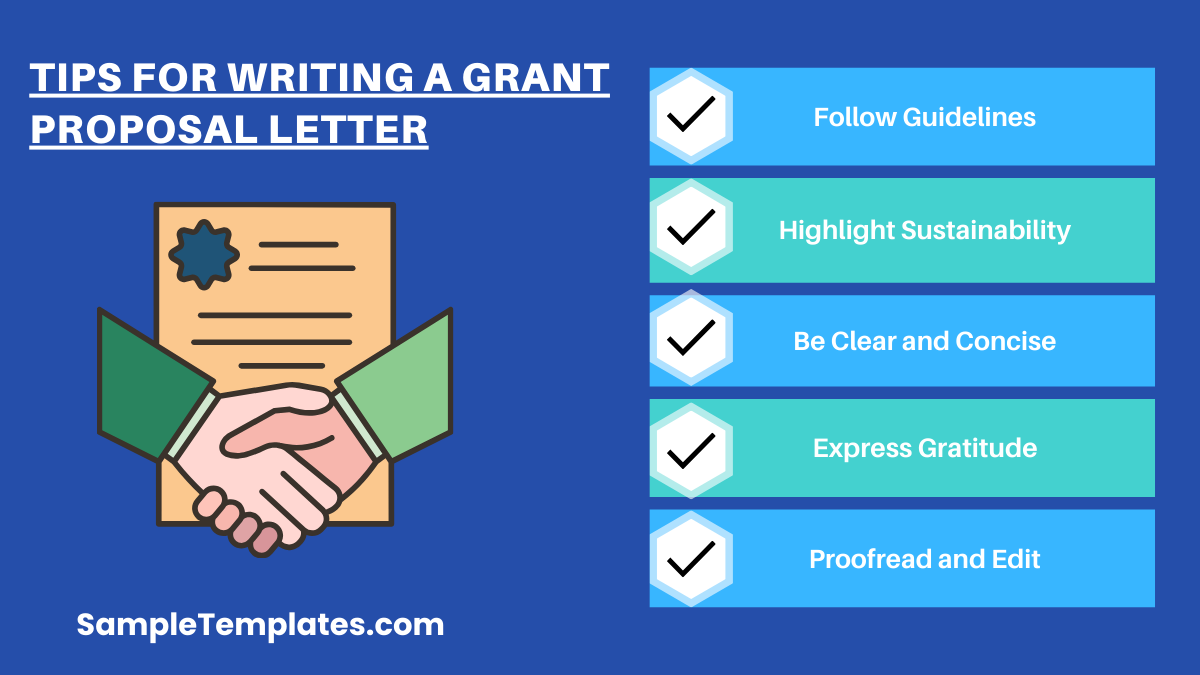
Writing a successful grant proposal letter format involves clear, concise, and persuasive communication. Here are some tips to help you craft an effective grant proposal letter:
1. Understand the Funder’s Priorities
- Research: Understand the funder’s mission, values, and funding priorities.
- Alignment: Ensure your project aligns with their interests and objectives.
2. Follow Guidelines
- Read Instructions: Carefully read and follow the funder’s guidelines and requirements.
- Format Correctly: Use the specified format, font size, and document length.
3. Start with a Strong Opening
- Engage the Reader: Begin with a compelling introduction that captures the reader’s attention.
- Clearly State Purpose: Clearly state the purpose of your proposal and the amount of funding you are requesting.
4. Be Clear and Concise
- Avoid Jargon: Use clear and simple language, avoiding unnecessary jargon.
- Be Direct: Get to the point quickly and avoid overly complex sentences.
5. Provide a Compelling Project Description
- Detailed Overview: Describe your project in detail, including objectives, activities, and timelines.
- Highlight Impact: Explain the potential impact of your project and how it addresses a specific need or problem.
6. Show Organizational Credibility
- Track Record: Highlight your organization’s history, successes, and capacity to manage the project.
- Expertise: Emphasize the qualifications and expertise of your team.
7. Include Measurable Goals and Objectives
- Specific Targets: Set clear, measurable goals and objectives for your project.
- Evaluation Plan: Explain how you will measure the success and impact of your project.
8. Provide a Detailed Budget
- Breakdown Costs: Provide a detailed budget that outlines how the funds will be used.
- Justify Expenses: Justify each expense and explain its necessity for the project’s success.
9. Highlight Sustainability
- Long-Term Impact: Explain how the project will sustain itself beyond the grant period.
- Future Funding: Mention any plans for securing additional funding if necessary.
10. Express Gratitude
- Thank the Funder: Express gratitude for the opportunity to apply and thank the funder for their consideration.
11. Proofread and Edit
- Check for Errors: Carefully proofread your letter for spelling and grammatical errors.
- Seek Feedback: Have someone else review your letter to provide feedback and catch any mistakes you may have missed.
12. Follow Up
- Acknowledge Receipt: Confirm receipt of your proposal with the funder.
- Be Patient: Allow time for the funder to review your proposal and be prepared to provide additional information if requested.
By following these tips, you can craft a compelling grant proposal letter that effectively communicates your project’s value and aligns with the funder’s priorities.
Sample Proposal Letter for Funding PDF

Funding Proposal Letter
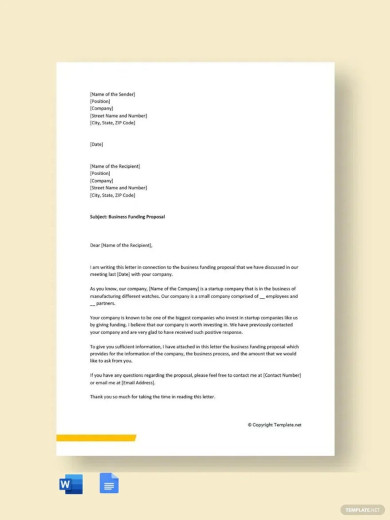
Sample Grant Letter Template
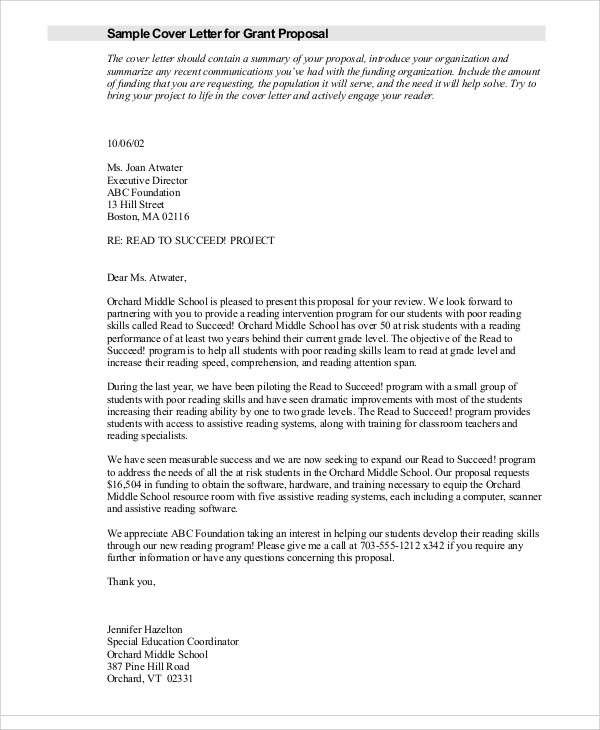
Size: 201 KB
Grant Proposal Recommendation Letter
The next paragraph will be the summary of your simple proposal . This part is the most important part of your letter as it is where you will explain the details of your proposed project. You will need to elaborate on the whos, whats, hows, when, and where of your project.
More importantly, you need to be able to clearly explain the “why.” Relate the purpose of your proposed project to the cause your organization upholds. Furthermore, state who the project will serve and benefit, and explain the possible solutions it will provide and how it will address certain concerns within the community.
You will then need to specify the amount you are requesting. It is important that you are realistic and straightforward in this part of the letter sample . Generate an estimation beforehand, and determine an amount that is capable of covering the possible expenses required to let your proposed project materialize.
Writing a good letter that can guarantee approval from a prospective benefactor is a matter of preparing the information you are going to include in the document beforehand. It helps to read through a Sample Proposal Letter ; you can use the sample as a reference for you to put together a convincing yet sincere letter.
Letter of Inquiry Sample for Grant Proposal
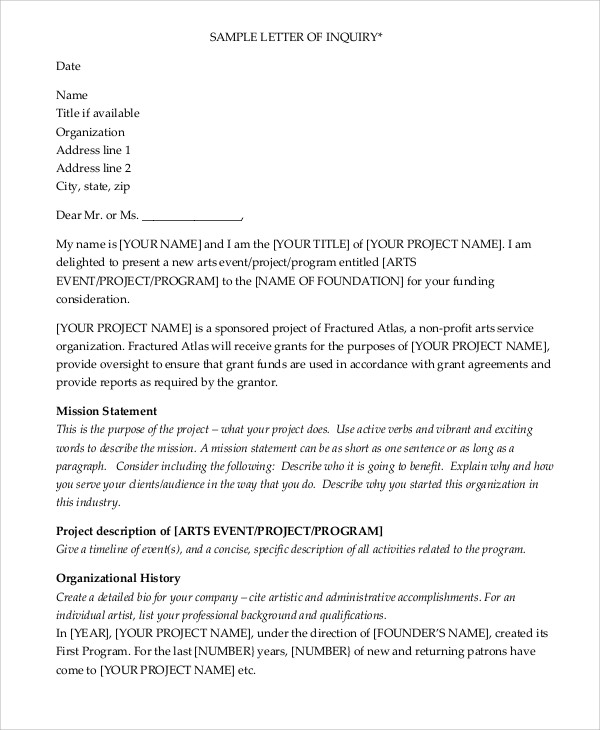
Size: 135 KB
How to Write a Grant Proposal?
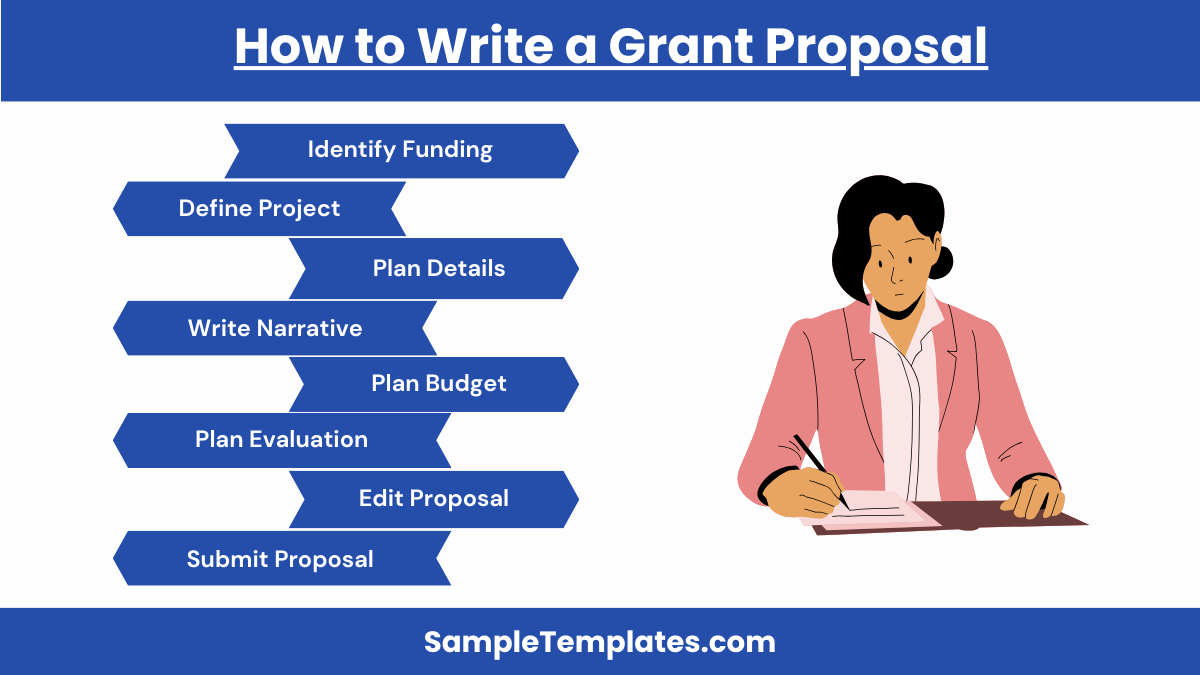
Writing a grant proposal is a structured process that involves several key steps. Here’s a general guideline on how to write a grant proposal:
1. Research and Identify Funding Opportunities:
- Identify potential grantors that align with your project’s goals and objectives.
- Review the grantor’s guidelines, criteria, and funding priorities.
2. Develop a Clear Project Idea:
- Define your project’s goals, objectives, and the problem it aims to address.
- Consider the project’s potential impact and how it aligns with the grantor’s mission.
3. Create a Detailed Project Plan:
- Outline the project’s methodology, including the steps and activities to achieve your objectives.
- Develop a realistic timeline for project implementation.
4. Draft a Compelling Narrative:
- Write an engaging executive summary to introduce your proposal.
- Craft a clear, concise, and persuasive narrative that addresses the problem, solution, and expected outcomes.
5. Budget Planning:
- Create a detailed budget that includes all project-related expenses.
- Clearly explain how the grant funds will be used to support the project.
6. Evaluation and Sustainability:
- Describe how you will measure the success of your project and track outcomes.
- Explain your plan for sustaining the project after the grant period.
7. Organizational Information:
- Provide information about your organization, its history, mission, and relevant experience.
- Highlight your organization’s capacity to successfully execute the project.
8. Attach Supporting Documents:
Include any necessary attachments, such as letters of support, resumes, or relevant research.
9. Review and Edit:
- Carefully proofread and edit your proposal to ensure clarity and coherence.
- Seek feedback from colleagues or mentors to improve the proposal.
10. Follow Grantor Guidelines:
Ensure that your proposal complies with the specific requirements and format outlined by the grantor.
11. Submit the Proposal:
Submit the proposal by the grantor’s deadline, using the specified submission method (e.g., online application or mailed hard copy).
After submission, follow up with the grantor if necessary, but be respectful of their process.
Remember that writing a successful grant proposal may require multiple drafts and revisions. Tailor each sample proposal to the unique requirements of the grantor, and make sure your proposal is well-researched, compelling, and well-organized. Additionally, allow ample time for preparation and submission to meet deadlines. Successful grant proposals can secure funding for valuable projects and initiatives.
Funding Proposal Letter Sample
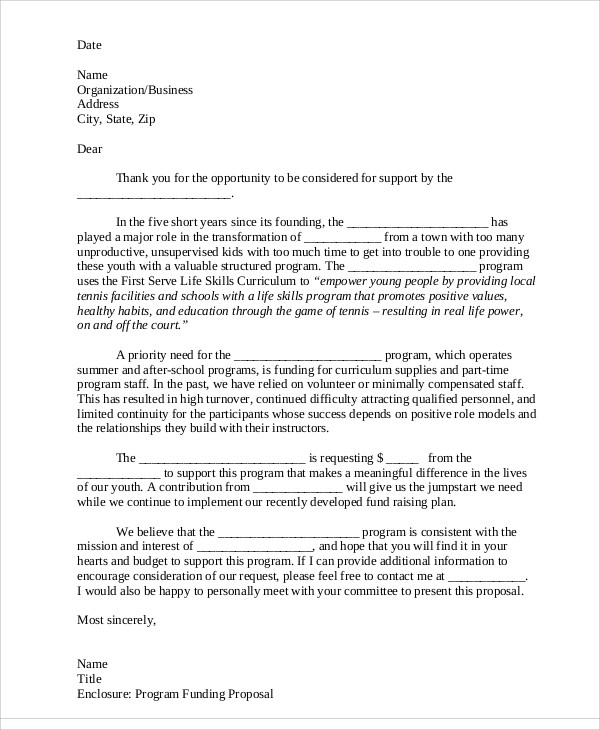
Size: 24 KB
Sample Letter of Inquiry for Grant Funding PDF
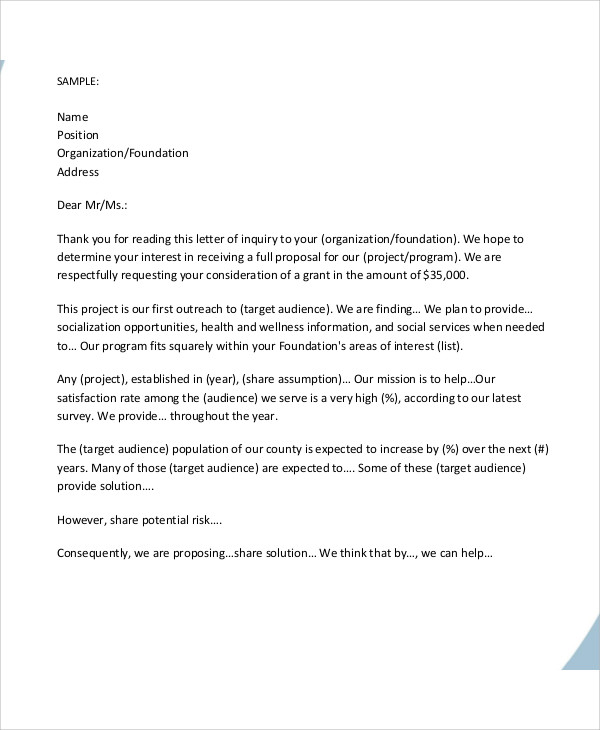
Size: 453 KB
Grant Proposal Cover Letter Template
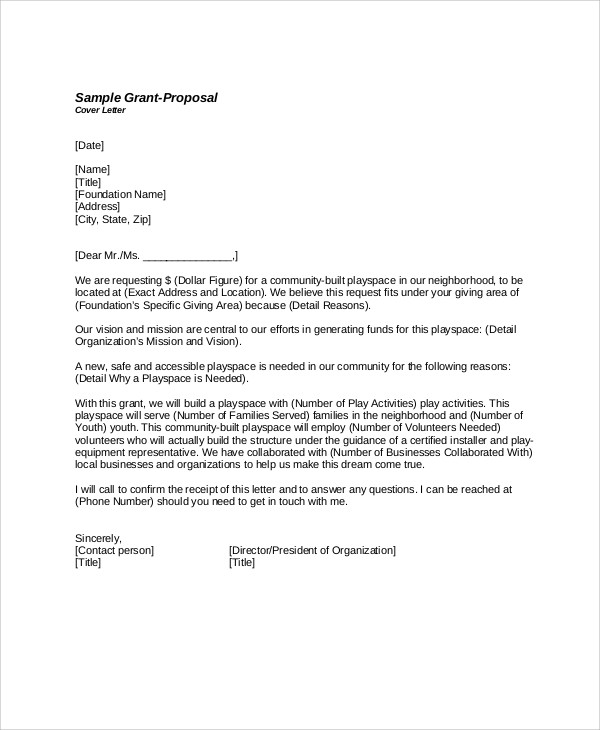
Turning a grant proposal into an actual activity begins with presenting the project through a letter. A request grant proposal letter contains several components. And for it to effectively persuade a prospective benefactor, one will need to be clear and comprehensive when writing it.
Like most formal letters, such as cover letters and the Rejection Letter Sample that can be found in another article, much thought must be put into writing a grant proposal letter . Moreover, one must be critical when it comes to choosing the information that will be stated in such a document.
The first part of the letter should be an introduction to your organization. It is where you will state the name of your organization, as well as the vision and mission you abide by. You will also need to mention the founder of your organization, and also the date when it was founded.
Elaborate on the values your organization wants to instill in the community, and the cause that keeps you going, thus leading to the proposal of a project that aims to benefit the community. Sounding “official” in this part of the letter is not necessary; however, it is vital that you are able to convey your sincerity.
Letter of Support for Grant Example
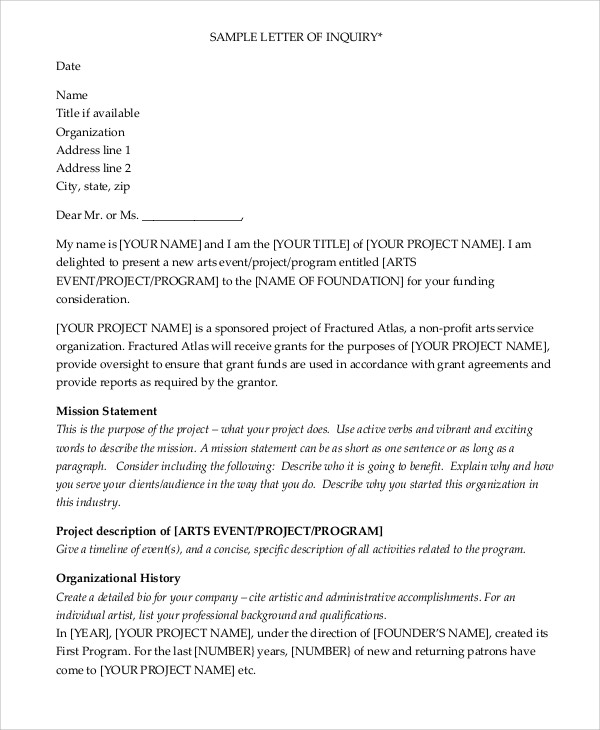
Grant Letter Format Template
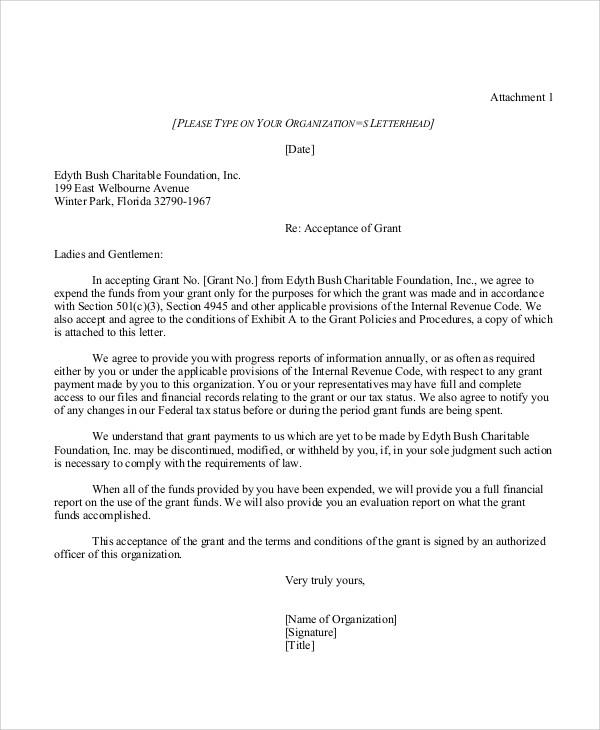
Size: 50 KB
What is the Grant Proposal Process?
- Identification of Need: Clearly define the problem or need that the grant aims to address.
- Research and Planning: Conduct thorough research to identify potential grant opportunities. Plan the project, detailing goals, objectives, and anticipated outcomes.
- Proposal Writing: Draft a comprehensive grant proposal, including a clear project description, budget, timeline, and measurable outcomes.
- Review and Editing: Review and edit the proposal for clarity, coherence, and alignment with the grant guidelines.
- Submission: Submit the grant proposal by the specified deadline, following the submission guidelines provided by the grantor.
- Follow-Up: After submission, follow up as necessary, addressing any inquiries or providing additional information requested by the grantor.
- Evaluation: Await the grantor’s evaluation process, which may involve reviews, interviews, or site visits.
- Notification: Receive and respond to the grantor’s decision, whether approval or rejection.
- Implementation: If successful, implement the proposed project according to the outlined plan.
- Reporting: Provide regular reports to the grantor, demonstrating progress and outcomes as specified in the grant agreement.
Understanding and following these steps can enhance the effectiveness of the grant proposal process, increasing the likelihood of securing funding for the proposed project.
Grant Proposal Letter Format
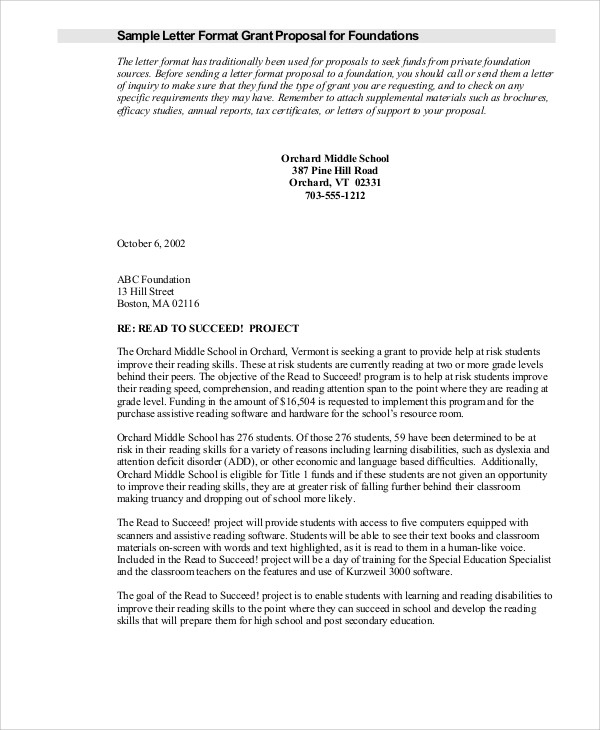
What is a grant proposal?
A grant proposal is a formal document submitted to a funding entity, outlining a project’s objectives, budget, and impact, aiming to secure financial support for initiatives in various fields.
What is a grant proposal cover letter?
A grant proposal cover letter introduces the organization, outlines the project’s purpose, and succinctly requests funding. It serves as a compelling introduction to the comprehensive grant proposal document.
Why write a grant proposal?
Writing a grant proposal is essential to secure funding for projects. It articulates the project’s goals, justifies the need, outlines a clear plan, and persuasively communicates how the funds will be utilized for positive impact.
What role do budgetary details play in a grant proposal letter?
Budgetary details in a grant proposal letter provide a clear financial roadmap, demonstrating how funds will be allocated. This transparency builds trust and enhances the proposal’s feasibility and accountability.
What is the primary purpose of a grant proposal letter?
The primary purpose of a grant proposal letter is to succinctly convey an organization’s mission, project details, and funding needs to persuade potential donors or granting agencies to provide financial support.
Related Posts
Sample thank you letters to teacher, sample college letter of intent, sample reference letter templates, sample affidavit of support letter templates, resignation letter with reason samples, sample college acceptance letter templates, sample friendly letter templates, letter of intent for employment samples, letter of support samples & templates, sample business meeting invitation letter templates, sponsorship letter templates, sample contract agreement letter templates, sample proposal request letter templates, sample document request letter templates, sample job appointment letter templates, sample formal apology letter templates, sample resignation letter for family reasons, samples of love letters to boyfriend, company resignation letters samples & templates.

- About Grants
- How To Apply - Application Guide
How to Apply - Application Guide
Use the application instructions found on this page along with the guidance in the funding opportunity to submit grant applications to NIH, the Centers for Disease Control and Prevention, the Food and Drug Administration, and the Agency for Healthcare Research and Quality.
Prepare to Apply
- Systems and Roles
- Find Grant Funding
- Understand Funding Opportunities
- Types of Applications
- Submission Options
- Obtain Software
Write Application
- Write Your Application
- How to Find Forms
- Develop Your Budget
- Format Attachments
- Rules for Text Fields
- Page Limits
- Data Tables
- Reference Letters
- Biosketches
- How to Submit, Track, and View
- How We Check for Completeness
- Changed/Corrected Applications
- Standard Due Dates
- Submission Policies
- Dealing with System Issues
| (Due dates ON/AFTER Jan. 25, 2023) | ||
|---|---|---|
| General Instructions | Comprehensive guidance for research, training, fellowship, career development, multi-project, and small business applications | / |
| Research Instructions | Guidance for research only Activity Codes: Research (R), including Research Education (R25), and equivalent Cooperative Agreements (U) | |
| Career Development Instructions | Guidance for career development only Activity Codes: Individual Career Development (K), excluding Institutional Career Development (K12, KL2, KM1) | |
| Training Instructions | Guidance for training only Activity Codes: Institutional Training (T), including International Training (D43, D71, U2R) and Institutional Career Development (K12, KL2, KM1) | |
| Fellowship Instructions | Guidance for fellowship only Activity codes: Fellowship (F) | |
| Multi-Project Instructions | Guidance for multi-project only Activity Codes: Program Project Grants and Center Grants (P) and equivalent Cooperative Agreements (U) | |
| SBIR/STTR Instructions | Guidance for small business only Activity Codes: R41-R44, SB1, U43, U44, UB1, UT1, UT2 | |

- Application Submission Presentations
- Tips for Success Video Series
- Annotated Form Sets
- Samples: Applications, Attachments, and other Documents
- Contacting NIH Staff
- Application Form Instruction Archive
This page last updated on: October 25, 2022
- Bookmark & Share
- E-mail Updates
- Privacy Notice
- Accessibility
- National Institutes of Health (NIH), 9000 Rockville Pike, Bethesda, Maryland 20892
- NIH... Turning Discovery Into Health
- Grades 6-12
- School Leaders
100 Last-Day-of-School Activities Your Students Will Love!
10 Strong Scholarship Recommendation Letter Examples
Help make college more affordable for your students.
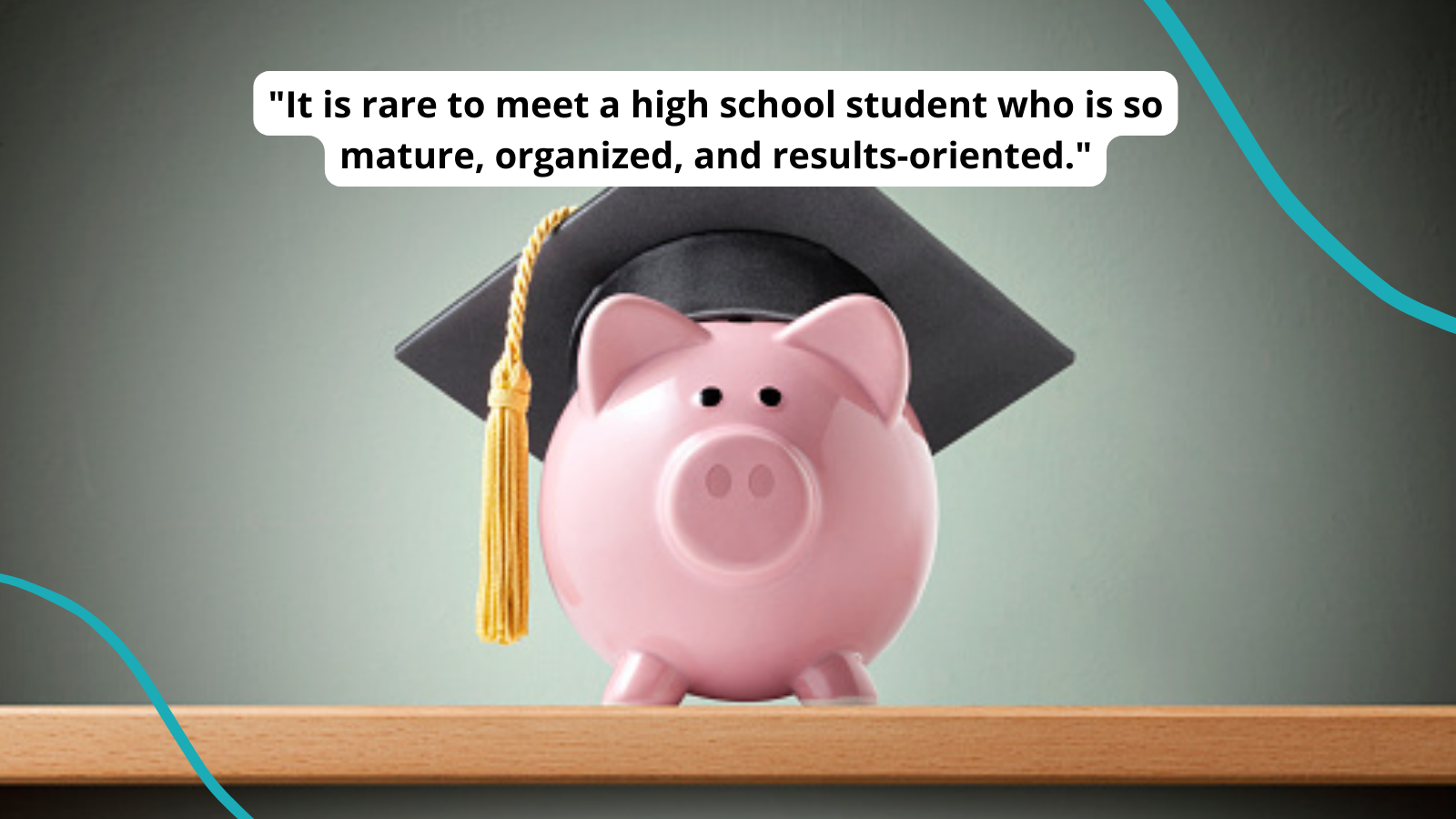
Paying for college takes a lot of planning. Tuition costs rise every year and graduates are buckling under the weight of debt from loans. For some, the expense of higher education is prohibitive, with many talented students being forced to cut their dreams short. Scholarships can make getting a degree more affordable. Students qualify based on academic performance, special interests, or financial needs. If you’ve been asked to help with the process, we’ve got you covered! Here’s a list of sample recommendation letters for scholarship applications that best meet your students’ needs.
How To Write Scholarship Recommendation Letters
If you’ve been asked to write a recommendation letter for your student’s scholarship, you might feel overwhelmed. You want to help your student, but you’re worried your letter won’t be good enough. In the end, you can only do your best, so lead with your heart and consider the following suggestions:
- Use letterhead and add your personal information (full name, title, school name, etc.) in the top left corner.
- Fill the whole page (at least 300 words) with an introduction, two or three paragraphs, and a conclusion.
- In the first paragraph, introduce your student, specify the scholarship for which they are applying, and share details about the nature and length of your relationship.
- In the body paragraphs, describe the ways your student is suitable and deserving of the scholarship.
- In your final section, pull everything together and emphasize your student’s strengths as well as the reasons why you are endorsing them.
Here’s a quick video on how to craft an effective scholarship recommendation letter:
Don’t feel you can honestly provide a positive recommendation? Gently decline their request for a letter. Avoid putting yourself in a position where you will have to be insincere. You don’t want to write something negative because it could cost the student an opportunity to earn a scholarship.
Sample Recommendation Letters for Scholarship Applications
1. general scholarship recommendation letter.
This is a great sample scholarship letter if you’re trying to offer a rounded view of a student’s performance in high school. You’ll include information about your experience with them as well as your thoughts on their potential success in a higher-education setting.
2. Sample Rhodes Scholarship letter
If your student is a candidate for a prestigious award such as the Rhodes Scholarship, this sample scholarship letter will give you an idea of what to share with the selection committee. With these types of recommendation letters, you want to provide as much praise and positive information as possible.
3. Scholarship letter for math students
There are many great scholarship opportunities for strong math students. This sample recommendation letter outlines how to share not only your student’s math talents but the other traits that make them a good candidate as well.
4. Leadership scholarship sample letter
This helpful scholarship recommendation letter offers an example for highlighting leadership skills. Back up your endorsement by sharing specific situations as well as participation in any committees, programs, and events where your student excelled.
5. Scholarship letter for international studies
Does your student plan to go abroad? If so, review this sample for writing a strong letter of recommendation for this specific type of scholarship. Be sure to include evidence as to why you believe your student is well rounded and exceptional.
6. Environmentalist scholarship letter
Has one of your students decided to pursue a degree in environmental sciences and wildlife? If so, this scholarship recommendation letter is a good example because it concisely highlights their strengths and shares why they would make a good candidate.
7. Scholarship letter for students who need financial assistance
No one should miss out on a college education because they can’t afford to pay. You can help them overcome this barrier! This excellent sample letter of recommendation shows the details to include for scholarships based on financial need.
8. Scholarship recommendation letter for STEM students
There are many scholarships for students who plan to pursue a career in STEM fields. If you’ve been asked to write a letter of recommendation for this type of scholarship, this sample will give you a good idea of what to include.
9. Greek society scholarship letter sample
Fraternities and sororities can be a great source of financial support for college and university students. Review this sample recommendation letter for scholarship applications for Greek society candidates.
10. Personal endorsement for scholarships
This sample recommendation letter for a scholarship application is best when you can’t vouch for the prospective student’s academic performance but want to share information about their personal character and how it relates to the scholarship program.
Do you have a great sample recommendation letter for scholarship applications? Please share it in the comments below!
Plus, check out the ultimate guide to college scholarships, want more articles like this be sure to subscribe to our newsletters ..
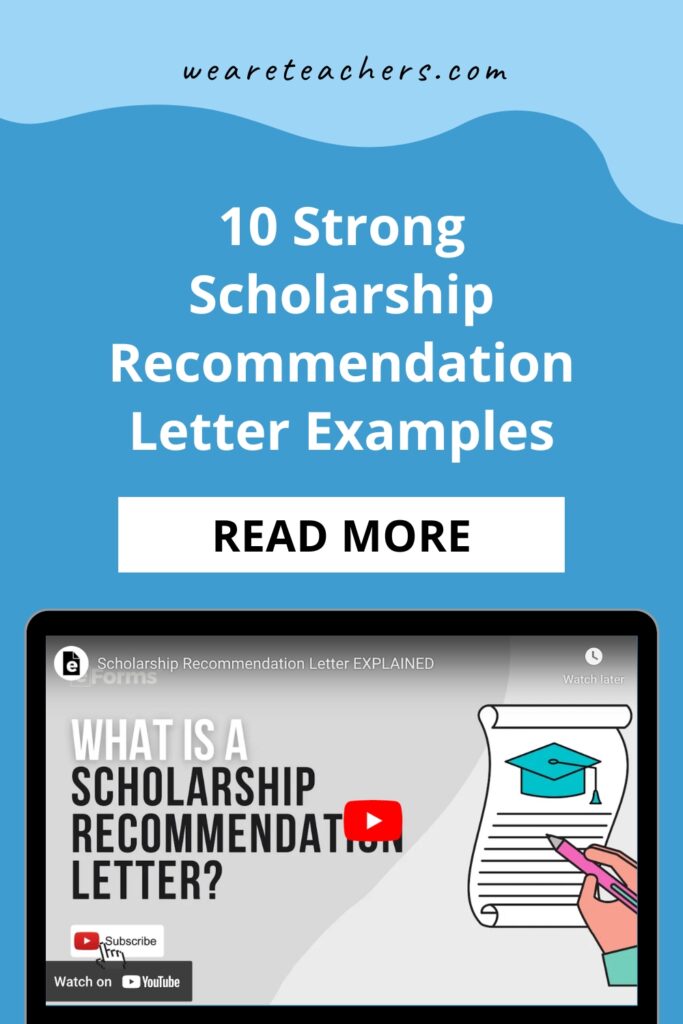
You Might Also Like
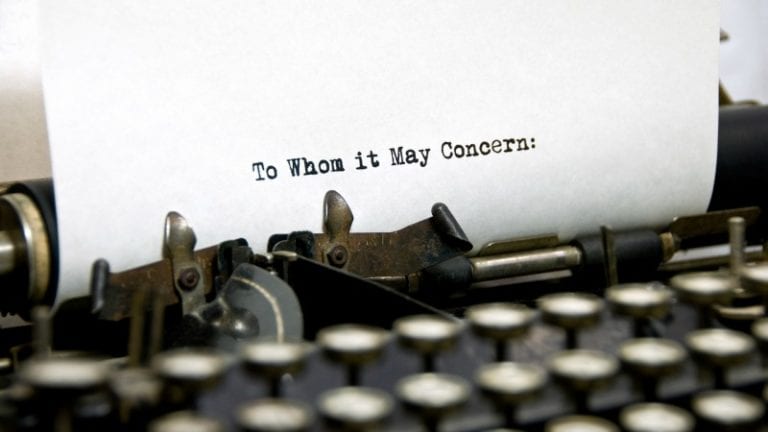
Tips for Writing a Genuine and Powerful College Recommendation Letter
Your words can make a big difference. Continue Reading
Copyright © 2024. All rights reserved. 5335 Gate Parkway, Jacksonville, FL 32256
An official website of the United States government.
Here’s how you know
The .gov means it’s official. Federal government websites often end in .gov or .mil. Before sharing sensitive information, make sure you’re on a federal government site.
The site is secure. The https:// ensures that you are connecting to the official website and that any information you provide is encrypted and transmitted securely.
- American Job Centers
- Apprenticeship
- Demonstration Grants
- Farmworkers
- Federal Bonding Program
- Foreign Labor Certification
- Indians and Native Americans
- Job Seekers
- Layoffs and Rapid Response
- National Dislocated Worker Grants
- Older Workers
- Skills Training Grants
- Trade Adjustment Assistance
- Unemployment Insurance
- Workforce Innovation and Opportunity Act (WIOA)
- WIOA Adult Program
- Advisories and Directives
- Regulations
- Labor Surplus Area
- Performance
- Recovery-Ready Workplace Resource Hub
- Research and Evaluation
- ETA News Releases
- Updates for Workforce Professionals
- Regional Offices
- Freedom of Information Act
- Office of Apprenticeship
- Office of Foreign Labor Certification
- Office of Grants Management
- Office of Job Corps
- Office of Unemployment Insurance (1-877-S-2JOBS)
The Tools of Apprenticeship.gov

Learn How to File for Unemployment Insurance

Employment Services
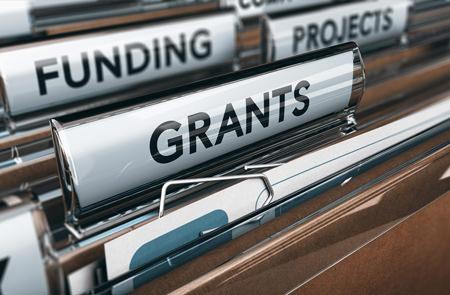
ETA Workforce Data Hub
Workforce tools, strategies and technical assistance.
June 13, 2024
Unemployment Insurance Weekly Claims Report
June 6, 2024
May 30, 2024
Welcome to Microsoft Forms!
- Create and share online surveys, quizzes, polls, and forms.
- Collect feedback, measure satisfaction, test knowledge, and more.
- Easily design your forms with various question types, themes, and branching logic.
- Analyze your results with built-in charts and reports, or export them to Excel for further analysis.
- Integrate Microsoft Forms with other Microsoft 365 apps, such as Teams, SharePoint, and OneDrive, so you can collaborate with others and access your forms from anywhere.
Explore templates
- Template gallery
- Community volunteer registration form
- Employee satisfaction survey
- Competitive analysis study
- Office facility request form
- Vacation and sick leave form
- Post-event feedback survey
- Holiday Party Invitation
Unfortunately we don't fully support your browser. If you have the option to, please upgrade to a newer version or use Mozilla Firefox , Microsoft Edge , Google Chrome , or Safari 14 or newer. If you are unable to, and need support, please send us your feedback .
We'd appreciate your feedback. Tell us what you think! opens in new tab/window
CRediT author statement
CRediT (Contributor Roles Taxonomy) was introduced with the intention of recognizing individual author contributions, reducing authorship disputes and facilitating collaboration. The idea came about following a 2012 collaborative workshop led by Harvard University and the Wellcome Trust, with input from researchers, the International Committee of Medical Journal Editors (ICMJE) and publishers, including Elsevier, represented by Cell Press.
CRediT offers authors the opportunity to share an accurate and detailed description of their diverse contributions to the published work.
The corresponding author is responsible for ensuring that the descriptions are accurate and agreed by all authors
The role(s) of all authors should be listed, using the relevant above categories
Authors may have contributed in multiple roles
CRediT in no way changes the journal’s criteria to qualify for authorship
CRediT statements should be provided during the submission process and will appear above the acknowledgment section of the published paper as shown further below.
Term | Definition |
|---|---|
Conceptualization | Ideas; formulation or evolution of overarching research goals and aims |
Methodology | Development or design of methodology; creation of models |
Software | Programming, software development; designing computer programs; implementation of the computer code and supporting algorithms; testing of existing code components |
Validation | Verification, whether as a part of the activity or separate, of the overall replication/ reproducibility of results/experiments and other research outputs |
Formal analysis | Application of statistical, mathematical, computational, or other formal techniques to analyze or synthesize study data |
Investigation | Conducting a research and investigation process, specifically performing the experiments, or data/evidence collection |
Resources | Provision of study materials, reagents, materials, patients, laboratory samples, animals, instrumentation, computing resources, or other analysis tools |
Data Curation | Management activities to annotate (produce metadata), scrub data and maintain research data (including software code, where it is necessary for interpreting the data itself) for initial use and later reuse |
Writing - Original Draft | Preparation, creation and/or presentation of the published work, specifically writing the initial draft (including substantive translation) |
Writing - Review & Editing | Preparation, creation and/or presentation of the published work by those from the original research group, specifically critical review, commentary or revision – including pre-or postpublication stages |
Visualization | Preparation, creation and/or presentation of the published work, specifically visualization/ data presentation |
Supervision | Oversight and leadership responsibility for the research activity planning and execution, including mentorship external to the core team |
Project administration | Management and coordination responsibility for the research activity planning and execution |
Funding acquisition | Acquisition of the financial support for the project leading to this publication |
*Reproduced from Brand et al. (2015), Learned Publishing 28(2), with permission of the authors.
Sample CRediT author statement
Zhang San: Conceptualization, Methodology, Software Priya Singh. : Data curation, Writing- Original draft preparation. Wang Wu : Visualization, Investigation. Jan Jansen : Supervision. : Ajay Kumar : Software, Validation.: Sun Qi: Writing- Reviewing and Editing,
Read more about CRediT here opens in new tab/window or check out this article from Authors' Updat e: CRediT where credit's due .

COMMENTS
How you compose your funding request letter or application could make or break your chances of getting a grant. Generally, you need to be professional, courteous, and convincing. Make sure your letter includes essential details such as your company's identity and your reasons for requesting funds. Remember, be clear and to the point.
If you're planning to write a cover letter for your grant proposal, here are some helpful steps you can follow: 1. Use a formal header. At the top of a grant proposal cover letter, most professionals choose to include a formal header. In this section, you can include elements such as: Your contact information.
The address of the funder should be placed at the top of the letter. Format the address as: contact name, title, funder name, address. Use a formal introduction in the salutation, such as "Dear Mr/Mrs.". The letter should be signed by an appropriate official from your organization, such as the Executive Director.
Download Grant Application Template. ... Cover Letter: Unless you have already had a face-to-face meeting or other contact with a funder, the cover letter is the first impression of your organization and project. Provide a brief summary that emphasizes your vision and objective.
1) Briefly introduce your organization. 2) Tell the funding corporation how much money you are requesting and state a good reason you need it. 3) Using a few lines, tell the reader what your organization does. 4) Include a research-based bullet point that indicates the society needs what your organization does.
General guidelines for writing funding applications. Always keep your project plan in mind. Don't get carried away and commit yourself to a project you won't be able to run even if it sounds better in the application. Write in plain English. Use short sentences and avoid acronyms and jargon.
All letters that request funding should contain the same basic information: Your contact information/the name of your organization. The date. The recipient's contact information, full name, and title (if applicable). A salutation. An introduction and relevant background information. The funding request, including the exact amount you're ...
A Grant Proposal Cover Letter is a formal document that provides information about a proposed project or mission. It is submitted to government agencies, foundations, or organizations that provide grants. The grant proposal cover letter is submitted with the grant proposal or application document. It provides vital information about the project, its background, purpose, and goals. The grant ...
A Grant Application Cover Letter is a formal document that accompanies a grant application, typically addressed to a potential grantor or a funding organization. This letter serves as an introduction to the grant proposal, providing a concise overview of the project or program for which funding is sought. It plays a critical role in making a ...
Arts Funding Grant Proposals: This proposal is another example of a comprehensive and well-written grant proposal. Read it here. Sample Youth Program Funding Proposals: Here are examples of William T Grant Scholars Proposals. Read them here. Here's a podcast for you on growing your grant potential, that you may find helpful:
Here are some tips on how to start a good cover letter for a grant: Use a formal header. Begin your cover letter with a professional header that includes your organization's name, address, phone number, and email. Address the funder personally. If possible, address the cover letter to a specific person by their name and title.
Here are some extra tips to help you write a grant proposal that stands out. Start early. Apply early and often. Get feedback and revise your proposal accordingly. Be brief, concise and clear. Be organized and logical. Be explicit and specific. Be realistic in designing the project. Follow up after the proposal.
Aside from this, the University of North Carolina Wilmington recommends that you should include the support goals and objectives inside your letter. Explain your purpose for your proposal submission. 4. Be polite and humble. You should be polite and humble when writing your grant application letter format.
Formatting Your Cover Letter. Use your organization's letterhead. Put the same date on the cover letter that is on the completed grant application. That is the date you will send the grant proposal to the grantor. Using the same date makes all the documents in your proposal package consistent. For the inside address (goes at the top of the ...
Clearly state the purpose of the letter - to request funding for your project. Describe Your Project: Provide a clear and concise description of your project. Explain what it is, its objectives, and why it's important. Explain the Need for Funding: Articulate why you need the funding and how it will contribute to the success of your project.
How to Write a Grant Proposal Cover Letter. First of all, an average grant proposal letter shouldn't be more than one page long. Cover letters are the pitch of your detailed grant proposal. Think of it as a summary of your book. Before writing the first paragraph, you should open the letter with the contact's name, title, address, and other ...
Cover letters. This is the most important part of your grant proposal: the cover letter. Think of a cover letter as a compelling introduction to the contents of your full proposal. It's your first chance to connect your project with the funder's philanthropic mission. At minimum, your cover letter should include: An introduction to your ...
Sample 1: For Community Development Project. Dear [Grant Provider's Name/Organization], I am writing to request funding for a community development project spearheaded by [Your Organization's Name]. Our project, titled [Project Name], aims to [briefly describe the project's goal, such as improving local infrastructure, providing community ...
Santa Fe, New Mexico 12345. [email protected]. 555-555-5555. With these tips & cover letter grant proposal sample, you should be well on your way towards writing a strong cover letter for grant proposals. For even more information on how to get a small business grant, check out our guide. If you are looking for more guidance on how ...
Cover Letter Template [MM/DD/YYYY] [Recipient Name] [Recipient Title] [Funding Organization Name] [Funding Organization Address] [Salutation] [Body Text] Begin with a few sentences introducing yourself, your organization, and the communities you serve. Express your appreciation for the recipient's time spent reviewing the proposal.
Download our FREE Grant Application Template bundle, which includes: A cover letter template; A grant proposal template; ... Depending on your grant application, the cover letter may not be necessary. However, if your grant writing involves a cover letter, it should typically be one page in length and written on your nonprofit's official ...
Nonprofit Grant Proposal Letter. Dear Mr. Green, I am writing on behalf of the Community Enrichment Center (CEC) to request a grant of $50,000 from the Greenwood Foundation to support our Youth Empowerment Program, aimed at providing educational and vocational training for underserved teenagers in the Boston area.
Sample Grant Process Documents. For your convenience and reference, below are samples of every step of our grants process. These documents are reflective of the 2021 grants process, and may be slightly adjusted in future years; updated versions will be replaced here as often as possible. All grant requests must still be submitted via our online ...
How to Apply - Application Guide Use the application instructions found on this page along with the guidance in the funding opportunity to submit grant applications to NIH, the Centers for Disease Control and Prevention, the Food and Drug Administration, and the Agency for Healthcare Research and Quality.
General scholarship recommendation letter. This is a great sample scholarship letter if you're trying to offer a rounded view of a student's performance in high school. You'll include information about your experience with them as well as your thoughts on their potential success in a higher-education setting. 2. Sample Rhodes Scholarship ...
Learn about the Employment and Training Administration, a federal agency that provides job training and apprenticeship programs for workers and employers.
Other Forms on File. To apply for NRCS conservation programs, you'll have to have a few other forms on file to ensure you have a farm number, you are in conservation compliance, and you meet other eligibility requirements.Learn more on our Common Forms webpage.Most of these forms are filed with USDA's Farm Service Agency (FSA), which is often co-located with your NRCS local office.
Microsoft Forms is a web-based application that allows you to: Create and share online surveys, quizzes, polls, and forms. Collect feedback, measure satisfaction, test knowledge, and more. Easily design your forms with various question types, themes, and branching logic.
Sample Application Letter for a Job—First Paragraph Good Example. I am excited to apply for the UX researcher position at Hewlett-Packard. As a UX researcher with over six years of experience in the field, I am confident that my expertise and passion for user-centered design make me an excellent candidate for this role. In my previous ...
Application of statistical, mathematical, computational, or other formal techniques to analyze or synthesize study data ... Funding acquisition. Acquisition of the financial support for the project leading to this publication *Reproduced from Brand et al. (2015), Learned Publishing 28(2), with permission of the authors. Sample CRediT author ...